
漢德百科全書 | 汉德百科全书
 欧洲流行歌曲大赛
欧洲流行歌曲大赛

 建筑艺术
建筑艺术
 英格兰
英格兰
 欧洲流行歌曲大赛
欧洲流行歌曲大赛

 财政金融
财政金融
 ***全球金融中心
***全球金融中心
 欧洲足球锦标赛 2020
欧洲足球锦标赛 2020

 历史
历史
 公元 2000 - 2100
公元 2000 - 2100

 历史
历史
 公元 1500 - 2000
公元 1500 - 2000

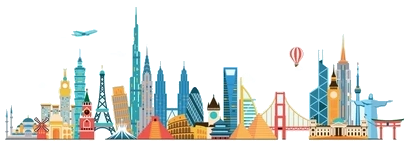 国际城市
国际城市
 ***全球城市经济竞争力
***全球城市经济竞争力
 国际铁人三项联盟冠军系列赛
国际铁人三项联盟冠军系列赛

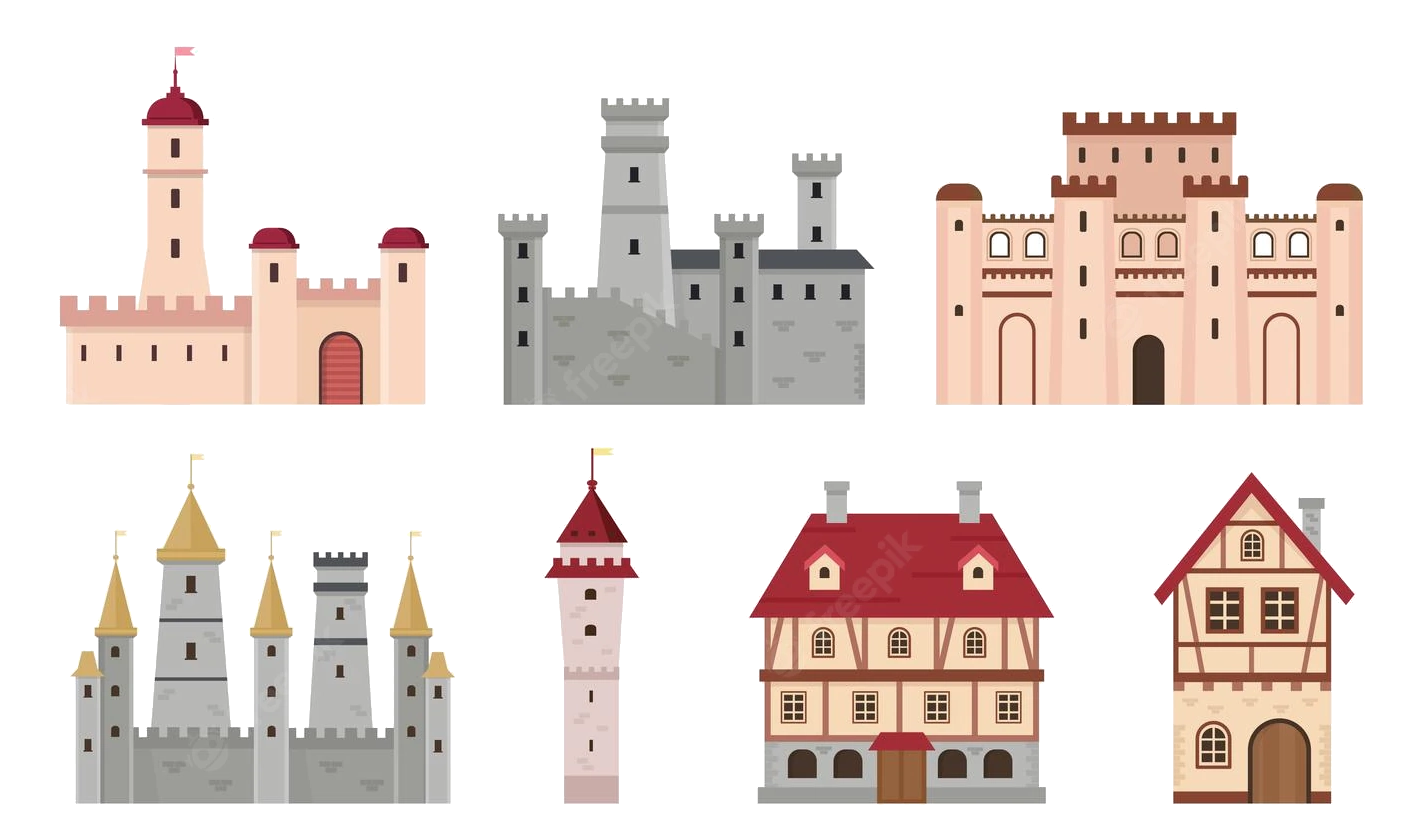 欧洲中世纪城市
欧洲中世纪城市
 夏季奥林匹克运动会
夏季奥林匹克运动会
 1908夏季奥林匹克运动会
1908夏季奥林匹克运动会
 1944夏季奥林匹克运动会
1944夏季奥林匹克运动会
 1948夏季奥林匹克运动会
1948夏季奥林匹克运动会
 2012夏季奥林匹克运动会
2012夏季奥林匹克运动会
 丝绸之路
丝绸之路

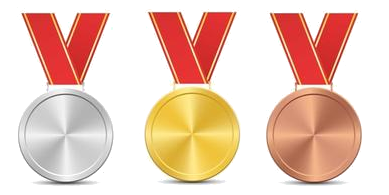 体育
体育
 铁人三项
铁人三项
 英国
英国

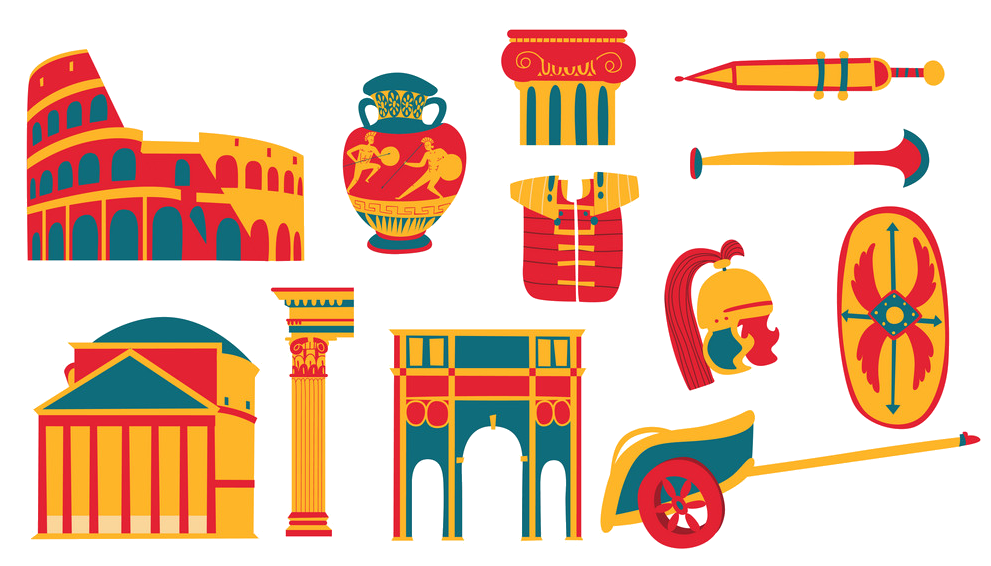 罗马人建立的城市
罗马人建立的城市

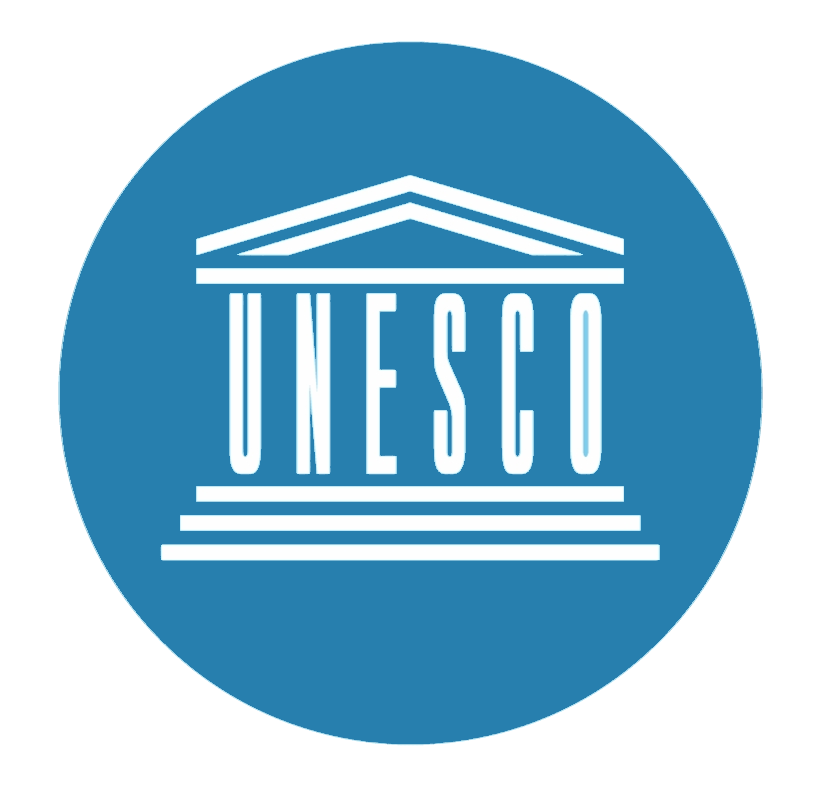 文化遗产
文化遗产

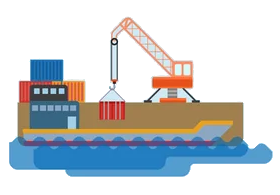 重要港口
重要港口

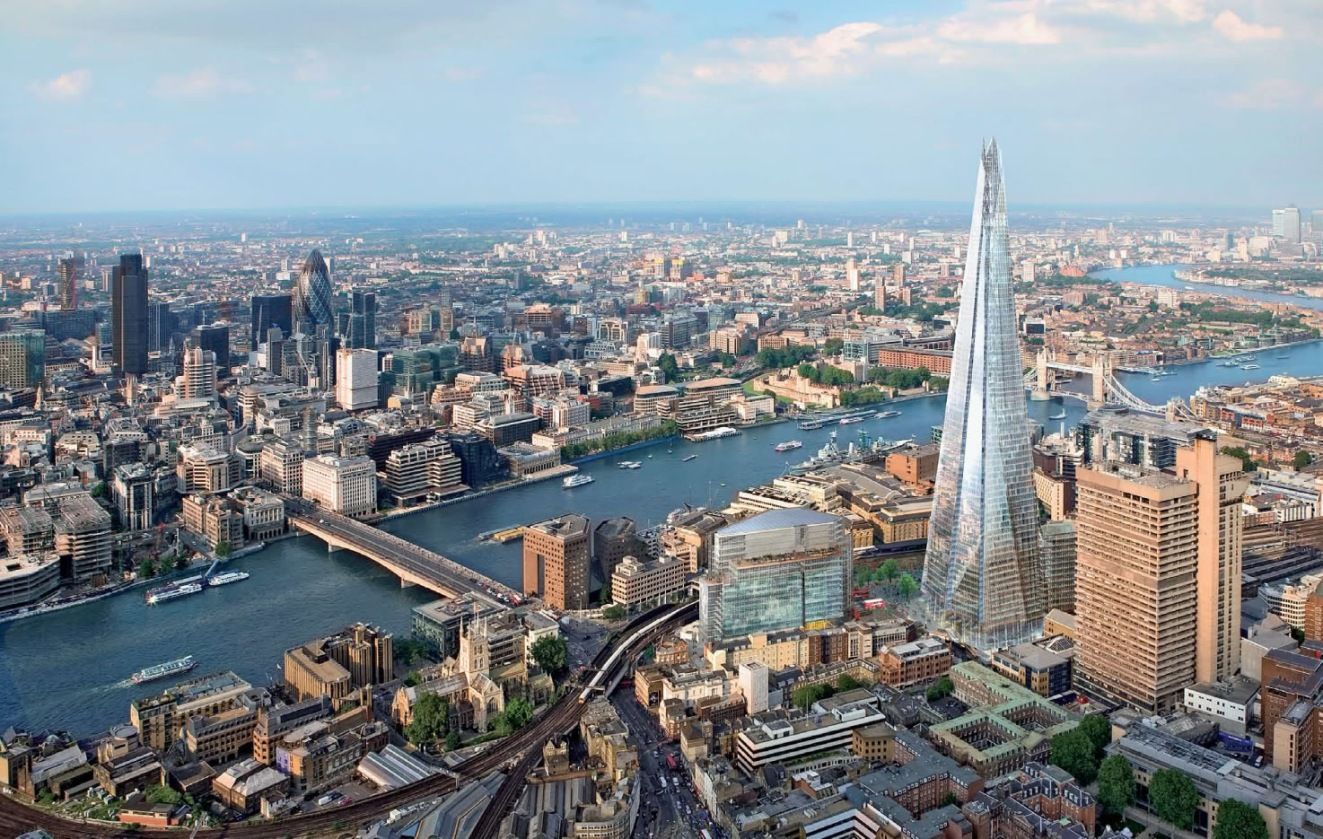
London (deutsche Aussprache [ˈlɔndɔn] oder gelegentlich [ˈlɔndən], englische Aussprache [ˈlʌndən]) ist zugleich die Hauptstadt des Vereinigten Königreiches und Englands. Die Stadt liegt an der Themse in Südostengland. Das heutige Verwaltungsgebiet mit 33 Stadtbezirken entstand im Jahr 1965 durch die Gründung von Greater London. Dort lebten 2022 rund 8,9 Millionen Menschen, davon rund 3,4 Millionen in den 13 Stadtbezirken Inner Londons.[2][4] In der gesamten Metropolregion London lebten 2019 knapp 14,4 Millionen Einwohner.[5]
Im Jahr 50 n. Chr. von den Römern als Londinium gegründet, wurde die Stadt nach der normannischen Eroberung 1066 Hauptstadt und Königssitz des Königreiches England. Bereits im Mittelalter entwickelte sich die Stadt zu einem bedeutenden internationalen Handelsplatz. Unter der Herrschaft von Elisabeth I. stieg ihre Bedeutung als Hafenstadt der Nordsee. Durch den Beginn der Industrialisierung im 18. Jahrhundert wuchs auch die Bevölkerung Londons, sodass es um 1800 eine der ersten Städte war, die mehr als eine Million Einwohner zählte. Bis 1900 versechsfachte sich die Bevölkerung, und London war bis zum Jahr 1925 die größte Stadt der Welt. Es entwickelte sich zu einem bedeutenden Zentrum der Technik und Industrie und wird bis heute zu den Weltstädten gerechnet.
London ist eines der bedeutendsten Kultur- und Handelszentren der Welt mit zahlreichen Universitäten, Hochschulen, Theatern und Museen. Mit einem BIP von 801,66 Mrd. € im Jahr 2017 ist London die größte städtische Wirtschaft Europas.[6] Die Stadt zählt außerdem neben New York City, Singapur und Hongkong zu den größten Finanzplätzen der Welt.[7] Historische Gebäude wie der Palace of Westminster oder Tower of London zählen zum UNESCO-Weltkulturerbe. Mit jährlich über 19 Millionen Touristen aus dem Ausland war London im Jahr 2016 nach Bangkok weltweit die zweitmeistbesuchte Stadt vor Paris.[8][9]
伦敦(英语:London;![]() i/ˈlʌndən/)[4]是英国首都,也是英国最大城市[5]以及其构成国英格兰的首府。位于泰晤士河流域,于公元50年由罗马人建立,取名为伦蒂尼恩,在此后两个世纪内为这一地区最重要的定居点之一[6]。伦敦的历史核心区——伦敦城仍旧维持其中世纪的界限,面积606.95平方英里(1,572.0平方千米),2019年人口为898.2万,为全英格兰最大的城市。自19世纪起,“伦敦”一称亦用于指称围绕这一核心区开发的周围地带[7]。这一城区集合自1965年起构成大伦敦行政区,由32个伦敦自治市加上伦敦城组成[8][9],由伦敦市长及伦敦议会管辖。[10][注 1]
i/ˈlʌndən/)[4]是英国首都,也是英国最大城市[5]以及其构成国英格兰的首府。位于泰晤士河流域,于公元50年由罗马人建立,取名为伦蒂尼恩,在此后两个世纪内为这一地区最重要的定居点之一[6]。伦敦的历史核心区——伦敦城仍旧维持其中世纪的界限,面积606.95平方英里(1,572.0平方千米),2019年人口为898.2万,为全英格兰最大的城市。自19世纪起,“伦敦”一称亦用于指称围绕这一核心区开发的周围地带[7]。这一城区集合自1965年起构成大伦敦行政区,由32个伦敦自治市加上伦敦城组成[8][9],由伦敦市长及伦敦议会管辖。[10][注 1]
伦敦亦是一个全球城市[11][12],[13]在文艺、商业、教育、娱乐、时尚、金融、健康、媒体、专业服务、研究与开发、旅游和交通方面都具有显著的地位[14][15][16][17],同时还是全球主要金融中心之一[18][19][20],根据计算,为全球国内生产总值第六大的都市区[注 2][21][22]。伦敦亦是全球文化首都之一[23][24][25][26],还是全球国际访客数量最多的城市[27],根据客流量计算则拥有全球最为繁忙的城市机场系统[28]。伦敦是全球领先投资地[29],吸引很多国际零售商来投资[30],个人净资产值高于其它城市[31]。伦敦拥有43所大学,其高等教育机构密集度在全欧洲最高[32]。2012年,伦敦成为史上首座三次举办现代夏季奥林匹克运动会的城市。[33]
伦敦的人口和文化十分多样,在大伦敦地区内使用的语言就超过300种[34]。这一区域2015年的官方统计人口为8,673,713[35],人口占全英国的12.5%[36]。在2020年英国脱离欧盟之前,伦敦的城市区为欧盟第二大,根据2011年普查其人口达到9,787,426,仅次于巴黎[37]。其都市区为欧洲最大,人口达13,614,409[注 3][38],而大伦敦政府则称伦敦都市区的总人口为2,100万[39]。1831年—1925年间,伦敦为世界最大的城市。[40]
有四项世界遗产位于伦敦,分别为:伦敦塔;邱园;威斯敏斯特宫、威斯敏斯特教堂和圣玛格丽特教堂;以及格林尼治历史区(其中的皇家天文台为本初子午线、0°经线和格林尼治标准时间所经之地)[41]。其他著名景点包括白金汉宫、伦敦眼、皮卡迪利圆环、圣保罗座堂、伦敦塔桥、特拉法加广场和碎片大厦。伦敦亦是诸多博物馆、画廊、图书馆、体育运动及其他文化机构的所在地,包括大英博物馆、国家美术馆、泰特现代艺术馆、大英图书馆以及40家西区剧院[42]。伦敦地铁是全球最古老的地下铁路网络。
ロンドン(英語: London [ˈlʌndən] (![]() 音声ファイル))はグレートブリテンおよび北アイルランド連合王国およびこれを構成するイングランドの首都。イギリスやヨーロッパ域内で最大の都市圏を形成している。ロンドンはテムズ川河畔に位置し、2,000年前のローマ帝国によるロンディニウム創建が都市の起源である[4]。ロンディニウム当時の街の中心部は、現在のシティ・オブ・ロンドン(シティ)に当たる地域にあった。シティの市街壁内の面積は約1平方マイルあり、中世以来その範囲はほぼ変わっていない。少なくとも19世紀以降、「ロンドン」の名称はシティの市街壁を越えて開発が進んだシティ周辺地域をも含めて用いられている[5]。ロンドンは市街地の大部分はコナベーションにより形成されている[6]。ロンドンを管轄するリージョンであるグレーター・ロンドンでは[7]、選挙で選出されたロンドン市長とロンドン議会により統治が行われている[8]。
音声ファイル))はグレートブリテンおよび北アイルランド連合王国およびこれを構成するイングランドの首都。イギリスやヨーロッパ域内で最大の都市圏を形成している。ロンドンはテムズ川河畔に位置し、2,000年前のローマ帝国によるロンディニウム創建が都市の起源である[4]。ロンディニウム当時の街の中心部は、現在のシティ・オブ・ロンドン(シティ)に当たる地域にあった。シティの市街壁内の面積は約1平方マイルあり、中世以来その範囲はほぼ変わっていない。少なくとも19世紀以降、「ロンドン」の名称はシティの市街壁を越えて開発が進んだシティ周辺地域をも含めて用いられている[5]。ロンドンは市街地の大部分はコナベーションにより形成されている[6]。ロンドンを管轄するリージョンであるグレーター・ロンドンでは[7]、選挙で選出されたロンドン市長とロンドン議会により統治が行われている[8]。
ロンドンは屈指の世界都市として、芸術、商業、教育、娯楽、ファッション、金融、ヘルスケア、メディア、専門サービス、調査開発、観光、交通といった広範囲にわたる分野において強い影響力がある[9]。また、ニューヨークと並び世界をリードする金融センターでもあり[10][11][12]、2009年時点の域内総生産は世界第5位で、欧州域内では最大である[13]。世界的な文化の中心でもある[14][15][16][17]。ロンドンは世界で最も来訪者の多い都市であり[18]、単一の都市圏としては世界で最も航空旅客数が多い[19]。欧州では最も高等教育機関が集積する都市であり、ロンドンには大学が43校ある[20]。2012年のロンドンオリンピック開催に伴い、1908年、1948年に次ぐ3度目のオリンピック開催となり、同一都市としては史上最多となる[21]。
ロンドンは文化的な多様性があり、300以上の言語が使われている[22]。2011年3月時点のロンドンの公式の人口は817万4,100人であり、欧州の市域人口では最大で[23][24]、イギリス国内の全人口の12.7%を占めている[25]。グレーター・ロンドンの都市的地域は、パリの都市的地域に次いで欧州域内で第2位となる8,278,251人の人口を有し[26]、ロンドンの都市圏の人口は1200万人[27]から1400万人[28]に達し、欧州域内では最大である。ロンドンは1831年から1925年にかけて、世界最大の人口を擁する都市であった[29]。2012年にマスターカードが公表した統計によると、ロンドンは世界で最も外国人旅行者が訪れる都市である[30]。
イギリスの首都とされているが、他国の多くの首都と同様、ロンドンの首都としての地位を明示した文書は存在しない[31]。
London (/ˈlʌndən/ ( listen) LUN-dən) is the capital and most populous city of England and the United Kingdom.[8][9] Standing on the River Thames in the south east of the island of Great Britain, London has been a major settlement for two millennia. It was founded by the Romans, who named it Londinium.[10] London's ancient core, the City of London, largely retains its 1.12-square-mile (2.9 km2) medieval boundaries. Since at least the 19th century, "London" has also referred to the metropolis around this core, historically split between Middlesex, Essex, Surrey, Kent and Hertfordshire,[11][12][13] which today largely makes up Greater London,[14][15][note 1] a region governed by the Mayor of London and the London Assembly.[16][note 2][17]
listen) LUN-dən) is the capital and most populous city of England and the United Kingdom.[8][9] Standing on the River Thames in the south east of the island of Great Britain, London has been a major settlement for two millennia. It was founded by the Romans, who named it Londinium.[10] London's ancient core, the City of London, largely retains its 1.12-square-mile (2.9 km2) medieval boundaries. Since at least the 19th century, "London" has also referred to the metropolis around this core, historically split between Middlesex, Essex, Surrey, Kent and Hertfordshire,[11][12][13] which today largely makes up Greater London,[14][15][note 1] a region governed by the Mayor of London and the London Assembly.[16][note 2][17]
London is one of the leading global cities[18][19] in the arts, commerce, education, entertainment, fashion, finance, healthcare, media, professional services, research and development, tourism and transportation.[20][21][22] It is the world's largest financial centre[23][24][25][26] and has the fifth or sixth largest metropolitan area GDP in the world.[note 3][27][28] London is often regarded as a world cultural capital.[29][30][31] It is the world's most-visited city as measured by international arrivals[32] and has the world's largest city airport system measured by passenger traffic.[33] It is the world's leading investment destination,[34][35][36][37] hosting more international retailers[38][39] and ultra high-net-worth individuals[40][41] than any other city. London's universities form the largest concentration of higher education institutes in Europe.[42] In 2012, London became the first city to have hosted the modern Summer Olympic Games three times.[43]
London has a diverse range of people and cultures, and more than 300 languages are spoken in the region.[44] Its estimated mid-2016 municipal population (corresponding to Greater London) was 8,787,892,[4] the largest of any city in the European Union[45] and accounting for 13.4% of the UK population.[46] London's urban area is the second most populous in the EU, after Paris, with 9,787,426 inhabitants at the 2011 census.[47] The city's metropolitan area is the most populous in the EU with 14,040,163 inhabitants in 2016,[note 4][3] while the Greater London Authority states the population of the city-region (covering a large part of the south east) as 22.7 million.[48][49] London was the world's most populous city from around 1831 to 1925.[50]
London contains four World Heritage Sites: the Tower of London; Kew Gardens; the site comprising the Palace of Westminster, Westminster Abbey, and St Margaret's Church; and the historic settlement of Greenwich (in which the Royal Observatory, Greenwich defines the Prime Meridian, 0° longitude, and GMT).[51] Other landmarks include Buckingham Palace, the London Eye, Piccadilly Circus, St Paul's Cathedral, Tower Bridge, Trafalgar Square and The Shard. London is home to numerous museums, galleries, libraries, sporting events and other cultural institutions, including the British Museum, National Gallery, Natural History Museum, Tate Modern, British Library and West End theatres.[52] The London Underground is the oldest underground railway network in the world.
Londres (prononcé [lɔ̃dʁ] ; en anglais London [ˈlʌn.dən]), située dans le Sud-Est de la Grande-Bretagne, est la capitale et la plus grande ville de l'Angleterre et du Royaume-Uni. Longtemps capitale de l'Empire britannique, elle est désormais le siège du Commonwealth of Nations.
Fondée il y a presque 2 000 ans par les Romains sous le nom de Londinium, Londres était au XIXe siècle la ville la plus peuplée du monde. Bien que largement dépassée dans ce domaine par de nombreuses mégapoles, elle reste une métropole de tout premier plan1, en raison de son rayonnement et de sa puissance économique, dû notamment à sa place de premier centre financier mondial2. Londres se place dans la triade des grands centres financiers du monde, avec New York et Hong Kong, en étant la principale place bancaire et financière d'Europe. Cette trilogie est appelée par les médias anglophones « Nylonkong »3.
La région de Londres, composée de l'Inner London et de l'Outer London, comptait environ 8 673 000 habitants en 2015 et réalise un cinquième du produit intérieur brut du Royaume-Uni4. En 2015, l'aire urbaine de Londres comptait 9 787 426 habitants et son aire métropolitaine 12 317 800 habitants. En Europe, seules les agglomérations de Moscou, Istanbul et Paris5 ont un poids démographique comparable. Ses habitants s'appellent les Londoniens (en anglais : Londoners).
Londres, la seule ville du monde à ce jour à avoir organisé trois fois les Jeux olympiques (1908, 1948, 2012), est dynamique et très diverse sur le plan culturel. Elle joue un rôle important dans l'art et dans la mode. Elle reçoit 28 millions de touristes par an et compte quatre sites inscrits au patrimoine mondial ainsi que de nombreux monuments emblématiques : le palais de Westminster, le Tower Bridge, la tour de Londres, l'abbaye de Westminster, le palais de Buckingham, Big Ben ainsi que des institutions renommées comme le British Museum ou la National Gallery.
Londra (AFI: [ˈlondra];[2] in inglese britannico: London, [ˈlʌndən][3]) è la capitale e maggiore città dell'Inghilterra e del Regno Unito, con i suoi 8 825 000 abitanti.
La sua estensione territoriale la rende la terza città più estesa d'Europa, preceduta da Mosca e Istanbul e seguita da Roma e Berlino. L'area metropolitana conta infatti circa 14 milioni di residenti e si estende per svariate decine di chilometri lungo la valle del Tamigi, fino al suo enorme estuario. Molti degli abitanti, chiamati londinesi (Londoners), provengono dall'estero o sono di origine straniera, risultando così una delle città più cosmopolite e multietniche del mondo. Londra è stata la capitale indiscussa dell'Impero britannico e, quindi, meta di flussi migratori durante e soprattutto dopo la fine dell'era coloniale.
Ha il più elevato PIL fra tutte le città europee, ed il quinto al mondo.[4] I suoi sei aeroporti internazionali ne fanno il più grande snodo del traffico aereo globale; è anche sede del più antico sistema di metropolitana del mondo, la London Underground (The Tube). È la seconda città più visitata al mondo dal turismo internazionale, dopo Bangkok in Asia.[5]
A Londra hanno sede numerose istituzioni, organizzazioni e società internazionali. Vi si trovano importanti musei, teatri e sale da concerto; la città contiene quattro patrimoni dell'umanità. Inoltre, vi risiede stabilmente il monarca del Regno Unito presso Buckingham Palace ed il parlamento; il primo ministro occupa l'abitazione al 10 Downing Street. Per tutte le caratteristiche elencate, Londra conquista il titolo di Città globale, classificandosi come l'unica città britannica nella lista delle Città Mondiali Alfa[6].
Dal 2000, con le riforme volute dal governo di Tony Blair, Londra è amministrata secondo una speciale legislazione sui generis[7] che determina e coordina i poteri della superiore Autorità della Grande Londra, composta dal Sindaco e dall'Assemblea di Londra, con quelli di 33 borghi londinesi a livello inferiore.[8
Londres (London en inglés,  ˈlʌndən (?·i)) es la capital y mayor ciudad de Inglaterra y del Reino Unido.23 Situada a orillas del río Támesis, Londres es un importante asentamiento humano desde que fue fundada por los romanos con el nombre de Londinium hace casi dos milenios.4 El núcleo antiguo de la urbe, la City de Londres, conserva básicamente su perímetro medieval de una milla cuadrada. Desde el siglo XIX el nombre «Londres» también hace referencia a toda la metrópolis desarrollada alrededor de este núcleo.5 El grueso de esta
ˈlʌndən (?·i)) es la capital y mayor ciudad de Inglaterra y del Reino Unido.23 Situada a orillas del río Támesis, Londres es un importante asentamiento humano desde que fue fundada por los romanos con el nombre de Londinium hace casi dos milenios.4 El núcleo antiguo de la urbe, la City de Londres, conserva básicamente su perímetro medieval de una milla cuadrada. Desde el siglo XIX el nombre «Londres» también hace referencia a toda la metrópolis desarrollada alrededor de este núcleo.5 El grueso de esta
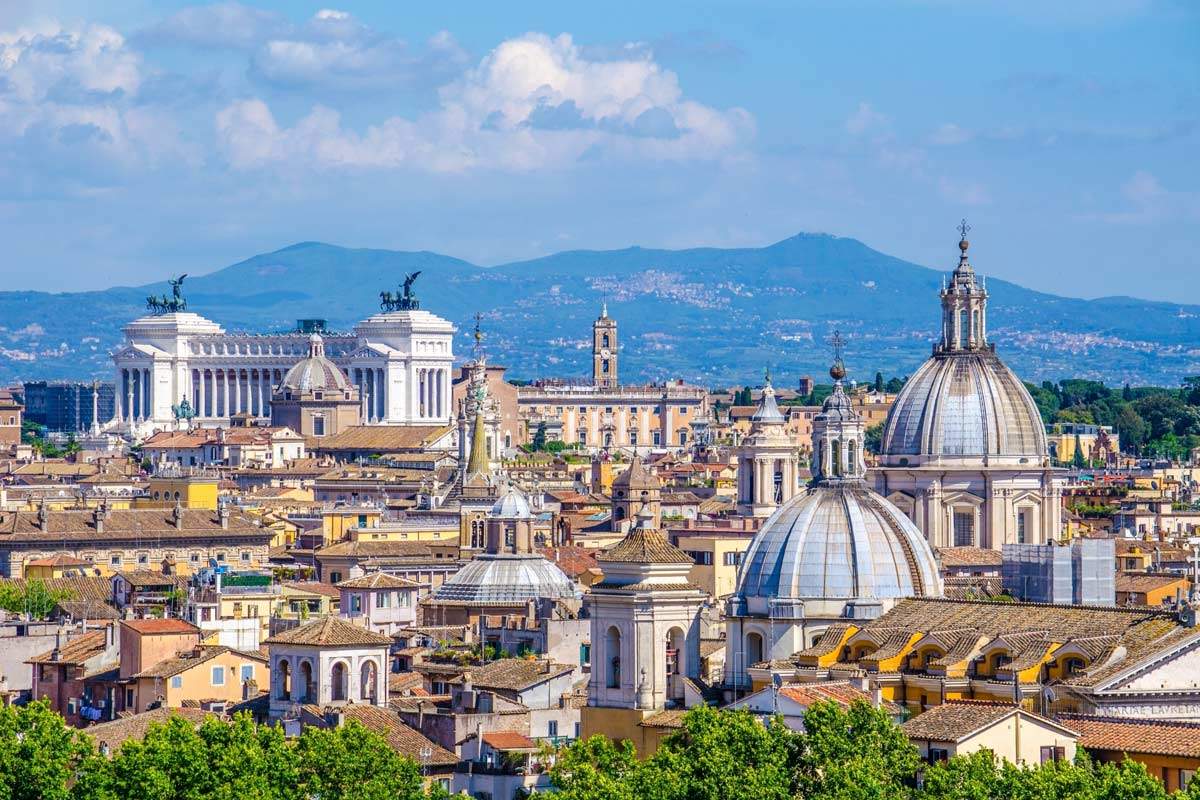
Rom (lateinisch Rōma; italienisch Roma [ˈroːma]), amtlich Roma Capitale, ist die Hauptstadt Italiens.[2] Mit etwa drei Millionen Einwohnern im Stadtgebiet bzw. rund vier Millionen Einwohnern in der Agglomeration ist sie die größte Stadt Italiens. Rom liegt in der Region Latium an den Ufern des Flusses Tiber.
Rom wurde erstmals im 1. Jahrhundert v. Chr. vom Dichter Tibull[3] Ewige Stadt genannt. Diese Bezeichnung, ursprünglich eine Antonomasie, wurde zu einem Ehrennamen für die Stadt wegen der Bedeutung in ihrer bis heute drei Jahrtausende umspannenden Geschichte.
Sie ist heute Verwaltungssitz der Region Latium und der Metropolitanstadt Rom, bis 2015 Provinz Rom. Innerhalb der Stadt bildet der unabhängige Staat der Vatikanstadt eine Enklave. Der Vatikan ist der Sitz des Papstes, das heißt des Bischofs von Rom und Oberhaupts der römisch-katholischen Kirche sowie des Heiligen Stuhls. Zudem ist Rom seit 1834 Sitz des Malteser-Ritterordens, der ein eigenständiges (jedoch nichtstaatliches) Völkerrechtssubjekt ist, sowie der UNO-Unterorganisationen FAO, IFAD und WFP.
Rom ist außerordentlich reich an bedeutenden Bauten und Museen und Ziel zahlreicher Touristen. Die Altstadt von Rom, der Petersdom und die Vatikanstadt wurden von der UNESCO im Jahr 1980 zum Weltkulturerbe erklärt.[4]
In einer Rangliste der Städte nach ihrer Lebensqualität belegte Rom im Jahre 2018 den 57. Platz unter 231 untersuchten Städten weltweit.[5]
罗马(意大利语:Roma)是意大利首都及全国政治、经济、文化和交通中心,是世界著名的历史文化名城,古罗马文明的发祥地,因建城历史悠久并保存大量古迹而被昵称为“永恒之城”[1][2]。其位于意大利半岛中西部,台伯河下游平原地的七座小山丘上,市中心面积有1200多平方公里。罗马同时是全世界天主教会的中枢,拥有700多座教堂与修道院、7所天主教大学,市内的梵蒂冈城是罗马主教即天主教会教宗及圣座的驻地。罗马与佛罗伦萨同为意大利文艺复兴中心[3],现今仍保存有相当丰富的文艺复兴与巴洛克风貌;1980年,罗马的历史城区被列为世界文化遗产[4]。
ローマ(伊: Roma、羅: Roma)は、イタリアの首都。欧州有数の世界都市であり、ラツィオ州の州都、ローマ県のコムーネの一つで、ローマ県の県都でもある。英語とフランス語の表記は「Rome」。
イタリアの首都で政治、経済、文化の中心地である。当市に囲まれるようにローマ教皇の居住するバチカン市国があり、そこは全世界のカトリック教徒にとっての中心地で、現在は外国であるが歴史・宗教・文化的にはローマ市地域と密接な関わりがある。そして昔のローマの大国さを表した「ローマは一日にして成らず」という諺もある。また、領土を持たないマルタ騎士団の本部、マルタ宮殿がコンドッティ通り68にあり、治外法権が認められている。
2014年現在の人口は約286万人で、イタリアで最も人口が多い都市である。2010年の都市的地域の人口では271万人であり、世界128位である[4]。 かつてのローマ帝国の首都であったため西洋文明圏を代表する都市のひとつであり、カトリック教会の中枢であり、そしてまたその美しさから『永遠の都』と称される。
2014年、アメリカのシンクタンクが公表したビジネス、人材、文化、政治などを対象とした総合的な世界都市ランキングにおいて、世界第32位の都市と評価されており、イタリアの都市では第1位であった[5]。
観光都市としての側面もあり、2012年には7,800,000人の観光客が訪れた[6]。後述の「観光」、「聖地として」も参照。
Rome (Italian: Roma  i[ˈroːma]; Latin: Roma [ˈroːma]) is the capital city of Italy and a special comune (named Comune di Roma Capitale). Rome also serves as the capital of the Lazio region. With 2,872,800 residents in 1,285 km2 (496.1 sq mi),[1] it is also the country's most populated comune. It is the fourth-most populous city in the European Union by population within city limits. It is the centre of the Metropolitan City of Rome, which has a population of 4.3 million residents.[2] Rome is located in the central-western portion of the Italian Peninsula, within Lazio (Latium), along the shores of the Tiber. The Vatican City is an independent country inside the city boundaries of Rome, the only existing example of a country within a city: for this reason Rome has been often defined as capital of two states.[3][4]
i[ˈroːma]; Latin: Roma [ˈroːma]) is the capital city of Italy and a special comune (named Comune di Roma Capitale). Rome also serves as the capital of the Lazio region. With 2,872,800 residents in 1,285 km2 (496.1 sq mi),[1] it is also the country's most populated comune. It is the fourth-most populous city in the European Union by population within city limits. It is the centre of the Metropolitan City of Rome, which has a population of 4.3 million residents.[2] Rome is located in the central-western portion of the Italian Peninsula, within Lazio (Latium), along the shores of the Tiber. The Vatican City is an independent country inside the city boundaries of Rome, the only existing example of a country within a city: for this reason Rome has been often defined as capital of two states.[3][4]
Rome's history spans 28 centuries. While Roman mythology dates the founding of Rome at around 753 BC, the site has been inhabited for much longer, making it one of the oldest continuously occupied sites in Europe.[5] The city's early population originated from a mix of Latins, Etruscans, and Sabines. Eventually, the city successively became the capital of the Roman Kingdom, the Roman Republic and the Roman Empire, and is regarded as the birthplace of Western civilisation and by some as the first ever metropolis.[6] It was first called The Eternal City (Latin: Urbs Aeterna; Italian: La Città Eterna) by the Roman poet Tibullus in the 1st century BC, and the expression was also taken up by Ovid, Virgil, and Livy.[7][8] Rome is also called the "Caput Mundi" (Capital of the World). After the fall of the Western Empire, which marked the beginning of the Middle Ages, Rome slowly fell under the political control of the Papacy, which had settled in the city since the 1st century AD, until in the 8th century it became the capital of the Papal States, which lasted until 1870. Beginning with the Renaissance, almost all the popes since Nicholas V (1447–1455) pursued over four hundred years a coherent architectural and urban programme aimed at making the city the artistic and cultural centre of the world.[9] In this way, Rome became first one of the major centres of the Italian Renaissance,[10] and then the birthplace of both the Baroque style and Neoclassicism. Famous artists, painters, sculptors and architects made Rome the centre of their activity, creating masterpieces throughout the city. In 1871, Rome became the capital of the Kingdom of Italy, which, in 1946, became the Italian Republic.
Rome has the status of a global city.[11][12][13] In 2016, Rome ranked as the 14th-most-visited city in the world, 3rd most visited in the European Union, and the most popular tourist attraction in Italy.[14] Its historic centre is listed by UNESCO as a World Heritage Site.[15] Monuments and museums such as the Vatican Museums and the Colosseum are among the world's most visited tourist destinations with both locations receiving millions of tourists a year, and the city hosted the 1960 Summer Olympics. Rome is the seat of several specialized agencies of the United Nations, such as the Food and Agriculture Organization (FAO), the World Food Programme (WFP) and the International Fund for Agricultural Development (IFAD). The city hosts the headquarters of many international business companies, such as Eni, Enel, TIM, Leonardo S.p.A., and national and international banks such as Unicredit and BNL. Its business district, called EUR, is the base of many companies involved in the oil industry, the pharmaceutical industry, and financial services. Rome is also an important fashion and design centre thanks to renowned international brands centered in the city. Rome's Cinecittà Studios have been the set of many Academy Award–winning movies.
Roma (AFI: /ˈroma/[5], pronuncia[?·info]) è la capitale della Repubblica Italiana, nonché capoluogo dell'omonima città metropolitana e della regione Lazio. La città è dotata di un ordinamento amministrativo speciale, denominato Roma Capitale, disciplinato da una legge dello Stato.[6]
Con 2 869 322 abitanti è il comune più popoloso d'Italia e il quarto dell'Unione europea,[3] mentre con 1 287,36 km² è il comune più esteso d'Italia e la quinta città più estesa d'Europa dopo Mosca, Istanbul, Londra e San Pietroburgo. È inoltre la città europea con la maggiore superficie di aree verdi[7].
Fondata secondo la tradizione il 21 aprile del 753 a.C. (sebbene scavi recenti nel Lapis Niger farebbero risalire la fondazione a 2 secoli prima[8][9]), nel corso dei suoi tre millenni di storia è stata la prima metropoli dell'umanità,[10] cuore pulsante di una delle più importanti civiltà antiche, che influenzò la società, la cultura, la lingua, la letteratura, l'arte, l'architettura, la filosofia, la religione, il diritto e i costumi dei secoli successivi. Luogo di origine della lingua latina, fu capitale dell'Impero romano che estendeva il suo dominio su tutto il bacino del Mediterraneo e gran parte dell'Europa, dello Stato Pontificio, sottoposto al potere temporale dei papi e del Regno d'Italia (dal 1871 al 1946). Per antonomasia, è definita l'Urbe, Caput Mundi e Città eterna.
Il suo centro storico, delimitato dal perimetro delle mura aureliane, sovrapposizione di testimonianze di quasi tre millenni è espressione del patrimonio storico, artistico e culturale del mondo occidentale europeo[11] e, nel 1980, insieme alle proprietà extraterritoriali della Santa Sede nella città, è stato inserito nella lista dei Patrimoni dell'umanità dell'UNESCO, provvedimento esteso nel 1990 ai territori compresi all'interno delle mura gianicolensi, edificate per volere di papa Urbano VIII.[12][13]
Roma, cuore della cristianità cattolica, è l'unica città al mondo ad ospitare al proprio interno un intero Stato, l'enclave della Città del Vaticano:[14] per tale motivo è spesso definita capitale di due Stati.[15][16]
Rome (en italien : Roma, prononcé [ˈroˑma]) est la capitale de l'Italie depuis 1871. Située au centre-ouest de la péninsule Italienne, près de la mer Tyrrhénienne, elle est également la capitale de la région du Latium, et fut celle de l'Empire romain durant 357 ans. En 2016, elle compte 2 877 215 habitants établis sur 1 285 km2, ce qui fait d'elle la commune la plus peuplée d'Italie et la troisième plus étendue d'Europe après Moscou et Londres1. Son aire urbaine recense 4 356 403 habitants en 20162,3. Elle présente en outre la particularité de contenir un État enclavé dans son territoire : la cité-État du Vatican (Stato della Città del Vaticano), dont le pape est le souverain. C'est le seul exemple existant d'un État à l'intérieur d'une ville.
L'histoire de Rome s'étend sur plus de vingt-huit siècles, depuis sa fondation mythique par Romulus en 753 av. J.-C. jusqu'à son rôle actuel de capitale de la république italienne. Second berceau de la civilisation occidentale après Athènes, la ville fut successivement le centre de la monarchie romaine, de la république romaine (509 av. J.-C. – 27 av. J.-C.), puis de l'Empire romain (27 av. J.-C. – 330). Durant cette période, où nait la célèbre expression proverbiale « tous les chemins mènent à Rome », la ville aurait compté entre un et deux millions d'habitants et domine l'Europe, l'Afrique du Nord et le Moyen-Orient tant militairement que culturellement, diffusant dans ces territoires la langue latine, ses arts et techniques ainsi que la religion chrétienne. Depuis le Ier siècle elle abrite le siège de l'Église catholique romaine, au sein des États pontificaux (752-1870) puis de la Cité du Vatican.
Considérablement agrandie par de grands travaux sous Jules César et surtout sous Auguste, la ville est partiellement détruite lors du Grand incendie de Rome - le Circus Maximus notamment. À partir du XVe siècle, presque tous les papes depuis Nicolas V (1447-1455) perpétuent la tradition de l'architecture romaine et ambitionnent de faire de Rome le principal centre culturel et artistique de l'Occident. La ville devient l'un des foyers de la Renaissance italienne, avec Florence et Venise, et donne naissance au style baroque - dont témoigne encore son centre historique, classé par l'UNESCO comme site du patrimoine mondial4. Des artistes comme Michel-Ange, Raphaël ou Le Bernin s'y installent et produisent des œuvres telles que la basilique Saint-Pierre, la chapelle Sixtine, la fontaine de Trevi, le Capitole ou les Chambres de Raphaël. Au XIXe siècle, Rome est le symbole de l'unité italienne et devient la capitale du Royaume d'Italie, puis de la République après la Seconde Guerre mondiale.
Ville globale, Rome est la troisième destination touristique la plus visitée d'Europe derrière Londres et Paris5. La Ville Éternelle est l'une des plus belles villes du monde, et fréquentée par les touristes depuis le XVIIIe siècle. Le siège de la papauté et le pèlerinage de Rome en font un lieu éminent pour les chrétiens du monde entier depuis des siècles. Les musées du Vatican et le Colisée sont parmi les sites les plus fréquentés. Rome est aussi l'un des plus grands sites archéologiques du monde, et compte également de nombreux ponts et fontaines, 900 églises, ainsi qu'un grand nombre de musées et d'universités. Outre le tourisme, l'économie de la « Ville Éternelle » est également orientée vers les nouvelles technologies, les médias et les télécommunications depuis les années 2000. Bâtie sur sept collines, la ville se situe près de l'embouchure du Tibre et est divisée en vingt-deux rioni. Rome a aussi organisé les Jeux olympiques d'été en 1960. Rome n'est jumelée qu'avec une seule autre ville, Paris, ce qui est vrai dans l'autre sens, avec ce slogan : « Seul Paris est digne de Rome, seule Rome est digne de Paris ».
Roma es una ciudad italiana de 2 877 215 habitantes,23 capital de la región del Lacio y de Italia. Es el municipio más poblado de Italia y es la cuarta ciudad más poblada de la Unión Europea.4 Por antonomasia se la conoce desde fines de la Antigüedad como la Urbe. También es llamada "La Ciudad Eterna" (en italiano: Città Eterna).
En el transcurso de su historia, que abarca tres milenios, llegó a extender sus dominios sobre toda la cuenca del Mediterráneo y gran parte de Europa. Como capital del Imperio romano, se constituyó en una de las primeras grandes metrópolis de la humanidad, centro de una de las civilizaciones antiguas más importantes. Influyó en la sociedad, la cultura, la lengua, la literatura, el arte, la arquitectura, la filosofía, la religión, el derecho y la moral de los siglos sucesivos.
Es la ciudad con la más alta concentración de bienes históricos y arquitectónicos del mundo;5 su centro histórico delimitado por el perímetro que marcan las murallas aurelianas, superposición de huellas de tres milenios, es la expresión del patrimonio histórico, artístico y cultural del mundo occidental europeo.6 En 1980, junto a las propiedades extraterritoriales de la Santa Sede que se encuentran en la ciudad y la Basílica de San Pablo Extramuros, fue incluida en la lista del Patrimonio de la Humanidad de la Unesco.78
Roma es el corazón geográfico de la religión católica y destino de peregrinación (vías romeas) y también la única ciudad del mundo que tiene en su interior un Estado extranjero: el enclave de la Ciudad del Vaticano, que se encuentra bajo el poder temporal del papa.9 Por tal motivo se le ha conocido también como la capital de dos Estados.
Рим (итал. Roma [ˈroːma]) — столица и крупнейший город Италии. Административный центр области Лацио и провинции Рим. Расположен на реке Тибр.
Рим — один из старейших городов мира, древняя столица Римской империи. Ещё в Античности (III век н. э.) Рим стали часто называть Вечным (лат. Roma Aeterna). Одним из первых так назвал Рим римский поэт Альбий Тибулл (I век до н. э.) в своей второй элегии. Представления о «вечности» Рима во многом сохранились и после падения древнеримской цивилизации, принеся соответствующий эпитет в современные языки.
Также Рим называют «городом на семи холмах». Первоначально поселения располагались на холме Палатине, впоследствии были заселены соседние холмы: Капитолий и Квиринал. Несколько позже поселения появились на последних четырёх холмах (Целие, Авентине, Эсквилине и Виминале).
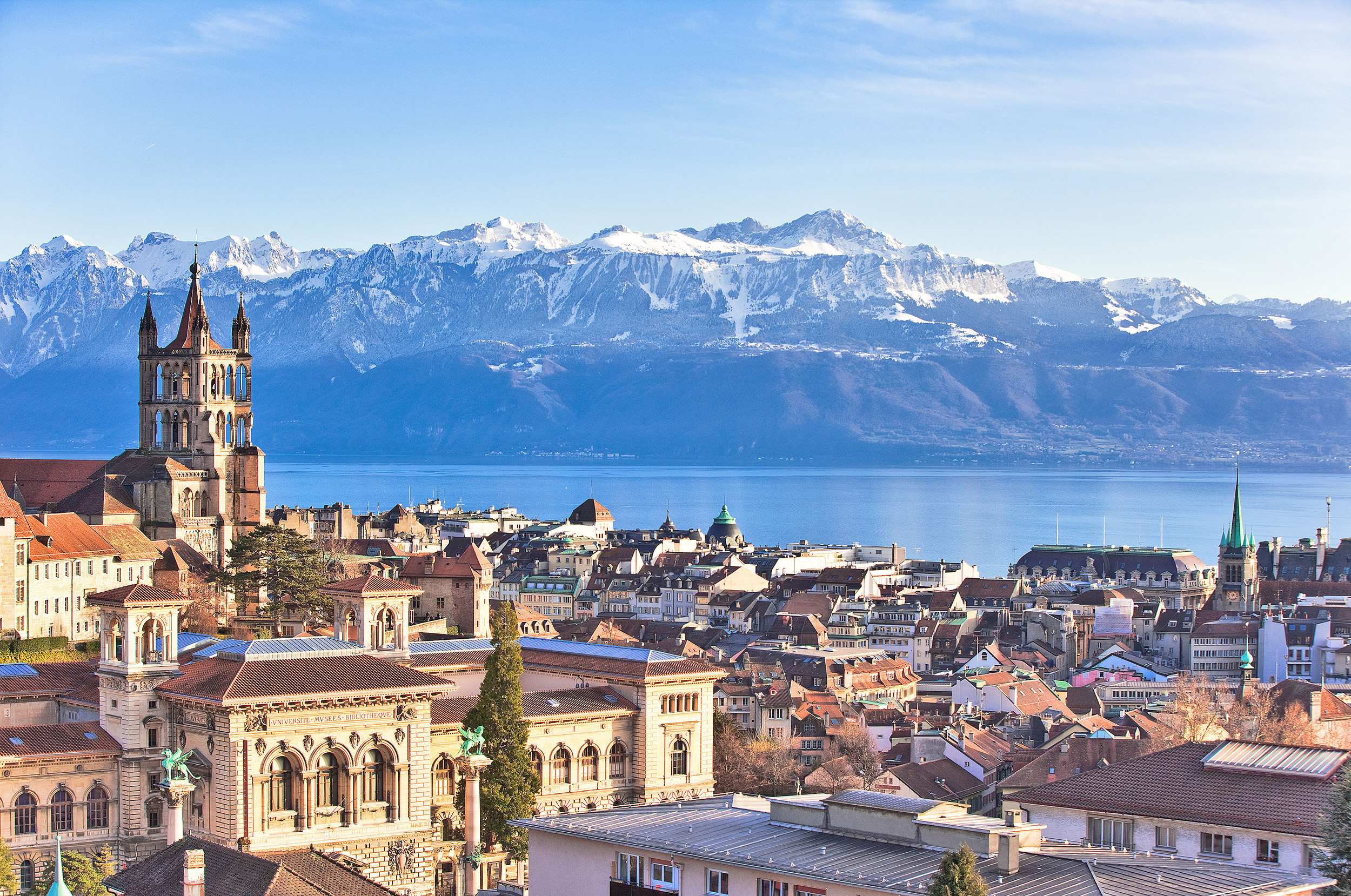
Lausanne [lɔˈzan] (deutsch veraltet auch Lausannen und Losanen,[4] frankoprovenzalisch Losena [lɔˈzəna],[5] italienisch und rätoromanisch Losanna) ist eine politische Gemeinde, der Hauptort des Schweizer Kantons Waadt und die Hauptstadt des Distrikts Lausanne. Die Stadt liegt in der französischsprachigen Schweiz (Romandie), am Genfersee und gehört mit ihren 144'000 Einwohnern[2] (Februar 2017) – neben Zürich, Genf, Basel, Bern und Winterthur – zu den grössten politischen Gemeinden der Schweiz.
Lausanne ist Teil der Metropolregion Genf-Lausanne mit 1,2 Millionen Einwohnern und ein bedeutendes Wirtschafts-, Kultur- und Bildungszentrum sowie eine wichtige Verkehrsdrehscheibe in der Westschweiz. Mit 43 Prozent Ausländern[2] (Einwohner ohne Bürgerrecht) zählt Lausanne, unter anderem neben Genf,[6] zu den Schweizer Städten mit hohem Ausländeranteil.
Das Bundesgericht (BGer) hat in Lausanne seinen Sitz, ebenso der Internationale Sportgerichtshof (TAS) und das Schweizer Filmarchiv. Zudem haben in Lausanne verschiedene Sportweltverbände, darunter das Internationale Olympische Komitee (IOC), ihren Hauptsitz. Seit 1994 trägt die Stadt den offiziellen Titel als «Olympische Hauptstadt».[7]
洛桑(法语:Lausanne,国际音标:[loˈzan])是瑞士法语区城市,位于莱芒湖(法语:Lac Léman)北岸,与法国城市埃维昂莱班隔湖相望,北面是侏罗纪山脉。洛桑位于日内瓦东北约50公里处,是瑞士联邦沃州和洛桑区首府,同时也是大洛桑都会区核心城市、瑞士第五大城市。洛桑与邻近的日内瓦一样,是许多著名的国际组织例如国际奥委会等的总部所在地,因此也称为“奥林匹克首都”。洛桑境内的洛桑管理学院亦是世界一流的著名学府与研究机构。洛桑也位于瑞士酿酒区的中心位置。另外,位于洛桑的洛桑联邦理工学院是瑞士两所联邦理工学院之一。
ローザンヌ(Lausanne)は、スイスのヴォー州に属する基礎自治体(コミューン) で、同州の州都。フランス語圏に属し、フランス語でのより正確な発音は「ロザン」[loˈzan][2]または「ロウザン」[loʊˈzan][3]、ドイツ語でのより正確な発音は「ロザン」[loˈzan][4]。イタリア語、ロマンシュ語ではLosannaと綴る。
レマン湖の北岸に位置する[5]。近隣の主要都市としては、約80km北東にベルン、レマン湖に沿って約50km南西にジュネーヴが位置する。
国際オリンピック委員会(IOC)の本部が置かれており、「オリンピックの首都(Olympic Capital)」とも言われる。2020年冬季ユースオリンピックの開催地となっている。
国際柔道連盟(IJF)、国際スケート連盟(ISU)、世界野球ソフトボール連盟(WBSC)の本部もここに置かれている。
スイス連邦の連邦最高裁判所が置かれ、同国の「司法首都」となっている。
1973年より、若手バレリーナの登竜門として知られるローザンヌ国際バレエコンクールが開催されていることでも知られる。
Lausanne (/loʊˈzæn/, French pronunciation: [lozan], German: Lausanne,[3] Italian: Losanna, Romansh: Losanna)[4] is a city in the French-speaking part of Switzerland, and the capital and biggest city of the canton of Vaud. The city is situated on the shores of Lake Geneva (French: Lac Léman, or simply Le Léman).[5] It faces the French town of Évian-les-Bains, with the Jura Mountains to its north-west. Lausanne is located 62 kilometres (38.5 miles) northeast of Geneva.
Lausanne has a population (as of November 2015) of 146,372,[6] making it the fourth largest city in Switzerland, with the entire agglomeration area having 420,000 inhabitants (as of March 2015).[7] The metropolitan area of Lausanne-Geneva (including Vevey-Montreux, Yverdon-les-Bains, and foreign parts) was over 1.2 million inhabitants in 2000.[8]
Lausanne is a focus of international sport, hosting the International Olympic Committee (which recognizes the city as the "Olympic Capital" since 1994),[9] the Court of Arbitration for Sport and some 55 international sport associations.[10] It lies in a noted wine-growing region. The city has a 28-station metro system, making it the smallest city in the world to have a rapid transit system.[citation needed] Lausanne will host the 2020 Winter Youth Olympics.[11]
Lausanne est une ville suisse située sur la rive nord du lac Léman. Elle est la capitale et ville principale du canton de Vaud3 et le chef-lieu du district de Lausanne. Elle constitue la quatrième ville du pays en termes de population4 après Zurich, Genève et Bâle. Fin 2014, l'agglomération lausannoise compte 402 900 habitants5 et la commune de Lausanne en compte, en incluant la population non-permanente, 145 000 en 2017 (près de 137 000 en comptant uniquement la population permanente, à fin 2016)6,1. En 2012, l'agglomération lausannoise compte 50 % de la population du canton de Vaud et concentre 60 % des emplois7. Elle héberge le vaste campus de l'Université de Lausanne (UNIL) et de l'École polytechnique fédérale de Lausanne (EPFL), ainsi que l'EHL, l'ECAL et l'IMD.
Dans la ville se trouvent le Tribunal fédéral, le site principal de la Cinémathèque suisse ainsi que le siège du Comité international olympique (CIO) et de 55 fédérations sportives internationales. Elle porte le titre officiel de « Capitale olympique »8 depuis 1994. Elle sera l'hôte des Jeux olympiques de la jeunesse d'hiver de 2020.
Losanna (AFI: [loˈzanna][1]; in francese: Lausanne; in arpitano: Losena; in romancio: Losanna; in tedesco: Lausanne o anche, antiquati, Lausannen e Losanen) è una città della Svizzera, capitale del Canton Vaud e dell'omonimo distretto.
Conta 137.810 abitanti (424.000 nell'hinterland) ed è la quarta città più grande della Svizzera, preceduta in ordine decrescente da Zurigo, Ginevra e Basilea. È situata sulla sponda settentrionale del Lago Lemano (Lac Léman in Francese), chiamato anche Lago di Ginevra.
È un importante centro di attività commerciali bancarie e universitarie ed è sede della famosa scuola di danza Rudra-Béjart, fondata dal grande coreografo Maurice Béjart. Nel 1994, Losanna fu dichiarata Capitale Olimpica ed è quindi sede del Comitato Olimpico Internazionale.
La città di Losanna è collegata alla cittadina francese di Évian tramite battello.
Lausana2 (en francés y alemán, Lausanne [loˈzan], en italiano y romanche Losanna) es una ciudad y comuna de Suiza, capital del cantón de Vaud y del distrito de Lausana. Se sitúa a orillas del lago Lemán, frente a la ciudad francesa de Évian-les-Bains.
Lausana es la cuarta ciudad más poblada de Suiza tras Zúrich, Ginebra y Basilea. En Romandía es la segunda ciudad después de Ginebra. La ciudad es conocida como la Capital Olímpica, ya que es sede del Comité Olímpico Internacional, además del también deportivo Museo Olímpico. A finales de 2016, Lausana contaba con 139 624 habitantes,1 sumando un total de 420.067 habitantes en su área metropolitana.
Лоза́нна (фр. Lausanne [loˈzan], франкопров. Losena [lɔˈzəna]) — город на юго-западе Швейцарии, столица франкоязычного кантона Во и административный центр округа Лозанна.
Население — 138,6 тыс. человек (май 2013 года), четвёртый по величине город страны. Иммигранты составляют 40 % населения. В пределах агломерации проживает 336,4 тыс. человек (2010 год). Расположена в Романдии, на террасных холмах у северного берега Женевского озера, в 62 км от Женевы[4].
Лозанна носит звание «Олимпийской столицы» мира. Здесь располагаются штаб-квартиры Международного олимпийского комитета и многочисленных международных спортивных федераций. Местонахождение Спортивного арбитражного суда и Верховного суда Швейцарии. Имеются университет, политехническая школа и бизнес-школа IMD. Основной вид общественного транспорта — троллейбус; действует единственное в стране метро.
Исторический центр к северу от вокзала опутан сетью кривых и крутых улочек. На холме Ситэ средневековый замок Сен-Мер и готический собор Нотр-Дам; в Нижнем городе церковь святого Франциска; на площади Палю старинная ратуша. Реки убраны в подземные коллекторы, мосты сухопутны. К югу от вокзала набережная Уши́.
В древности на месте Лозанны существовало поселение, в I веке до н. э. получившее римское название Лузонна. С VI века была епископским городом под властью европейских государств. В XVI веке после завоевания Берном вошла в Швейцарский союз, введена Реформация. В 1803 году стала столицей кантона Во.
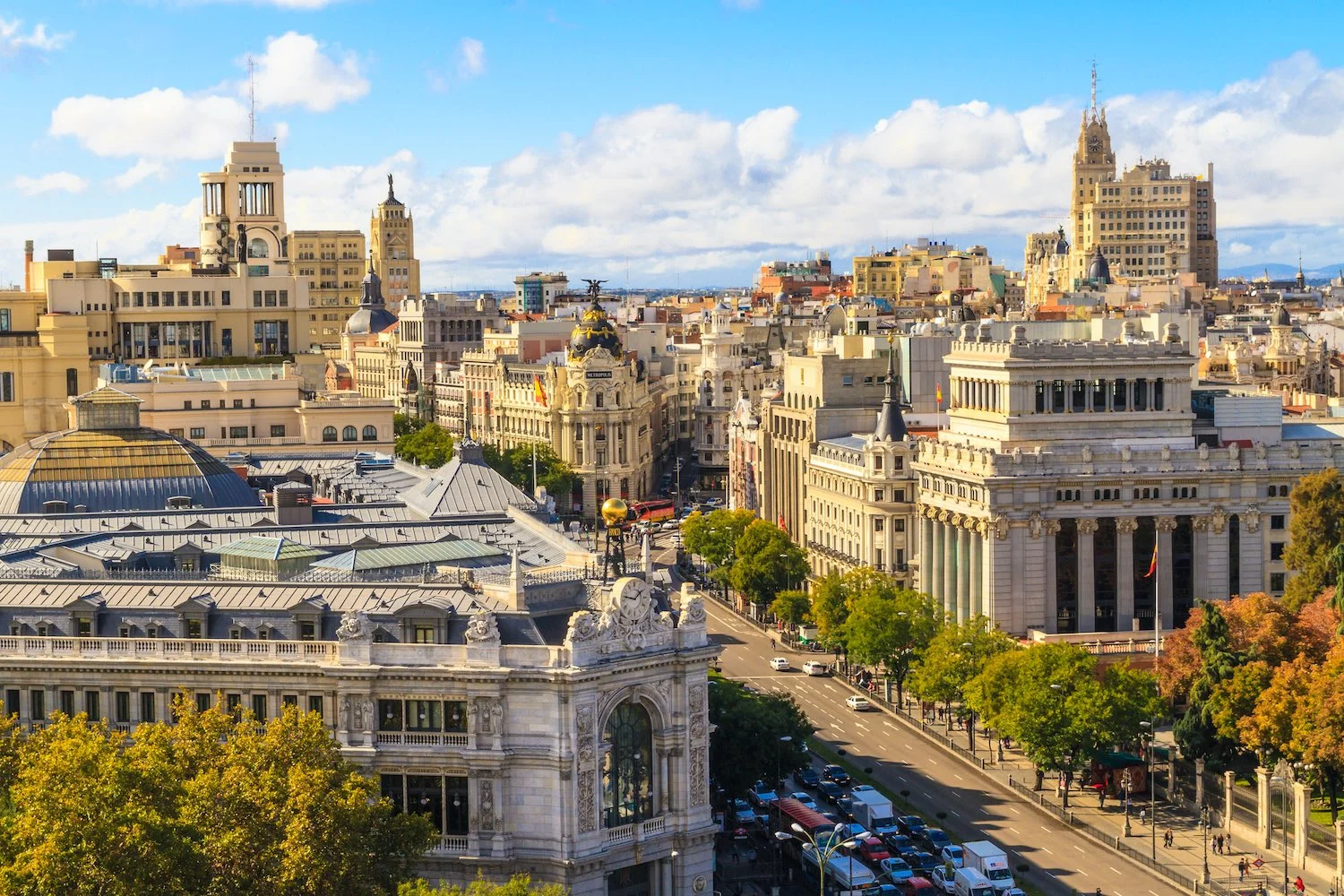
西班牙首都,第一大城市,全国经济、交通中心,马德里省首府。市区面积607平方千米,人口约310.1万,包括郊区和卫星城镇在内,面积 1020 平方千米,人口约 468.7 万。位于伊比利亚半岛梅塞塔高原中部,瓜达拉马山脉东南麓的山间高原盆地中,海拔 670 米,为欧洲地势最高的首都。地形闭塞 ,气候大陆性显著 ,降水少,气温年差较大。1月平均气温4.8℃,7月25℃,年降水量425毫米。
西班牙首都马德里(Madrid)是欧洲著名的历史古城。位于伊比利亚半岛中心,地处梅塞塔高原,海拔670米,是欧洲地势最高的首都。有人口301. 6万人(2002年)。
十一世纪前它是摩尔人的要塞,古称“马吉利特”。1561年西班牙国王菲利普二世迁都于此。十九世纪时发展为大城市。1936年至1939年西班牙内战时,曾在此进行著名的马德里保卫战。
马德里市内文物荟萃,有许多名胜古迹和世界闻名的绘画展览馆──普拉多博馆等。
市 内现代化的高楼大厦与风格迥异的古建筑摩肩并立、相映生辉。树林、草坪和各种造型别致的喷泉和雕有古代小亚细亚人尊崇的自然女神尼贝莱塑像喷泉最吸人入 胜。宏伟的阿尔卡拉门座落在阿尔卡拉街头的独立广场上,共有5道拱门,是马德里著名的古建筑之一。财政部、教育部和西班牙的主要银行座落在阿尔卡拉大街两 侧,建于1752年的王家美术学院收藏着牟利罗和戈雅等西班牙美术大师的名作。巍峨的塞万提斯纪念碑耸立在西班牙广场上,碑前有堂吉诃德和桑科·潘扎的塑 像,巨大的碑身倒映在前面的水池之中,碑两侧是葱郁的树木;有“马德里塔”之称的西班牙摩天大厦位于广场一侧。
(Quelle:http://madeli.yiji.com/postdetail_619481.html)
马德里(西班牙语:Madrid,西班牙语发音:[maˈðɾið] (ⓘ))是西班牙首都及最大都市,也是马德里自治区首府,其位置处于西班牙国土中部,曼萨纳雷斯河贯穿市区。市内人口约340万,都会区人口则约627.1万(2010年),均占西班牙首位。其建城于9世纪,是在摩尔人边贸站“马格立特”旧址上发展起来的城市;1561年,西班牙国王腓力二世将首都从托莱多迁入于此[注 1],由于其特殊的地位而得到迅速的发展,成为往后西班牙殖民帝国的运筹中心[8],现今则与巴塞罗那并列为西班牙的两大对外文化窗口。
马德里和其近郊组成的马德里大都市区为欧盟第三大城市经济体,仅次于巴黎和米兰。马德里拥有2个世界著名的足球俱乐部,皇家马德里和马德里竞技。同时,在生活水平、经济产出和市场规模方面,马德里是南欧[9][10]和伊比利亚半岛最重要的国际金融中心,同时也是欧洲和拉丁美洲之间的主要贸易通道。[11]绝大多数西班牙国内企业的总部均设在马德里,如西班牙电信、国际航空集团和西班牙国家石油公司等。一些研究机构,如西班牙皇家语言学院和薛万提斯学院;一些国际组织,如联合国下属的世界旅游组织(UNWTO)和伊比利亚美洲国家组织(OEI)等,也将总部设于马德里。
近年,各种文化活动在马德里开展。主要有西班牙国际旅游交易会(FITUR)[12],艺术博览会(ARCO)[13],马德里电脑展(SIMO TCI)[14]和马德里时装周。[15]
由于在政治、教育、娱乐、环境、大众媒体、时装、科学、文化和艺术所占据的重要地位,马德里被列为国际大都市之一。[16][17]根据Monocle杂志2017年的指数排名,马德里入选世界最佳宜居城市第10位。[18][19]
马德里是西班牙旅游人数第二多的城市,仅次于巴塞罗那。[20]虽然它拥有现代化的基础设施,但它仍完好地保留了许多历史建筑。西贝莱斯广场和喷泉已成为马德里的标志性象征。
Madrid (deutsch [maˈdʁɪt], spanisch [maˈðɾið]) ist die Hauptstadt Spaniens und der Autonomen Gemeinschaft Madrid. Die Metropolregion Madrid zählt mit etwa sieben Millionen Einwohnern zu den größten Metropolen Europas. Madrid ist (ohne Vororte) mit rund 3,2 Millionen Einwohnern nach London und Berlin die drittgrößte Stadt der Europäischen Union und die größte Stadt Südeuropas.
Madrid ist seit Jahrhunderten der geographische, politische und kulturelle Mittelpunkt Spaniens (siehe Kastilien) und der Sitz der spanischen Regierung. Hier residieren auch der König, ein katholischer Erzbischof sowie wichtige Verwaltungs- und Militärbehörden. Als Handels- und Finanzzentrum hat die Stadt nationale und internationale Bedeutung. In Madrid befinden sich sechs öffentliche Universitäten sowie verschiedene andere Hochschulen, Theater, Museen und Kultureinrichtungen.
Die Einwohner Madrids nennt man „Madrilenen“ (span. madrileños) oder „Madrider“.
マドリード(Madrid)は、スペインの首都である。マドリード州の州都であり、マドリード州の唯一の県であるマドリード県の県都でもある。
人口は約325万人。2011年の都市圏人口は541万人であり、世界第57位、欧州では第5位である[5]。 紋章はイチゴノキとクマ。
スペイン中央部のメセタ地帯のマンサナーレス川沿いに広がる。近郊にはモストレス、アルカラ・デ・エナーレス、ヘタフェなどの都市があり、マドリード首都圏を形成している。
ヨーロッパ屈指の世界都市であり、アメリカのシンクタンクが2017年に発表した総合的な世界都市ランキングにおいて、世界15位の都市と評価された[6]。
Madrid (/məˈdrɪd/, Spanish: [maˈðɾið]) is the capital of Spain and the largest municipality in both the Community of Madrid and Spain as a whole. The city has almost 3.2 million[4] inhabitants and a metropolitan area population of approximately 6.5 million. It is the third-largest city in the European Union (EU), smaller than only London and Berlin, and its monocentric metropolitan area is the third-largest in the EU, smaller only than those of London and Paris.[5][6][7][8] The municipality covers 604.3 km2 (233.3 sq mi).[9]
Madrid lies on the River Manzanares in the centre of both the country and the Community of Madrid (which comprises the city of Madrid, its conurbation and extended suburbs and villages); this community is bordered by the autonomous communities of Castile and León and Castile-La Mancha. As the capital city of Spain, seat of government, and residence of the Spanish monarch, Madrid is also the political, economic and cultural centre of the country.[10] The current mayor is Manuela Carmena from the party Ahora Madrid.
The Madrid urban agglomeration has the third-largest GDP[11] in the European Union and its influences in politics, education, entertainment, environment, media, fashion, science, culture, and the arts all contribute to its status as one of the world's major global cities.[12][13] Madrid is home to two world-famous football clubs, Real Madrid and Atlético de Madrid. Due to its economic output, high standard of living, and market size, Madrid is considered the major financial centre of Southern Europe[14][15] and the Iberian Peninsula; it hosts the head offices of the vast majority of major Spanish companies, such as Telefónica, IAG or Repsol. Madrid is the 10th most liveable city in the world according to Monocle magazine, in its 2017 index.[16]
Madrid houses the headquarters of the World Tourism Organization (UNWTO), belonging to the United Nations Organization (UN), the Ibero-American General Secretariat (SEGIB), the Organization of Ibero-American States (OEI), and the Public Interest Oversight Board (PIOB). It also hosts major international regulators and promoters of the Spanish language: the Standing Committee of the Association of Spanish Language Academies, headquarters of the Royal Spanish Academy (RAE), the Cervantes Institute and the Foundation of Urgent Spanish (Fundéu BBVA). Madrid organises fairs such as FITUR,[17] ARCO,[18] SIMO TCI[19] and the Cibeles Madrid Fashion Week.[20]
While Madrid possesses modern infrastructure, it has preserved the look and feel of many of its historic neighbourhoods and streets. Its landmarks include the Royal Palace of Madrid; the Royal Theatre with its restored 1850 Opera House; the Buen Retiro Park, founded in 1631; the 19th-century National Library building (founded in 1712) containing some of Spain's historical archives; a large number of national museums,[21] and the Golden Triangle of Art, located along the Paseo del Prado and comprising three art museums: Prado Museum, the Reina Sofía Museum, a museum of modern art, and the Thyssen-Bornemisza Museum, which completes the shortcomings of the other two museums.[22] Cibeles Palace and Fountain have become one of the monument symbols of the city.[23][24] Madrid is the most visited city of Spain.[25]
Madrid (prononcé [ma.ˈdʁid] ; en espagnol [ma.ˈðɾið]) est la capitale et la plus grande ville de l'Espagne. Située en plein cœur du royaume, elle est également la capitale et la ville la plus peuplée de la Communauté de Madrid. En tant que capitale d'État, elle abrite la plupart des institutions politiques du pays, dont le Palais royal, le siège du gouvernement et le Parlement.
Comptant une population d'environ 3,2 millions d'habitants intra-muros sur une superficie totale de 604,3 km2, au sein d'une aire urbaine d'environ 6,5 millions d'habitants en 20141, en comptant sa population intra-muros Madrid est la troisième ville de l'Union européenne , derrière Londres et Berlin.
Ville globale, elle abrite le siège de nombreuses institutions, dont l'Organisation mondiale du tourisme, l'Organisation des États Ibéro-américains, l'Académie royale espagnole et l'Institut Cervantes. Considérée comme l'une des principales places financières de l'Europe du Sud, elle partage le statut de cœur économique de l'Espagne avec Barcelone. Elle accueille le siège social des plus grandes entreprises du pays, comme Telefónica, Repsol ou Iberia.
Les bâtiments d'architecture récente côtoient des constructions de style néo-classique, telles que la porte d'Alcalá, la place de Cybèle ou la cathédrale de l'Almudena. Ville d'art, ses trois principaux musées, le musée du Prado, le musée Reina Sofía et le musée Thyssen-Bornemisza, comptent parmi les plus visités au monde2. En outre, Madrid abrite deux des plus grands clubs de football au monde, le Real Madrid et l'Atlético de Madrid.
Madrid es un municipio y ciudad de España. La localidad, con categoría histórica de villa,9 es la capital del Estado10 y de la Comunidad de Madrid. Dentro del término municipal de Madrid, el más poblado de España, viven 3 182 981 personas empadronadas, según el INE de 2017. El área metropolitana de Madrid tiene una población de 6 543 031 habitantes,11 por lo que es la tercera o cuarta área metropolitana de la Unión Europea, según la fuente, por detrás de las de París y Londres, y en algunas fuentes detrás también de la Región del Ruhr, así como la tercera ciudad más poblada de la Unión Europea, por detrás de Berlín y Londres.12131415
La ciudad cuenta con un PIB nominal de 227 411 millones USD y un PIB per cápita nominal de 34 425 USD, lo que representa un PIB PPA per cápita de 40 720 USD,16 siendo la 1.ª área metropolitana española en actividad económica; y la décima de Europa por detrás de: Londres, París, Rin-Ruhr, Ámsterdam, Milán, Bruselas, Moscú, Fráncfort del Meno y Munich. Madrid es también la ciudad española con más pernoctaciones hoteleras.17
En calidad de capital de España, Madrid alberga las sedes del Gobierno de España y sus Ministerios, de las Cortes Generales (Congreso y Senado), del Tribunal Supremo y del Tribunal Constitucional, así como la residencia oficial de los reyes de España18 y del presidente del Gobierno. En el plano económico, es la cuarta ciudad más rica de Europa, tras Londres, París y Moscú.19 Para 2009, el 50,1 % de los ingresos de las 5000 principales empresas españolas son generados por sociedades con sede social en Madrid, que suponen un 31,8 % de ellas.20 Es sede del 3.ª mayor mercado de valores de Europa,21 y 2.ª en el ámbito iberoamericano (Latibex) y de varias de las más grandes corporaciones del mundo.2223 Es la 8.ª ciudad del mundo con mayor presencia de multinacionales, tras Pekín y por delante de Dubái, París y Nueva York.2425
En el plano internacional acoge la sede central de la Organización Mundial del Turismo (OMT), perteneciente a la ONU, la sede de la Organización Internacional de Comisiones de Valores (OICV), la sede de la Secretaría General Iberoamericana (SEGIB), la sede de la Organización de Estados Iberoamericanos para la Educación, la Ciencia y la Cultura (OEI), la Organización Iberoamericana de Juventud (OIJ), y la sede de Public Interest Oversight Board (PIOB).26 También alberga las principales instituciones internacionales reguladoras y difusoras del idioma español: la Comisión Permanente de la Asociación de Academias de la Lengua Española,27 y sedes centrales de la Real Academia Española (RAE), del Instituto Cervantes y de la Fundación del Español Urgente (Fundéu). Madrid organiza ferias como FITUR, Madrid Fusión, ARCO, SIMO TCI, el Salón del Automóvil y la Cibeles Madrid Fashion Week.
Es un influyente centro cultural y cuenta con museos de referencia internacional, entre los que destacan el Museo del Prado, el Museo Nacional Centro de Arte Reina Sofía, el Thyssen-Bornemisza y CaixaForum Madrid, que ocupan, respectivamente, el 12º, 18º, 67º y 80º puesto entre los museos más visitados del mundo.28
Los orígenes de la ciudad son objeto de revisión histórica tras recientes hallazgos de enterramientos visigodos así como de restos que se remontan a los carpetanos o periodo prerromano. Las excavaciones arqueológicas también arrojan restos que se atribuyen al Madrid romano. Estos hallazgos de época visigoda han venido a confirmar que el posterior asentamiento fortificado musulmán de Maǧrīţ (del siglo IX) se había asentado sobre un vicus visigodo del siglo VII llamado Matrice o matriz, arroyo (AFI [maʤriːtˁ]).2930
No sería hasta el siglo XI cuando Madrid fue incorporada a la Corona de Castilla, tras su conquista por Alfonso VI de León en 1083. Fue designada como sede de la Corte por el rey Felipe II en 1561, convirtiéndose en la primera capital permanente de la monarquía española. Desde el Renacimiento hasta la actualidad ha sido capital de España y sede del Gobierno y la administración del Estado salvo breves intervalos de tiempo: el primero de ellos entre los años de 1601 y 1606, cuando la capitalidad pasó a Valladolid; posteriormente, de 1729 a 1733, en el llamado lustro real, la corte se trasladó a Sevilla por decisión de Isabel de Farnesio, que buscaba cura para el estado depresivo de su esposo, el rey Felipe V;31 también durante la Guerra de la Independencia la Junta Suprema Central, opuesta a José Bonaparte, se estableció en Sevilla, en 1808, y en 1810, como Consejo de Regencia, en Cádiz; finalmente, durante la Guerra Civil, aunque Madrid no dejase de ser la capital de la República conforme al artículo 5º de la Constitución española de 1931, el Gobierno republicano se trasladó en noviembre de 1936 a Valencia y a Barcelona en noviembre del año siguiente, hasta la caída de Cataluña en febrero de 1939, cuando una parte del Gobierno encabezada por su presidente, Juan Negrín, se trasladó a Alicante. El Gobierno del bando sublevado, por su parte, se estableció en Burgos y, tras finalizar la guerra, se fijó allí la capital hasta el 18 de octubre de 1939 que se volvió a trasladar a Madrid.
Мадри́д (исп. Madrid [maˈðɾið]) — столица и крупнейший город Испании, а также административный центр одноимённых провинции и автономного сообщества. Муниципалитет находится в составе района (комарки) Ареа-Метрополитана. Крупнейший экономический, политический и культурный центр страны. Население города — 3,165 млн жителей (2016).
Город расположен в центральной части Пиренейского полуострова. Большой Мадрид представляет собой агломерацию площадью 1,2 тысячи км². Сам город располагается на территории площадью 607 км² и включает 21 административный округ[2]. Крупный транспортный узел (железные, скоростные шоссейные дороги, один из крупнейших в мире аэропортов).
Мадрид — влиятельный культурный центр, в котором расположено множество музеев международного масштаба, среди которых Музей Прадо, Центр искусств королевы Софии, Музей Тиссена-Борнемисы и Форум Мадрид, находящиеся в сотне самых посещаемых музеев в мире[3].
 联邦德国
联邦德国
 欧洲流行歌曲大赛
欧洲流行歌曲大赛
 2006年世界杯足球赛
2006年世界杯足球赛

 财政金融
财政金融
 ***全球金融中心
***全球金融中心

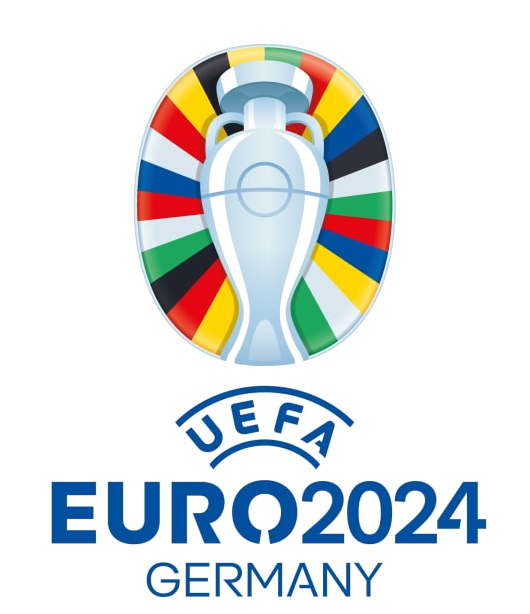 欧洲足球锦标赛 2024
欧洲足球锦标赛 2024
 2011年女子世界杯足球
2011年女子世界杯足球

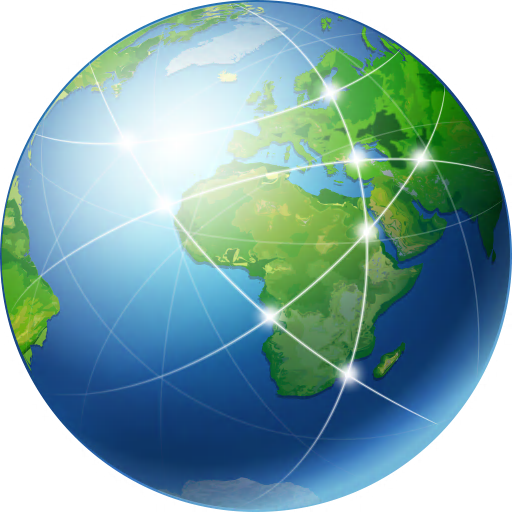 地理
地理

 地理
地理
 *全球最宜居城市
*全球最宜居城市

 历史
历史
 公元 2000 - 2100
公元 2000 - 2100

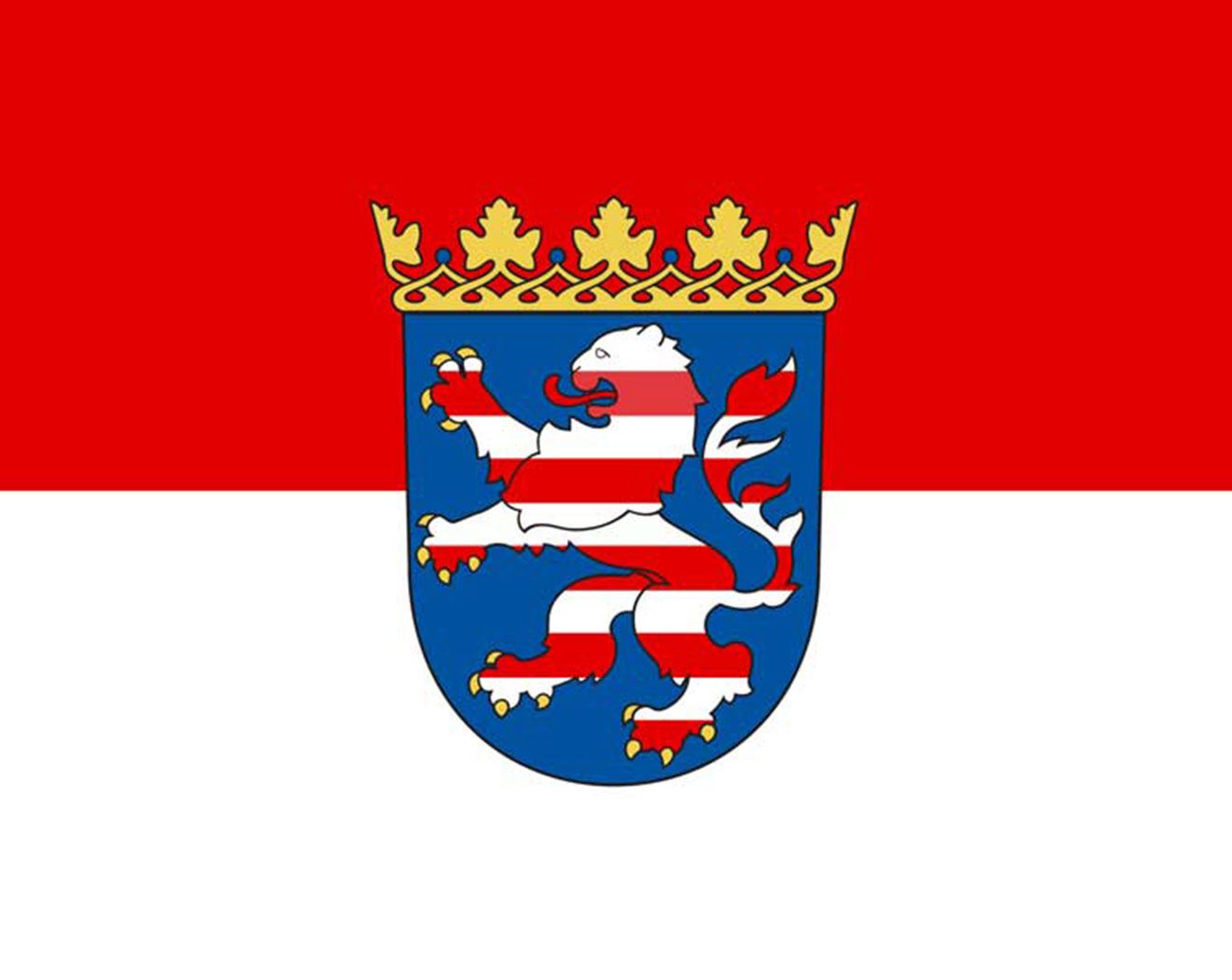 黑森州
黑森州
 丝绸之路
丝绸之路
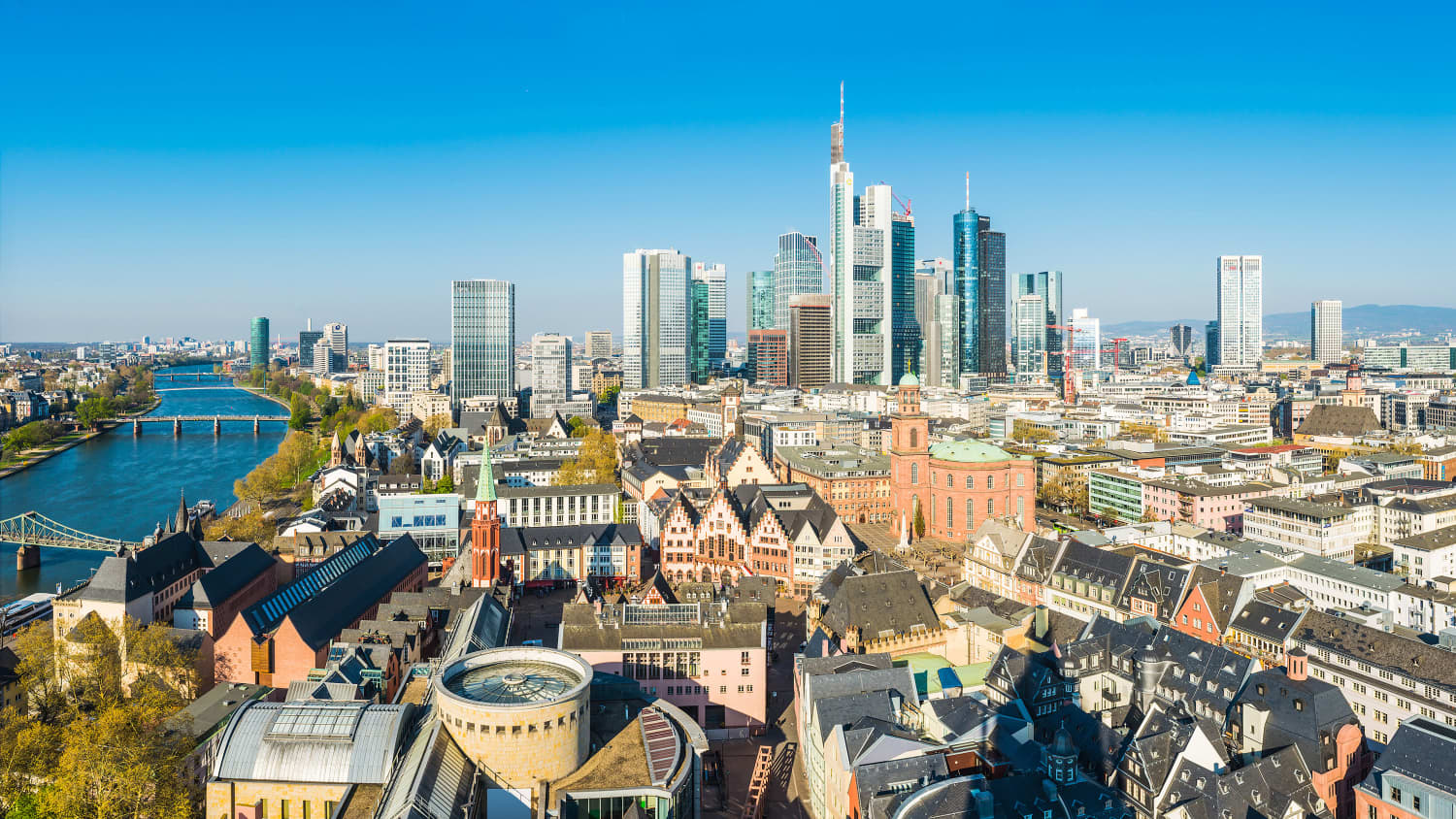
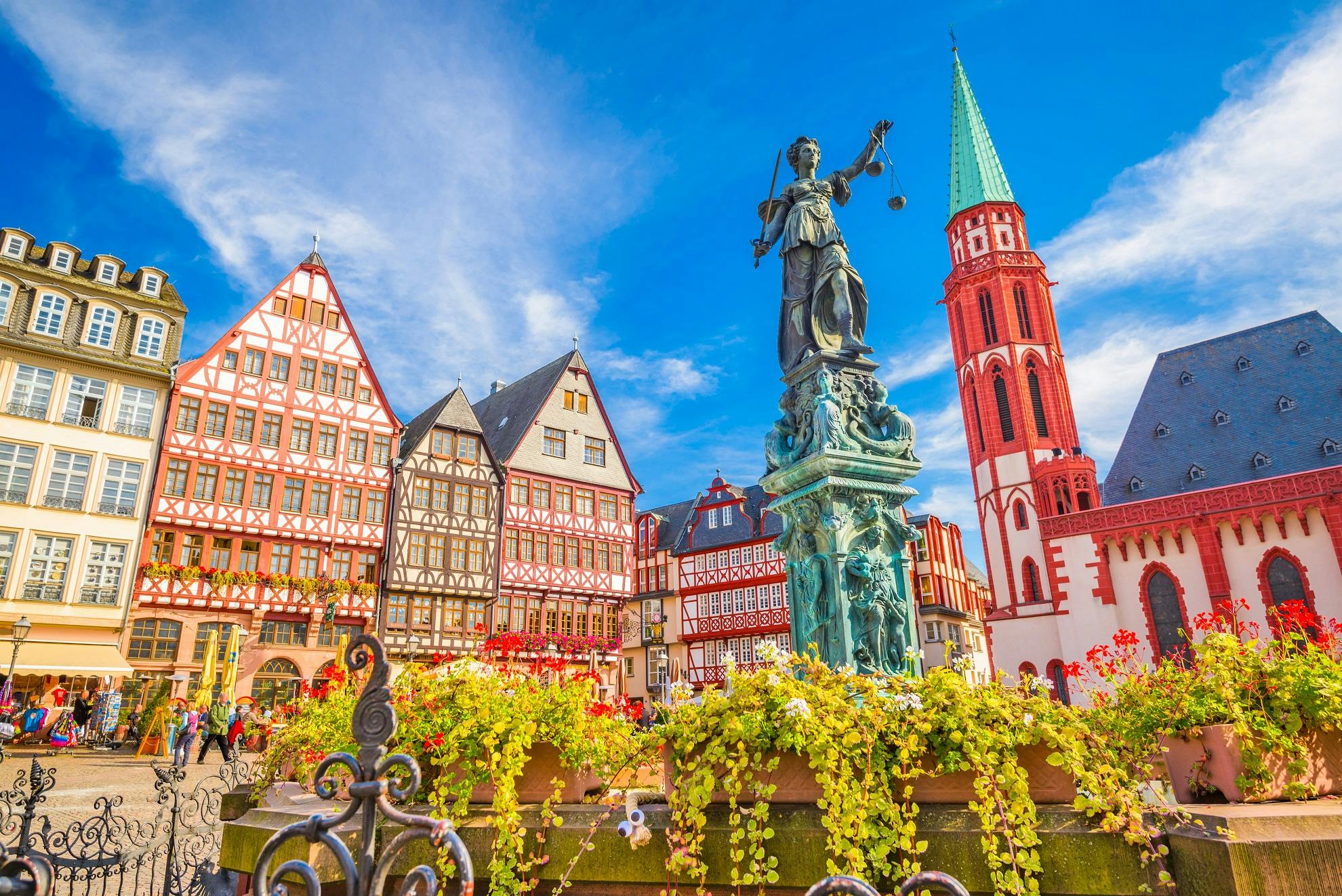
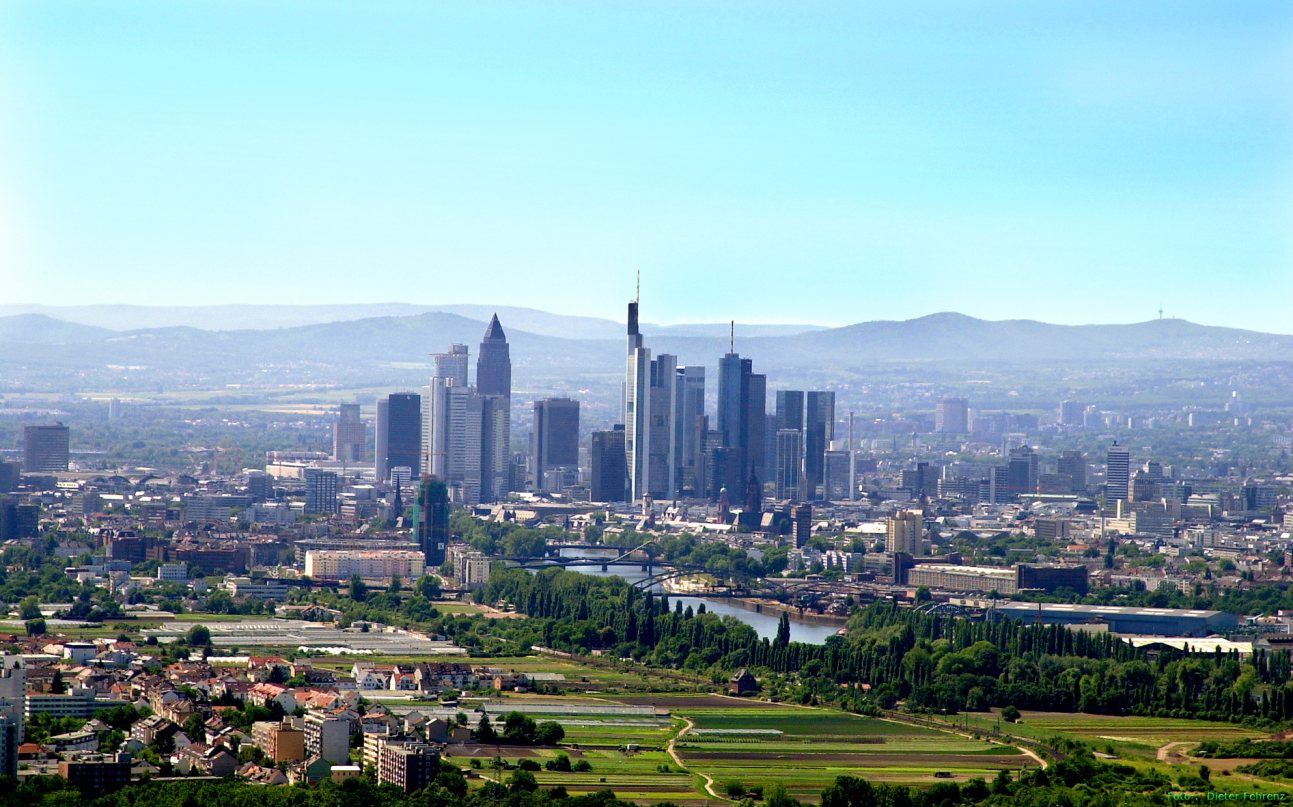
Frankfurt am Main ist mit etwa 736.000 Einwohnern die größte Stadt Hessens und die fünftgrößte Deutschlands. Sie ist kreisfrei und bildet das Zentrum des Ballungsraums Frankfurt mit etwa 2,5 Millionen[2] Einwohnern (mit Offenbach, Hanau und dem Vortaunus). In der gesamten Metropolregion Rhein-Main leben etwa 5,5 Millionen Menschen.
Seit dem Mittelalter gehört Frankfurt am Main zu den bedeutenden städtischen Zentren Deutschlands. Im Jahr 794 erstmals urkundlich erwähnt, war es seit 1372 Freie Reichsstadt und bis 1806 Wahl-, seit 1562 auch Krönungsstadt der römisch-deutschen Kaiser. Der Krönungsweg führte vom Römerberg über den Markt zum Kaiserdom. Von 1815 an war Frankfurt am Main Freie Stadt. Hier tagten die Bundesversammlung des Deutschen Bundes und 1848/49 in der Paulskirche mit der Nationalversammlung das erste deutsche Parlament. Nach dem Deutschen Krieg wurde der zuvor fast 500 Jahre unabhängige Stadtstaat Frankfurt 1866 Bestandteil von Preußen. Durch die rasche Industrialisierung setzte ein Bevölkerungsschub ein. Seit 1875 zählte die Stadt über 100.000 Einwohner, seit 1928 mehr als 500.000, im Jahr 2013 erstmals über 700.000. Als Zeichen der Verpflichtung zur europäischen Einigung nennt sich Frankfurt seit 1998 Europastadt.[3]
Heute ist Frankfurt einer der wichtigsten internationalen Finanzplätze, bedeutendes Industrie-, Dienstleistungs- und Messezentrum und zählt zu den Weltstädten.[4] Frankfurt am Main ist Sitz der Europäischen Zentralbank, der Deutschen Bundesbank, der Frankfurter Wertpapierbörse, zahlreicher Finanzinstitute (darunter Deutsche Bank, Commerzbank, DZ Bank, KfW), der Aufsichtsbehörden BaFin und EIOPA und der Messe Frankfurt. Die Internationale Automobil-Ausstellung, die Frankfurter Buchmesse und die Musikmesse gelten als Weltleitmessen ihrer Sparten. Die Stadt ist zudem Sitz der Sportverbände Deutscher Olympischer Sportbund, Deutscher Fußball-Bund und Deutscher Motor Sport Bund.
Dank seiner zentralen Lage ist Frankfurt am Main ein europäischer Verkehrsknotenpunkt. Der Flughafen gehört zu den größten der Welt, der Hauptbahnhof ist ein zentraler Bahnknotenpunkt und das Frankfurter Kreuz der meistbefahrene Straßenknotenpunkt Deutschlands. Darüber hinaus ist der DE-CIX in Frankfurt, gemessen am Durchsatz, der weltweit größte Internet-Knoten.
Eine Besonderheit für eine europäische Stadt ist die stetig wachsende Hochhaus-Skyline Frankfurts. Wegen der Ballung von Hochhäusern, die zu den höchsten Europas gehören, wird Frankfurt am Main mitunter als Mainhattan bezeichnet. Historische Wahrzeichen der Stadt sind das rekonstruierte Ensemble der Altstadt mit Römerberg samt Rathaus Römer, Dom-Römer-Areal und der Kaiserdom. Mehr als 40 Prozent des Stadtgebiets sind Parks und Landschaftsschutzgebiete, darunter der Frankfurter Grüngürtel mit dem seit 1372 im Besitz der Stadt befindlichen Frankfurter Stadtwald.
Das kulturelle Leben der Stadt ist wesentlich von bürgerlichen Stiftungen, Mäzenatentum und liberalen Privateninitiativen geprägt. Dazu gehören die Städtischen Bühnen mit den beiden Sparten Oper Frankfurt und Schauspiel Frankfurt, das Frankfurter Museumsufer, das Senckenberg Naturmuseum, die Schirn Kunsthalle und das Museum für Moderne Kunst, das Historische Museum und Goethes Geburtshaus in der Altstadt, die Alte Oper, das English Theatre, der Zoo und der Palmengarten. Die 1914 durch eine Bürgerstiftung als Königliche Universität gegründete Goethe-Universität ist die viertgrößte deutsche Hochschule nach Anzahl der Studenten. Sie brachte mehrere Leibniz- und Nobelpreisträger hervor. Darüber hinaus gibt es in der Stadt sieben weitere staatliche, kirchliche und private Hochschulen mit zusammen über 60.000 Studenten.
法兰克福的历史可以上溯到公元前后,那时莱茵河和多瑙河是罗马帝国的北方边界,但两河并不相连,其间无险可守,因此罗马人修筑了连接两河的长城。这座长城连绵数百里,从法兰克福附近经过。于是人们在这里设置了驻军营地,这一带成为边境要塞。随着罗马帝国的崩溃,这时军营圯毁,日渐荒芜,几乎被人遗忘,直到8世纪才再度兴起。传说,一天拂晓,漫天大雾,查理大帝打了败仗,逃到美因河边,找不到向导,无法渡河。危急之中看见一只母鹿,朝水边走来,他注意看那鹿,果然,这只鹿涉水过河了,大军也随之过河,转危为安。为了纪念这件事,查理大帝下令在当地建筑一座城市,取名法兰克福,意思是法兰克人(日耳曼民族中的一支)的渡口。公元794年法兰克福作为查理大帝的行都首次载入史册。此后法兰克福一直是德意志的重要政治舞台,目睹了多少大事件大庆典。神圣罗马帝国时期,皇帝由势力雄厚的诸侯即选帝侯选举。1152年,选帝侯们首次在法兰克福聚会,选聘书巴巴罗萨即红胡子一世为帝。 1356年卡尔四世颁布金牛诏书,正式规定,选皇帝在法兰克福举行。从1562年起,法兰克福又取代亚琛,成为皇帝加冕大曲举行地,前后有10位皇帝在这里加冕,登上皇帝宝座。神圣罗马帝国于1806年正式告终,从1816年到1866年,法兰克福又成为德意志邦联议会所在地。1848年在席卷欧洲大陆的革命风暴中,德意志各邦组成德意志国民议会,在法兰克福举行会议讨论德意志的统一问题,是为德国统一前奏。1866年法兰克福并入普鲁士,结束了从 1372年以来的帝国自由市的自治地位。法兰克福一直是一个繁荣的商业城市,德国统一后,这里工业迅速发展,化学工业尤为突出。德国三大化学工业公司之一的赫希斯特(Hoechst AG)公司就是在法兰克福起家的。1914年法兰克福又创办了约翰。沃尔夫冈·歌德大学(现已发展到3.7万多学生)。第二次世界大战中,33次大轰炸摧毁了法兰克福80%的建筑,留下1700万吨垃圾。千年古城,变为一片废墟。战后法兰克福迅速重建,发展惊人,令人咋舌,今天除化学、电子、机械工业外,第三产业如交通、金融、博览事业更是蓬勃发展,市区一改旧观,高楼林立,法兰克福一跃成为国际知名的大都市。 (Quelle:http://www.youer.com/)
法兰克福(德语:Frankfurt),正式全名为美因河畔法兰克福[1](Frankfurt am Main),是德国中西部黑森州的第一大城市,也是德国第五大城。城区拥有73万2688人[2],如合并周边城镇计算则约有230万人。整个法兰克福-莱茵河-美茵河都会区约有五百万人口,为仅次于莱茵-鲁尔的德国第二大都会区。法兰克福是一个民族文化多元化的城市,一半以上的人口有着移民背景,而四分之一的人口为外国公民。
自中世纪起,法兰克福即为德国的中心城市。公元794年时,法兰克福被授予帝国自由城市的地位。1815年,法兰克福自由市成为德意志州联的政治中心。在1848年革命时期,法兰克福国民议会在圣保罗教堂召开。在普奥战争中,与奥地利结盟的法兰克福被普鲁士王国所吞并后,在1866年正式失去城邦的主权。1875年时,法兰克福居民突破十万人,1928年时则已超过50万人。如今作为阿尔法级别的全球城市,法兰克福是许多欧洲及跨国大型企业的总部所在地。另外德国联邦银行、欧洲中央银行、法兰克福证券交易所及多家大型商业银行总部也设立在此,它是欧盟的经济中心。法兰克福掌握了全德国乃至全欧洲的钜大财富,遂有“美茵河畔曼哈顿”之戏称("Main"hattan 或 Manhattan am Main)[3]。
因其地理位置,法兰克福也是重要的交通枢纽。法兰克福高速立交桥是欧洲最为繁忙的陆路枢纽;火车总站为德国流量第二大的火车站,莱茵-美茵国际机场为德国规模最大的商用民航机场,也是欧洲重要的航空中转站。
法兰克福是歌德的诞生地,这位德国最受景仰的人文思想家,他的名字与德意志文化的传承及传播紧紧相连。法兰克福大学即以歌德为大学命名,德国政府也在世界各地成立“歌德学院”致力于德语教学。歌德在德语文化世界具备国粹瑰宝的地位,让这座城市始终散发着与有荣焉的光彩。
フランクフルト・アム・マイン (Frankfurt am Main) は、ドイツ連邦共和国ヘッセン州に属す郡独立市である。一般にフランクフルトと通称される。人口 72万人を超えるヘッセン州最大の都市(2016年現在)であり[2]、ドイツ全体でもベルリン、ハンブルク、ミュンヘン、ケルンに次ぐ第5の都市である。
中世以来、フランクフルトはドイツの中心都市の一つであった。794年には初めて文献に記録され、中世盛期の帝国自由都市であった。13世紀のライン都市同盟に参加している。
1806年まで神聖ローマ皇帝の選挙が行われる諸侯会議が開催された地であり、1562年以降は皇帝の戴冠式もこの都市で挙行された。1816年からドイツ連邦の議会がフランクフルト自由都市で開催され、1848年から49年にかけてはフランクフルト国民議会が開催された。1866年の普墺戦争により都市国家としての独立を喪失し、プロイセンに併合された。フランクフルトの人口は、1875年に10万人、1928年には50万人を超えた。
現在のフランクフルトは国際金融の中心地であり、工業や産業の中心でもある。経済的側面から世界都市の一つに数えられており[3]、欧州中央銀行、ドイツ連邦銀行、フランクフルト証券取引所、ドイツ銀行、コメルツ銀行、ドイツ復興金融公庫、DZ銀行(英語版)、ヘッセン=テューリンゲン州立銀行(英語版)(ヘラバ)の本社がある。ここに挙げきれない金融機関も多数存在する。
工業・産業・交通の要衝でもある。メッセ・フランクフルトは、世界最大の見本市会場の一つである。フランクフルト空港は世界最大級のハブ空港であり、鉄道についてもヨーロッパ最大級のターミナル駅であるフランクフルト中央駅がある。また、道路においてもフランクフルト・ジャンクションはドイツで最も自動車交通量が多いジャンクションの1つである[4]。フランクフルトの DE-CIX(ドイツ語版) は、データ転送量において世界最大のインターネット中継点である。
Frankfurt, officially the City of Frankfurt am Main (German: [ˈfʁaŋkfʊɐ̯t ʔam ˈmaɪn] ( listen); lit. "Frankfurt on the Main"), is a metropolis and the largest city in the German state of Hesse and the fifth-largest city in Germany. Frankfurt was a city state, the Free City of Frankfurt, for nearly five centuries, and was one of the most important cities of the Holy Roman Empire; it lost its sovereignty in 1866.
listen); lit. "Frankfurt on the Main"), is a metropolis and the largest city in the German state of Hesse and the fifth-largest city in Germany. Frankfurt was a city state, the Free City of Frankfurt, for nearly five centuries, and was one of the most important cities of the Holy Roman Empire; it lost its sovereignty in 1866.
In 2015, Frankfurt had a population of 732,688 within its administrative boundaries,[4] and 2.3 million in its urban area.[2][5] The city is at the centre of the larger Frankfurt Rhine-Main Metropolitan Region, which has a population of 5.5 million[1] and is Germany's second-largest metropolitan region after Rhine-Ruhr. Since the enlargement of the European Union in 2013, the geographic centre of the EU is about 40 km (25 mi) to the east of Frankfurt's central business district, the Bankenviertel. Frankfurt is culturally and ethnically diverse, with around half of the population, and a majority of young people, having a migration background. A quarter of the population are foreign nationals, including many expatriates.
Frankfurt is an alpha world city and a global hub for commerce, culture, education, tourism and transportation. It is the site of many global and European corporate headquarters. Frankfurt Airport is among the world's busiest. Frankfurt is the major financial centre of the European continent, with the headquarters of the European Central Bank, German Federal Bank, Frankfurt Stock Exchange, Deutsche Bank, DZ Bank, KfW, Commerzbank, several cloud and fintech startups[6] and other institutes. Automotive, technology and research, services, consulting, media and creative industries complement the economic base. Frankfurt's DE-CIX is the world's largest internet exchange point. Messe Frankfurt is one of the world's largest trade fairs. Major fairs include the Frankfurt Motor Show, the world's largest motor show, the Music Fair, and the Frankfurt Book Fair, the world's largest book fair.
Frankfurt is home to influential educational institutions, including the Goethe University, the UAS, the FUMPA, and graduate schools like the Frankfurt School of Finance & Management. Its renowned cultural venues include the concert hall Alte Oper, Europe's largest English Theatre and many museums (e.g. the Museumsufer ensemble with Städel and Liebieghaus, Senckenberg Natural Museum, Goethe House), the Schirn art venue at the old town. Frankfurt's skyline is shaped by some of Europe's tallest skyscrapers. The city is also characterised by various green areas and parks, including the central Wallanlagen, the City Forest and two major botanical gardens, the Palmengarten and the University's Botanical Garden. In electronic music, Frankfurt has been a pioneering city since the 1980s, with renowned DJs including Sven Väth, Marc Trauner, Scot Project, Kai Tracid, and the clubs Dorian Gray, U60311, Omen and Cocoon. In sports, the city is known as the home of the top tier football club Eintracht Frankfurt, the basketball club Frankfurt Skyliners, the Frankfurt Marathon and the venue of Ironman Germany.
Francfort-sur-le-Main (Frankfurt am Main en allemand), est une ville d’Allemagne, généralement appelée simplement Francfort malgré le risque de confusion avec la ville de Francfort-sur-l'Oder. Située sur le Main, la ville est, avec ses 731 095 habitants1 (les Francfortois), la cinquième ville d'Allemagne par sa population et la plus grande du Land de Hesse. Son aire urbaine compte 2 517 561 habitants2, dont un tiers ne possède pas la nationalité allemande.
Francfort est la quatrième place financière d'Europe ainsi que la ville la plus riche d'Allemagne avec un PIB par habitant de 85 300 euros. Elle est notamment le siège de la Banque centrale européenne (BCE), de la Banque fédérale allemande (Deutsche Bundesbank) et de la bourse de Francfort. Francfort est également un carrefour majeur européen. Son aéroport international est le troisième d'Europe après l'aéroport Paris-Charles-de-Gaulle et l'aéroport international de Londres Heathrow. La ville se caractérise par un nombre important de gratte-ciel. La ville est parfois surnommée Mainhattan en référence au cours d'eau qui la traverse et au quartier de Manhattan à New York. Son bâtiment le plus élevé est la Commerzbank Tower, siège social du groupe bancaire Commerzbank, culminant hors antenne à 259 mètres, et construit par Norman Foster.
Francfort est considérée à ce titre comme une ville mondiale de premier plan grâce à sa puissance économique, ses infrastructures et sa richesse culturelleNote 1. The Economist classe Francfort première de son classement des 140 villes les plus chères en Allemagne pour un expatrié en 2012 et dixième au monde3. Enfin, la qualité de vie à Francfort est l'une des plus agréables au monde selon le classement Mercer4.
Francoforte sul Meno (in tedesco Frankfurt am Main) è una città extracircondariale della Germania sud-occidentale, la quinta tedesca per numero di abitanti dopo Berlino, Amburgo, Monaco e Colonia. La città di 732 688 abitanti (2,2 milioni nell'area urbana) è al centro di una vasta area metropolitana di 14 800 km² denominata Rhein-Main, con una popolazione che supera i 5,5 milioni di abitanti.
Situata sul fiume Meno, Francoforte è il centro finanziario della Germania e uno dei principali in Europa. Qui hanno sede la Banca centrale europea, la Banca Federale Tedesca e la Borsa di Francoforte (terza al mondo per volume di scambi azionari).
L'aeroporto di Francoforte sul Meno è uno degli scali più trafficati del mondo, la stazione centrale della città è uno dei terminal più grandi in Europa, con oltre 130 milioni di passeggeri annui, e l'interscambio dell'autobahn A3-A5, che si trova nell'area urbana della città, è il più utilizzato del continente.
Francoforte è anche soprannominata "Bankfurt", "Mainhattan" (gioco di parole tra Main, il fiume Meno, e Manhattan, cuore finanziario di New York) o "Big Äppel" (altro riferimento a New York, dove l'Äppelwoi è un tipico prodotto locale).
Fráncfort del Meno2 ( /ˈfʁaŋkfʊɐ̯t am ˈmaɪ̯n/ (?·i) en alemán, Frankfurt am Main), comúnmente llamada Fráncfort,nota 1 es la ciudad más poblada del estado federado de Hesse, Alemania. Con 732 688 habitantes es también la quinta ciudad más grande del país (tras Berlín, Hamburgo, Múnich y Colonia). De acuerdo con Eurostat, la aglomeración urbana de la que Fráncfort forma parte, cuenta con 2 500 000 de habitantes.3Aunque la capital administrativa de Hesse es Wiesbaden, Fráncfort tiene una importancia económica mayor.
/ˈfʁaŋkfʊɐ̯t am ˈmaɪ̯n/ (?·i) en alemán, Frankfurt am Main), comúnmente llamada Fráncfort,nota 1 es la ciudad más poblada del estado federado de Hesse, Alemania. Con 732 688 habitantes es también la quinta ciudad más grande del país (tras Berlín, Hamburgo, Múnich y Colonia). De acuerdo con Eurostat, la aglomeración urbana de la que Fráncfort forma parte, cuenta con 2 500 000 de habitantes.3Aunque la capital administrativa de Hesse es Wiesbaden, Fráncfort tiene una importancia económica mayor.
Desde la Edad Media Fráncfort se encuentra entre los centros urbanos más importantes de Alemania. Su nombre aparece por primera vez mencionado en el año 794. Desde la Alta Edad Media fue Ciudad Imperial Libre, hasta 1806 era la ciudad en que se elegía al emperador y desde 1562 también la ciudad en que se coronaba al emperador alemán del Sacro Imperio Romano Germánico. Entre 1816 y 1866 fue sede de la Confederación Germánica y en 1848/49, del primer parlamento alemán libremente elegido.
En la época actual Fráncfort es un centro económico y financiero importante en Europa (en ocasiones se le denomina inoficialmente «capital económica y financiera de la Unión Europea».4 La ciudad aloja al Banco Central Europeo (BCE), al Deutsche Bundesbank, a la Bolsa de Fráncfort y a la Messe Frankfurt, esta última, sede de importantes exposiciones, ferias y salones internacionales, entre otras, el Salón del Automóvil de Fráncfort, el más grande de su género, o el de la Feria del libro, la más importante del mundo.
Debido a su ubicación céntrica, Fráncfort es un nudo de transporte muy relevante en Europa. Dan cuenta de ello las instalaciones del Aeropuerto de Fráncfort, la Estación Central de Fráncfort del Meno y el nudo de autopistas más denso del mundo.5 La ciudad alcanzó por primera vez los 100 000 habitantes en 1875, en 1928 llegó a sumar por primera vez 500 000. En las regiones más cercanas a Fráncfort viven actualmente cerca de 1 800 000 habitantes, en toda la región del Rin-Meno 5 800 000.
Una particularidad de Fráncfort entre las ciudades alemanas es la concentración de edificios de altura en el centro, que dibujan un perfil característico, conocido localmente como la Frankfurter Skyline. Debido a estos rascacielos, que se cuentan entre los edificios más altos de Europa, se ha ganado el apodo de Mainhattan. Entre los edificios históricos que constituyen los símbolos de la ciudad se cuenta el casco antiguo reconstruido en el Römerberg y que incluye el Römer (edificio que aloja al Ayuntamiento de la ciudad) y la Catedral Imperial de San Bartolomé. Más del 40 % del área de la ciudad está cubierta por parques y áreas verdes protegidas, entre ellas, el «cinturón verde de Fráncfort» que incluye un bosque emplazado en terrenos que desde 1372 pertenecen a la ciudad.
Las instituciones ciudadanas e infraestructura tradicional que frecuentemente tuvieron su origen en fundaciones e iniciativas privadas desempeñan un papel significativo en la vida cultural de la ciudad. Se incluyen aquí las salas de espectáculos de la ciudad (Städtischen Bühnen, que alberga dos instituciones: la Ópera de Fráncfort y el Teatro de Fráncfort), la orilla de los museos (Museumsufer), el Museo Senckenberg de Historia Natural, la Schirn Kunsthalle y el Museum für Moderne Kunst (museo de arte contemporáneo), el Historisches Museum Frankfurt (museo histórico de Fráncfort), la casa natal de Goethe (Goethe-Haus, el teatro inglés (The English Theatre Frankfurt), el zoológico de Fráncfort y el jardín botánico (Palmengarten). La Universidad Johann Wolfgang Goethe fue fundada en 1914 y es, según el número de estudiantes, la cuarta más grande de Alemania. Varios galardonados con los Nobel y Leibniz se formaron en sus aulas. Además hay otras siete universidades e instituciones de educación superior en Fráncfort que en conjunto suman una matrícula de 60 000 estudiantes.
Фра́нкфурт-на-Ма́йне (нем. Frankfurt am Main [ˈfʁaŋkfʊɐ̯t ʔam ˈmaɪn] (инф.)), часто называемый просто Франкфурт — крупнейший город земли Гессен и пятый по величине в Германии с населением в 732 тыс. человек (по состоянию на 2015 год).
Город является центром крупного региона-метрополии Рейн — Майн (нем. Rhein-Main-Gebiet) с населением в 5,6 млн человек[4], второго по величине региона Германии. Город расположен на древней переправе (нем. «furt») на

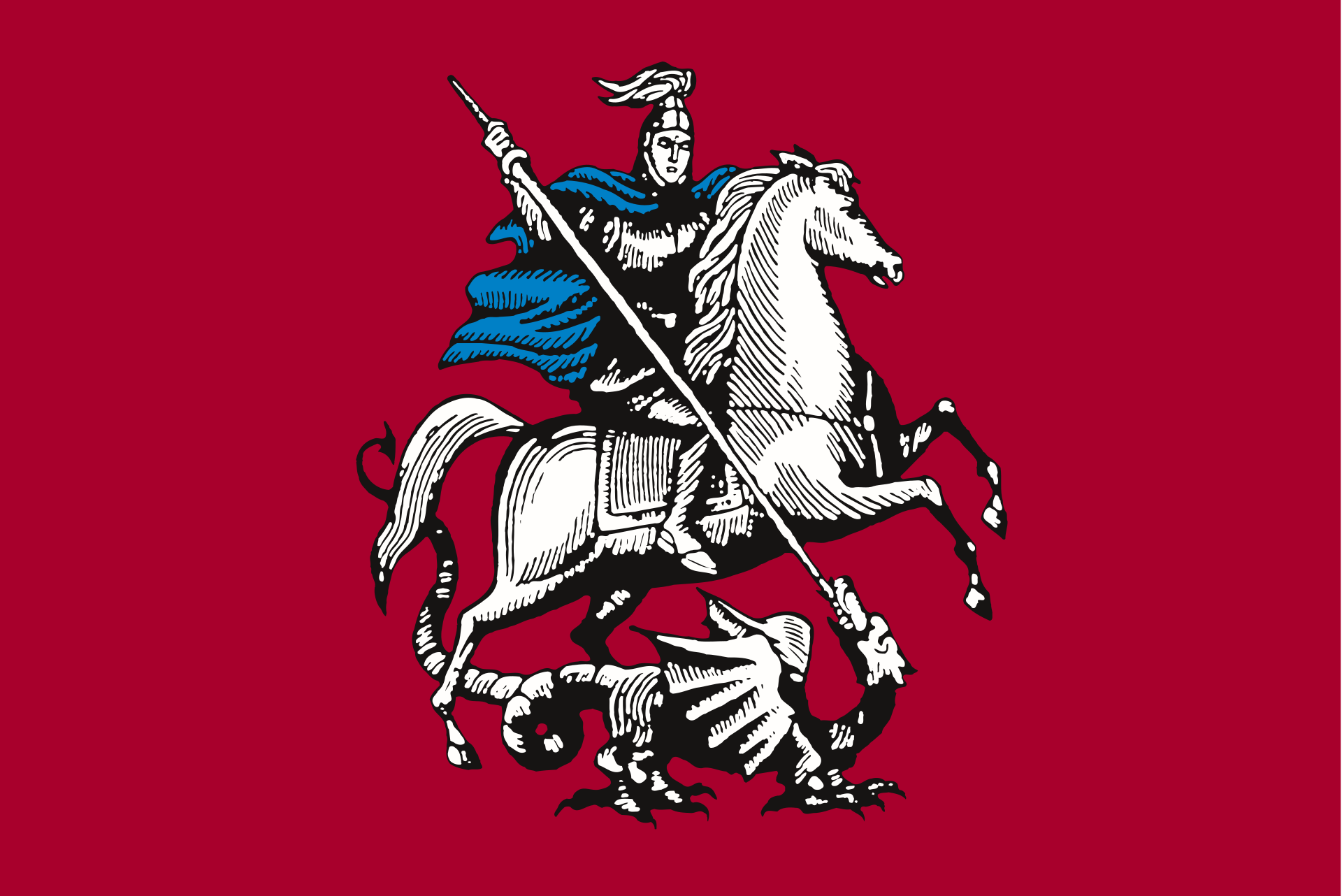 *莫斯科
*莫斯科
 欧洲流行歌曲大赛
欧洲流行歌曲大赛
 2018年世界杯足球赛
2018年世界杯足球赛
 2018年世界杯足球赛
2018年世界杯足球赛
 A组
A组
 2018年世界杯足球赛
2018年世界杯足球赛
 F组
F组
 2018年世界杯足球赛
2018年世界杯足球赛
 B组
B组
 2018年世界杯足球赛
2018年世界杯足球赛
 C组
C组
 2018年世界杯足球赛
2018年世界杯足球赛
 D组
D组
 2018年世界杯足球赛
2018年世界杯足球赛
 H组
H组
 2018年世界杯足球赛
2018年世界杯足球赛
 G组
G组
 2018年世界杯足球赛
2018年世界杯足球赛
 E组
E组

 历史
历史
 夏季奥林匹克运动会
夏季奥林匹克运动会
 俄罗斯
俄罗斯
 丝绸之路
丝绸之路
 上海合作组织
上海合作组织

 文化遗产
文化遗产

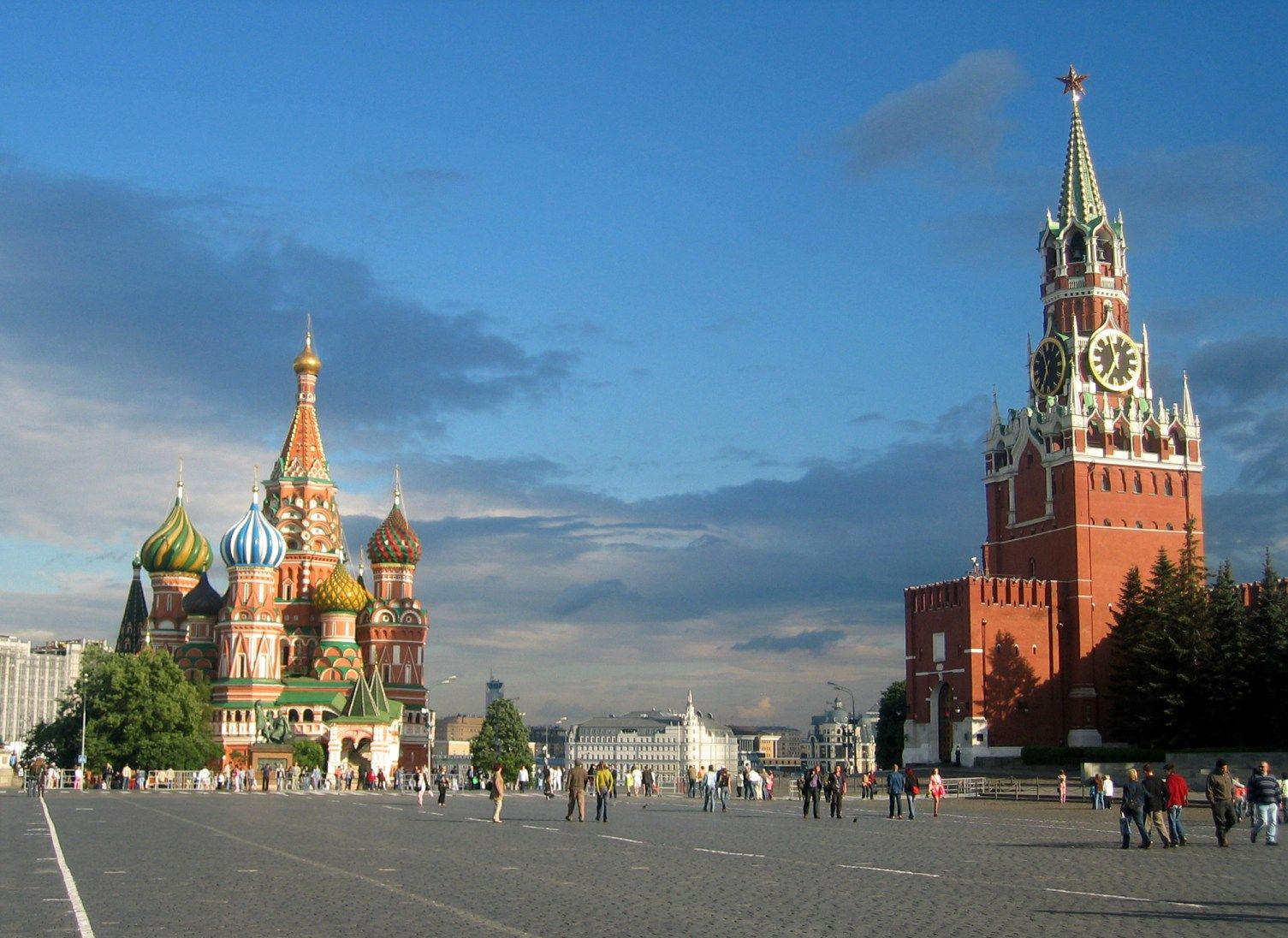
Moskau (russisch Москва́  [mɐskˈva], Moskwa) ist die Hauptstadt der Russischen Föderation und mit rund 12,4 Millionen Einwohnern (Stand 2017)[1] die zweitgrößte Stadt bzw. mit 15,1 Millionen (2012)[2] die größte Agglomeration Europas.
[mɐskˈva], Moskwa) ist die Hauptstadt der Russischen Föderation und mit rund 12,4 Millionen Einwohnern (Stand 2017)[1] die zweitgrößte Stadt bzw. mit 15,1 Millionen (2012)[2] die größte Agglomeration Europas.
Moskau ist das politische, wirtschaftliche, wissenschaftliche und kulturelle Zentrum Russlands, mit Universitäten und Instituten sowie zahlreichen Kirchen, Theatern, Museen und Galerien. Im Stadtgebiet befinden sich einige der höchsten europäischen Hochhäuser und die markanten Sieben Schwestern, sowie der 540 Meter hohe Ostankino-Turm, das höchste Bauwerk Europas. Moskau ist Sitz der Russisch-Orthodoxen Kirche, der Patriarch residiert im Danilow-Kloster, das größte russisch-orthodoxe Kirchengebäude ist die Moskauer Christ-Erlöser-Kathedrale. Es gibt im Stadtgebiet von Moskau über 300 Kirchen.[3]
Der Kreml und der Rote Platz im Zentrum Moskaus stehen seit 1990 auf der UNESCO-Liste des Weltkulturerbes. Mit acht Fernbahnhöfen, drei internationalen Flughäfen und drei Binnenhäfen ist die Stadt wichtigster Verkehrsknoten und größte Industriestadt Russlands.
莫斯科(俄语:Москва,罗马化:Moskva,IPA:[mɐsˈkva] ![]() 聆听)是俄罗斯首都与最大都市、以及莫斯科州首府,为俄罗斯全国政治、经济、科学、文化及交通的中心。面积2,510平方公里,与莫斯科州和卡卢加州接壤。城区人口约1200万,是欧洲人口第二多的城市,仅次于伊斯坦布尔,占俄罗斯总人口的1/10。
聆听)是俄罗斯首都与最大都市、以及莫斯科州首府,为俄罗斯全国政治、经济、科学、文化及交通的中心。面积2,510平方公里,与莫斯科州和卡卢加州接壤。城区人口约1200万,是欧洲人口第二多的城市,仅次于伊斯坦布尔,占俄罗斯总人口的1/10。
莫斯科沿莫斯科河而建,由1147年的莫斯科大公时代开始,在沙皇俄国、苏联及今日的俄罗斯联邦时代,都一直担任著国家首都的角色。它是历史悠久的克里姆林宫所在地,并做为上述政权的总部,是俄罗斯数个被列入世界遗产的建筑群之一。
モスクワ(ロシア語:Москва́ IPA: [mɐˈskva] マスクヴァー、 発音[ヘルプ/ファイル])は、ロシア連邦の首都。連邦市として市単独でロシア連邦を構成する83の連邦構成主体のひとつとなっており、周囲を占めるモスクワ州の州都でもある。ただし州とは区別され「モスクワ市」(Город Москва)となる。人口は約1250万人でヨーロッパで最も人口の多い都市であり、世界有数の世界都市である。漢字による当て字は莫斯科。英語で発音した場合には、モスコーあるいはモスカウ(Moscow [ˈmɒskoʊ, ˈmɒskaʊ])のようになる。
発音[ヘルプ/ファイル])は、ロシア連邦の首都。連邦市として市単独でロシア連邦を構成する83の連邦構成主体のひとつとなっており、周囲を占めるモスクワ州の州都でもある。ただし州とは区別され「モスクワ市」(Город Москва)となる。人口は約1250万人でヨーロッパで最も人口の多い都市であり、世界有数の世界都市である。漢字による当て字は莫斯科。英語で発音した場合には、モスコーあるいはモスカウ(Moscow [ˈmɒskoʊ, ˈmɒskaʊ])のようになる。
Moscow (/ˈmɒskoʊ, -kaʊ/; Russian: Москва́, tr. Moskvá, IPA: [mɐˈskva] ( listen)) is the capital and most populous city of Russia, with 13.2 million residents within the city limits[11] and 17.1 million within the urban area.[12] Moscow is one of Russia's three federal cities.
listen)) is the capital and most populous city of Russia, with 13.2 million residents within the city limits[11] and 17.1 million within the urban area.[12] Moscow is one of Russia's three federal cities.
Moscow is a major political, economic, cultural, and scientific centre of Russia and Eastern Europe, as well as the largest city (both by population and by area) entirely on the European continent. By broader definitions Moscow is among the world's largest cities, being the 14th largest metro area, the 18th largest agglomeration, the 14th largest urban area, and the 11th largest by population within city limits worldwide. According to Forbes 2013,[13] Moscow has been ranked as the ninth most expensive city in the world by Mercer and has one of the world's largest urban economies, being ranked as an alpha global city according to the Globalization and World Cities Research Network, and is also one of the fastest growing tourist destinations in the world according to the MasterCard Global Destination Cities Index.
Moscow is the northernmost and coldest megacity and metropolis on Earth. It is home to the Ostankino Tower, the tallest free standing structure in Europe; the Federation Tower, the tallest skyscraper in Europe; and the Moscow International Business Center. By its territorial expansion on July 1 2012 southwest into the Moscow Oblast, the area of the capital more than doubled, going from 1,091 to 2,511 square kilometers (421 to 970 sq mi), resulting in Moscow becoming the largest city on the European continent by area; it also gained an additional population of 233,000 people[14][15]
Moscow is situated on the Moskva River in the Central Federal District of European Russia, making it Europe's most populated inland city. The city is well known for its architecture, particularly its historic buildings such as Saint Basil's Cathedral with its colourful architectural style. With over 40 percent of its territory covered by greenery, it is one of the greenest capitals and major cities in Europe and the world, having the largest forest in an urban area within its borders—more than any other major city—even before its expansion in 2012. The city has served as the capital of a progression of states, from the medieval Grand Duchy of Moscow and the subsequent Tsardom of Russia to the Russian Empire to the Soviet Union and the contemporary Russian Federation.
Moscow is the seat of power of the Government of Russia, being the site of the Moscow Kremlin, a medieval city-fortress that is today the residence for work of the President of Russia. The Moscow Kremlin and Red Square are also one of several World Heritage Sites in the city. Both chambers of the Russian parliament (the State Duma and the Federation Council) also sit in the city. Moscow is considered the centre of Russian culture, having served as the home of Russian artists, scientists and sports figures and because of the presence of museums, academic and political institutions and theatres.
The city is served by a transit network, which includes four international airports,[16] nine railway terminals, numerous trams, a monorail system and one of the deepest underground rapid transit systems in the world, the Moscow Metro, the fourth-largest in the world and largest outside Asia in terms of passenger numbers, and the busiest in Europe. It is recognised as one of the city's landmarks due to the rich architecture of its 200 stations.[citation needed]
Moscow has acquired a number of epithets, most referring to its size and preeminent status within the nation: The Third Rome (Третий Рим), The Whitestone One (Белокаменная), The First Throne (Первопрестольная), The Forty Forties (Сорок Сороков) (The Forty Soroks, "sorok" translates as forty, but here it is old name of district or parish, and "forty" in old Russian means not 40, but "great many"). Moscow is one of the twelve Hero Cities. In old Russian the word "Сорок" (forty) also meant a church administrative district, which consisted of about forty churches. The demonym for a Moscow resident is "москвич" (moskvich) for male or "москвичка" (moskvichka) for female, rendered in English as Muscovite.
Moscou (en russe : Москва, Moskva, API : /mɐˈskva/) est la capitale de la Russie et compte douze millions d'habitants intra muros (2017) sur une superficie de 2 510 km2 ce qui en fait la ville la plus peuplée à la fois du pays et d'Europe. Sur le plan administratif Moscou fait partie du district fédéral central et a le statut de ville d'importance fédérale qui lui donne le même niveau d'autonomie que les autres sujets de la Russie. Elle est enclavée dans l'oblast de Moscou, mais en est administrativement indépendante. Ses habitants sont les Moscovites. Moscou se situe dans la partie européenne de la Russie au milieu d'une région de plaine. Sa latitude élevée lui vaut un climat froid et continental. Le Kremlin, son cœur historique, est édifié sur une colline qui domine la rive gauche de la rivière Moskova.
Moscou a joué un rôle central dans l'histoire de la Russie. Petit point d'appui militaire créé vers 1150 dans le nord de la Rus' de Kiev, elle prend progressivement le relais de Kiev, après la décomposition politique de cet État et les invasions mongoles du XIIIe siècle. Elle devient la capitale du Grand-duché de Moscou puis de l'Empire russe qui étend progressivement son territoire jusqu'à la frontière avec la Pologne à l'ouest, la Crimée au sud et l'océan Pacifique à l'est. Elle perd son rôle de capitale au profit de Saint-Pétersbourg lorsque Pierre le Grand au début du XVIIIe siècle décide de moderniser son pays à marche forcée. Néanmoins, au cours des XVIIIe et XIXe siècles, Moscou devient un centre industriel majeur et le cœur du réseau de communications ferré et routier d'un pays qui compte désormais parmi les grandes puissances européennes. La Révolution d'Octobre en 1917 redonne le rôle de capitale à Moscou et met en place un régime communiste qui accélère en deux décennies l'industrialisation de la ville et quadruple la population qui passe de un à quatre millions habitants. Ayant échappé de peu à l'occupation allemande durant la Seconde Guerre mondiale, la ville renoue avec une croissance économique et démographique effrénée à l'issue de celle-ci. Elle devient la capitale d'une des deux superpuissances mondiales. L'effondrement du régime communiste en 1991 entraine une profonde transformation de la ville qui abandonne presque complètement son rôle de centre industriel au profit d'une position de pôle tertiaire complètement converti à l'économie de marché. La construction du Centre de commerce international de Moscou est le symbole de cette transformation.
Moscou concentre une part particulièrement importante de la richesse économique du pays : elle produit 25 % du PIB de la Russie. La ville est le siège de nombreuses institutions universitaires et culturelles du pays. Mais cette mutation ne s'est pas faite sans poser de problèmes. Les écarts socio-économiques étant devenus considérables : une part de la population s'est fortement enrichie, tandis que l'augmentation du coût de la vie a aggravé les conditions de vie des plus modestes. Moscou a du mal à adapter ses structures routières à l'explosion du parc des véhicules des particuliers et à une croissance démographique qui se poursuit dans un contexte national pourtant déprimé sur ce plan.
Moscou dispose d'un important patrimoine artistique et architectural dont trois ensembles inscrits au Patrimoine mondial de l'Unesco. Ce sont notamment le Kremlin avec ses palais et églises, la cathédrale Saint-Basile-le-Bienheureux sur la place Rouge, la Galerie Tretiakov, le couvent de Novodievitchi, l'église de Kolomenskoïe ainsi que les sept gratte-ciel staliniens.
Moscú (en ruso, Москва,  /mɐˈskva/ (?·i) transliterado como Moskvá) es la capital y la entidad federal más poblada de Rusia. La ciudad es un importante centro político, económico, cultural y científico de Rusia y del continente. Moscú es la megaciudad más septentrional de la Tierra, la segunda ciudad de Europa en población después de Estambul,345 y la sexta del mundo. Su población es de 12 108 2576 habitantes. En virtud de su expansión territorial al suroeste del óblast de Moscú, el 1 de julio de 2012 la capital aumentó su área en 2,5 veces, desde unos 1000 km² hasta 2500 km², y ganó una población adicional de 230 000 habitantes.7
/mɐˈskva/ (?·i) transliterado como Moskvá) es la capital y la entidad federal más poblada de Rusia. La ciudad es un importante centro político, económico, cultural y científico de Rusia y del continente. Moscú es la megaciudad más septentrional de la Tierra, la segunda ciudad de Europa en población después de Estambul,345 y la sexta del mundo. Su población es de 12 108 2576 habitantes. En virtud de su expansión territorial al suroeste del óblast de Moscú, el 1 de julio de 2012 la capital aumentó su área en 2,5 veces, desde unos 1000 km² hasta 2500 km², y ganó una población adicional de 230 000 habitantes.7
Moscú está situada a orillas del río Moscova, en el Distrito Federal Central de la Rusia europea. En el curso de su historia, la ciudad ha sido capital de una sucesión de estados, desde el Gran Ducado de Moscú de la Edad Media, el Zarato ruso y la Unión Soviética, exceptuando el período del Imperio ruso. En Moscú se encuentra el Kremlin de Moscú, una antigua fortaleza donde se halla hoy el lugar de trabajo del presidente de Rusia. El Kremlin también es uno de los varios sitios que son Patrimonio de la Humanidad en la ciudad.8 Ambas cámaras del Parlamento ruso (la Duma Estatal y el Consejo de la Federación) también tienen su sede en Moscú.
La ciudad posee una amplia red de transporte que incluye tres aeropuertos internacionales, nueve estaciones de ferrocarril y uno de los más profundos sistemas de metro del mundo, el metro de Moscú, solo superado por el de Tokio en número de pasajeros. Su suburbano es reconocido como uno de los más ricos y variados arquitectónicamente en sus 215 estaciones, repartidas por la ciudad. Según la publicación Forbes 2011, Moscú es la segunda ciudad del mundo en número de multimillonarios.
Москва́ (произношение (инф.)) — столица России, город федерального значения, административный центр Центрального федерального округа и центр Московской области, в состав которой не входит. Крупнейший по численности населения город России и её субъект — 12 630 289[2] чел. (2019), самый населённый из городов, полностью расположенных в Европе, входит в десятку городов мира по численности населения[5], крупнейший русскоязычный город в мире. Центр Московской городской агломерации.
Историческая столица Великого княжества Московского, Русского царства, Российской империи (в 1728—1730 годах), Советской России и СССР. Город-герой. В Москве находятся федеральные органы государственной власти Российской Федерации (за исключением Конституционного суда), посольства иностранных государств, штаб-квартиры большинства крупнейших российских коммерческих организаций и общественных объединений.
Расположена на реке Москве в центре Восточно-Европейской равнины, в междуречье Оки и Волги. Как субъект федерации Москва граничит с Московской и Калужской областями.
Москва — популярный туристический центр России. Кремль, Красная площадь, Новодевичий монастырь и Церковь Вознесения в Коломенском входят в список объектов всемирного наследия ЮНЕСКО[6]. Она является важнейшим транспортным узлом: город обслуживают 6 аэропортов, 9 железнодорожных вокзалов, 3 речных порта (имеется речное сообщение с морями бассейнов Атлантического и Северного Ледовитого океанов). С 1935 года в Москве работает метрополитен. Москва — спортивный центр страны. В 1980 году в Москве прошли XXII летние Олимпийские игры, а в 2018 город стал одним из хозяев чемпионата мира по футболу.

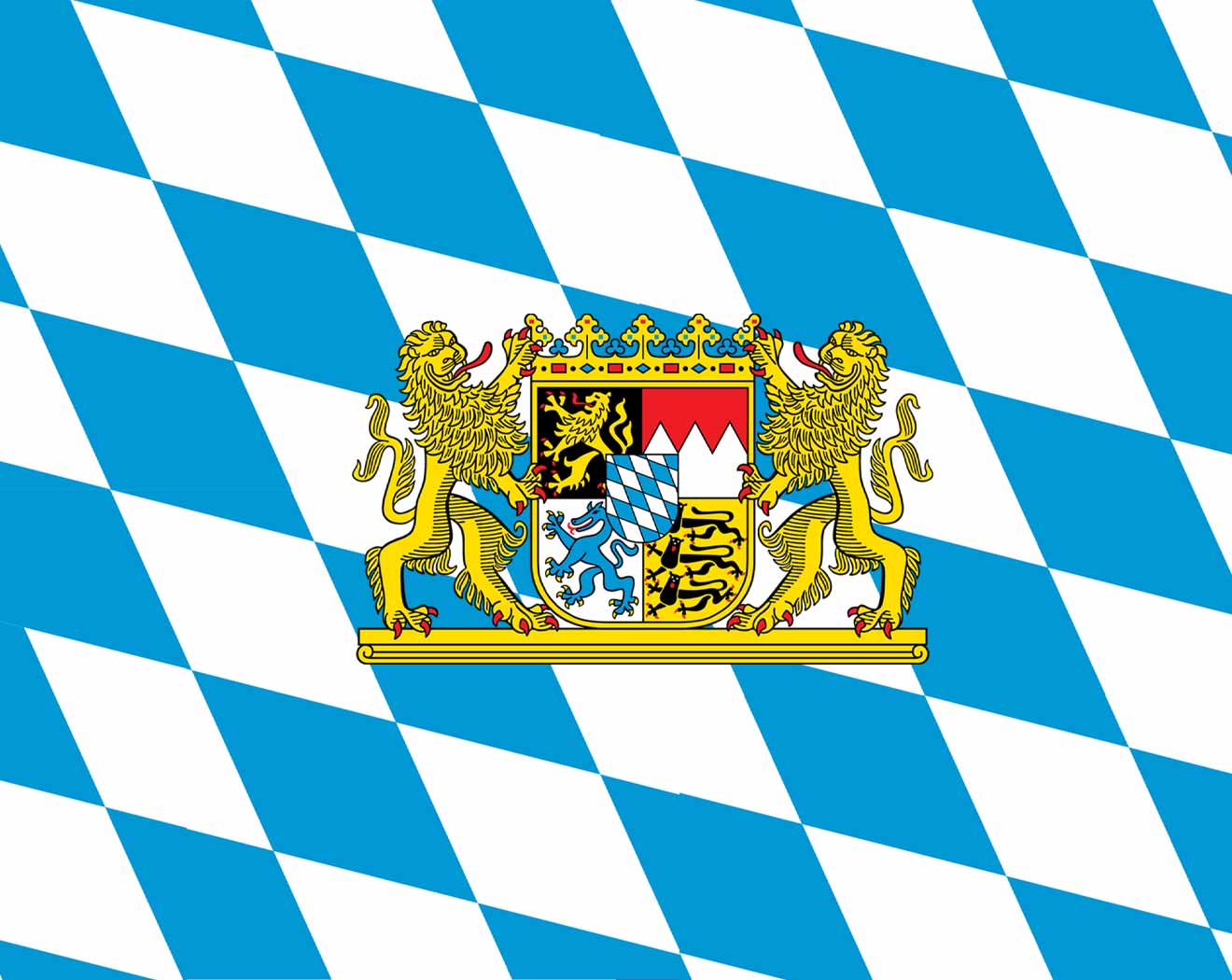 巴伐利亚州
巴伐利亚州
 联邦德国
联邦德国
 欧洲流行歌曲大赛
欧洲流行歌曲大赛
 2006年世界杯足球赛
2006年世界杯足球赛
 欧洲足球锦标赛 2020
欧洲足球锦标赛 2020

 欧洲足球锦标赛 2024
欧洲足球锦标赛 2024

 地理
地理

 地理
地理
 *全球最宜居城市
*全球最宜居城市

 历史
历史
 公元 1500 - 2000
公元 1500 - 2000

 历史
历史
 公元 1000 - 1500
公元 1000 - 1500

 历史
历史
 公元 2000 - 2100
公元 2000 - 2100

 国际城市
国际城市
 ***全球城市经济竞争力
***全球城市经济竞争力
 夏季奥林匹克运动会
夏季奥林匹克运动会
 1972夏季奥林匹克运动会
1972夏季奥林匹克运动会
 丝绸之路
丝绸之路
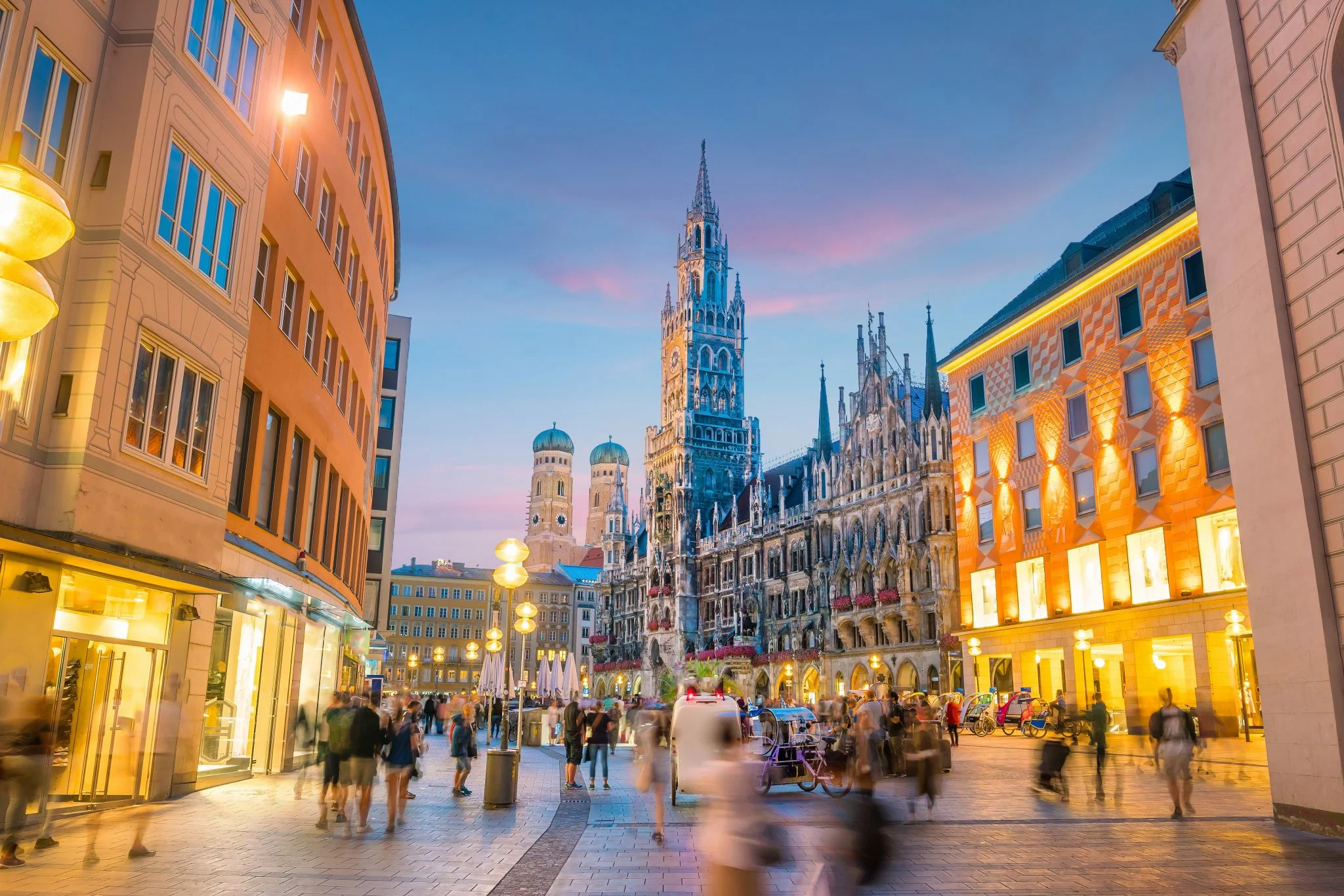
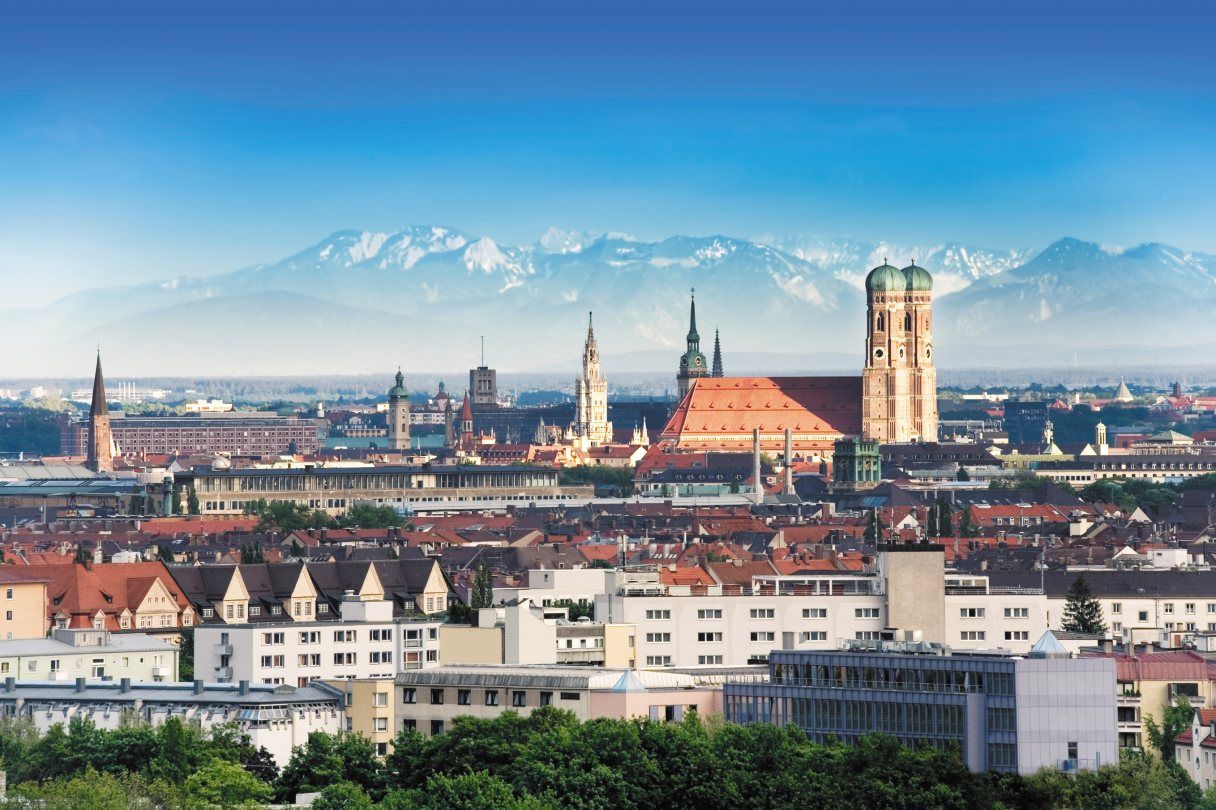
München (hochdeutsch  [ˈmʏnçn̩] oder [ˈmʏnçən̩];[4] bairisch
[ˈmʏnçn̩] oder [ˈmʏnçən̩];[4] bairisch  Minga?/i [ˈmɪŋ(:)ɐ]) ist die Landeshauptstadt des Freistaates Bayern. Sie ist mit rund 1,5 Millionen Einwohnern die einwohnerstärkste Stadt Bayerns und (nach Berlin und Hamburg) die nach Einwohnern drittgrößte Gemeinde Deutschlands sowie die viertgrößte Stadt im deutschsprachigen Raum und zwölftgrößte der Europäischen Union. Im Ballungsraum München leben mehr als 2,9 Millionen Menschen,[5][6] die flächengrößere europäische Metropolregion München umfasst rund 5,7 Millionen Einwohner.
Minga?/i [ˈmɪŋ(:)ɐ]) ist die Landeshauptstadt des Freistaates Bayern. Sie ist mit rund 1,5 Millionen Einwohnern die einwohnerstärkste Stadt Bayerns und (nach Berlin und Hamburg) die nach Einwohnern drittgrößte Gemeinde Deutschlands sowie die viertgrößte Stadt im deutschsprachigen Raum und zwölftgrößte der Europäischen Union. Im Ballungsraum München leben mehr als 2,9 Millionen Menschen,[5][6] die flächengrößere europäische Metropolregion München umfasst rund 5,7 Millionen Einwohner.
Die Landeshauptstadt ist eine kreisfreie Stadt und bayerische Metropole,[7] zudem Verwaltungssitz des die Stadt umgebenden gleichnamigen Landkreises mit dem Landratsamt München als Verwaltung, des Bezirks Oberbayern und des Regierungsbezirks Oberbayern.
München wird zu den Weltstädten gezählt.[8] Die Metropole ist eine der wirtschaftlich erfolgreichsten und am schnellsten wachsenden Europas. Sie ist Sitz zahlreicher Konzerne, darunter fünf DAX-Unternehmen (Allianz, BMW, Linde, Munich Re, Siemens). Hier befindet sich die einzige Börse Bayerns. In der Städteplatzierung des Beratungsunternehmens Mercer belegte München im Jahr 2018 unter 231 Großstädten weltweit den dritten Platz nach Lebensqualität.[9] Laut dem Magazin Monocle war es 2018 sogar die lebenswerteste Stadt der Welt.[10] Andererseits wird die Lebensqualität zunehmend durch Agglomerationsnachteile, wie Verkehrs- und Umweltbelastung sowie sehr hohe Wohneigentumspreise und Mieten[11][12] eingeschränkt, weshalb auch die Wohnfläche pro Einwohner weit unter dem Bundesdurchschnitt liegt.[13] München gilt als sicherste Kommune unter den deutschen Großstädten über 200.000 Einwohnern hinsichtlich der Kriminalitätsrate aller Straftaten.[14]
München wurde 1158 erstmals urkundlich erwähnt.[15] Die Stadt wurde 1255 bayerischer Herzogssitz, war von 1328 bis 1347 kaiserliche Residenzstadt und wurde 1506 alleinige Hauptstadt Bayerns. München ist Sitz zahlreicher nationaler und internationaler Behörden sowie wichtiger Universitäten und Hochschulen, bedeutender Museen und Theater. Durch eine große Anzahl sehenswerter Bauten samt geschützten Baudenkmälern und Ensembles, internationaler Sportveranstaltungen, Messen und Kongresse sowie das weltbekannte Oktoberfest ist München ein Anziehungspunkt für den internationalen Tourismus.
In der Städteplatzierung des Beratungsunternehmens Mercer belegte München im Jahr 2012 unter fünfzig Großstädten weltweit nach Infrastruktur den zweiten und nach Lebensqualität den vierten Platz.
慕尼黑位于德国南部阿尔卑斯山北麓的伊萨尔河畔,是德国南部第一大城,全德国第三大城市,仅次于首都柏林与北部最大城市汉堡。是德国主要的经济、文化、科技和交通中心之一,也是欧洲最繁荣的城市之一。慕尼黑同时又保留着原巴伐利亚王国都城的古朴风情,被人们称作“百万人的村庄”,是生物工程学、软件及服务业的中心。拥有各大公司的总部和许多跨国公司的欧洲总部。
慕尼黑是德国第二大金融中心(仅次于法兰克福),慕尼黑是欧洲最大的出版中心,拥有德国最大的日报之一《南德意志报》,以及许多出版社(仅次于纽约市)。
慕尼黑(德语:München)是德国巴伐利亚州的首府。慕尼黑分为老城与新城两部分,总面积达310平方千米。它是德国南部第一大城,全德国第三大城市,排在柏林与汉堡之后,总人口约130万,有“百万人的村落”的美称。慕尼黑位于德国南部,是巴伐利亚州的文化中心兼首府。它享有“欧洲建筑博物馆”的美誉,哥特式、古罗马式、巴洛克式古建筑以及各式现代化的建筑比比皆是,圣母教堂、路德维希大街是这座城市不可遗忘的部分。自中世纪起,慕尼黑就以啤酒而闻名。是世界第三大啤酒生产地。一年一度的啤酒节让整个城市都沉浸在欢乐的气氛中。这里还是高科技产业中心,宝马、西门子等世界性的大企业总公司就设在慕尼黑。慕尼黑工科大学的科研开发堪称世界一流 。
ミュンヘン(ドイツ語: München, ドイツ語発音: [ˈmʏnçən] (![]() 音声ファイル)[2], バイエルン語: Minga)は、イーザル川河畔にありバイエルンアルプスの北側に位置する都市。ドイツの連邦州であるバイエルン州最大の都市であり、同州の州都でもある。
音声ファイル)[2], バイエルン語: Minga)は、イーザル川河畔にありバイエルンアルプスの北側に位置する都市。ドイツの連邦州であるバイエルン州最大の都市であり、同州の州都でもある。
ミュンヘン(標準ドイツ語:München, バイエルン語:Minga〔ミンガ〕、ミュンヘン方言:Münchn〔ミュンヒン〕)という名は僧院という意味で、ドイツ語で僧を表す「メンヒ」に由来する。漢字表記は「民顕」。"che" の部分の無声硬口蓋摩擦音 [ç] の音写を表すために、[hə]/[xə] の発音を示す「ヘ」ではなく、[çə] の発音を示す「ヒェ」を用い、「ミュンヒェン」とも表記される(こちらのほうがドイツ語の発音に近い)。また "Mü" の発音は正確には「ミュ」ではなく、[mʏ] であり、[ʊ] の形に唇を開き、[ɪ] と発音した音に近い。同じ上部ドイツ語に属するアレマン語では、Münche(ミュンヒェ/ミュンキェ)と発音される。英語やフランス語では Munich(英語:ミューニック[mjú:nik]/仏語:ミュニク[mynik])、イタリア語では Monaco(モナコ公国との区別のために、「バイエルンの」という意味の語をつけてMonaco di Baviera, モナコ・ディ・バヴィエラ)と呼ばれる。
ミュンヘンはベルリン、ハンブルクに次いでドイツでは3番目に大きな都市で、市域人口は140万人近くに達する。1972年にミュンヘンオリンピックが開催された。
ミュンヘンの標語は「ミュンヘンはあなたを愛している。」 "München mag Dich" だが、2006年以前は "Weltstadt mit Herz" 「心を持つ国際都市」であった。ミュンヘンの市章には地名の由来となった僧が表現され、黒と金の配色の市旗は神聖ローマ帝国の色で市の公式の色としてルートヴィヒ4世の時代以来使われている。
今日のミュンヘンは金融、出版の中心都市でたびたび、移住者などが住むのに適した場所として上位に位置付けられる。2011年のマーサー・ヒューマン・リソース・コンサルティングによる世界で最も居住に適した都市では4位を獲得した[3]。2010年のライフスタイルマガジンMonocleの調査では5位に付けており、未だにドイツの都市の中では高い位置にある[4]。経済的、社会的革新に関する162の指標の分析を基にした調査では2thinknowイノベーション都市指数で289都市中、世界では15位、ドイツ国内では5位に付けた[5]。
Munich (/ˈmjuːnɪk/; German: München [ˈmʏnçn̩] ( listen);[2] Austro-Bavarian: Minga [ˈmɪŋ(ː)ɐ]) is the capital and the most populated city in the German state of Bavaria, on the banks of the River Isar north of the Bavarian Alps. Munich is also the third largest city in Germany, after Berlin and Hamburg, and the 12th largest city in the European Union, with a population of around 1.5 million.[3] The Munich Metropolitan Region is home to 6 million people.[4]
listen);[2] Austro-Bavarian: Minga [ˈmɪŋ(ː)ɐ]) is the capital and the most populated city in the German state of Bavaria, on the banks of the River Isar north of the Bavarian Alps. Munich is also the third largest city in Germany, after Berlin and Hamburg, and the 12th largest city in the European Union, with a population of around 1.5 million.[3] The Munich Metropolitan Region is home to 6 million people.[4]
The city is a major centre of art, technology, finance, publishing, culture, innovation, education, business, and tourism in Germany and Europe and enjoys a very high standard and quality of living, reaching first in Germany and third worldwide according to the 2018 Mercer survey,[5] and being rated the world's most liveable city by the Monocle's Quality of Life Survey 2018.[6] According to the Globalization and World Rankings Research Institute Munich is considered an alpha-world city, as of 2015.[7]
The name of the city is derived from the Old/Middle High German term Munichen, meaning "by the monks". It derives from the monks of the Benedictine order, who ran a monastery at the place that was later to become the Old Town of Munich; hence the monk depicted on the city's coat of arms. Munich was first mentioned in 1158. Catholic Munich strongly resisted the Counter-Reformation and was a political point of divergence during the resulting Thirty Years' War, but remained physically untouched despite an occupation by the Protestant Swedes.[8][citation needed] Once Bavaria was established as a sovereign kingdom in 1806, it became a major European centre of arts, architecture, culture and science. In 1918, during the German Revolution, the ruling house of Wittelsbach, which had governed Bavaria since 1180, was forced to abdicate in Munich and a short-lived socialist republic was declared.
In the 1920s, Munich became home to several political factions, among them the NSDAP. The first attempt of the Nazi movement to take over the German government in 1923 with the Beer Hall Putsch was stopped by the Bavarian police in Munich with gunfire. After the Nazis' rise to power, Munich was declared their "Capital of the Movement". During World War II, Munich was heavily bombed and more than 50% of the entire city and up to 90% of the historic centre were destroyed. After the end of postwar American occupation in 1949, there was a great increase in population and economic power during the years of Wirtschaftswunder, or "economic miracle". Unlike many other German cities which were heavily bombed, Munich restored most of its traditional cityscape and hosted the 1972 Summer Olympics. The 1980s brought strong economic growth, high-tech industries and scientific institutions, and population growth. The city is home to major corporations like BMW, Siemens, MAN, Linde, Allianz and MunichRE.
Munich is home to many universities, museums and theatres. Its numerous architectural attractions, sports events, exhibitions and its annual Oktoberfest attract considerable tourism.[9] Munich is one of the most prosperous and fastest growing cities in Germany. It is a top-ranked destination for migration and expatriate location, despite being the municipality with the highest population density in Germany (4,500 people per km²) . Munich hosts more than 530,000 people of foreign background, making up 37.7% of its population.[10]
Munich (/my.nik/) (München en allemand, prononcé : [ˈmʏnçən] Écouter ; Minga en bavarois) est une ville du sud de l'Allemagne et la capitale du Land de Bavière. Avec 1 548 319 habitants intra-muros au 30 juin 20171 et 2 351 706 habitants dans son aire urbaine2, elle est la troisième ville d'Allemagne par la population après Berlin et Hambourg. La Région métropolitaine de Munich, qui englobe également Augsbourg et Ingolstadt, compte quant à elle plus de cinq millions d'habitants. Traversée par l'Isar, affluent du Danube, elle se situe dans le district de Haute-Bavière, au pied des Alpes bavaroises.
Le nom de la ville provient du vieux haut-allemand Munichen (« par les moines »), en raison de la présence d'un monastère bénédictin à l'emplacement actuel de la vieille ville ; l'héraldique fait par ailleurs figurer un moine. Mentionnée pour la première fois en 1158, Munich devient la ville de résidence des ducs de Bavière en 1255 et de l'empereur romain germanique Louis IV. En 1506, après deux siècles de division, les principautés s'unifient pour former la Bavière. Ville catholique - ce dont témoigne la cathédrale Notre-Dame, principal édifice religieux de la ville -, elle est l'un des foyers de la Contre-Réforme. Devenue capitale de l'électorat de Bavière (1623) puis du royaume de Bavière (1805), elle devient un des principaux centres culturels, artistiques et scientifiques allemands au XIXe siècle, sous l'impulsion du roi Louis II.
Au cours du XXe siècle, Munich connaît un important développement industriel, devenant le premier pôle économique de la République fédérale allemande (1949-1990) puis de l'Allemagne réunifiée. Elle accueille notamment le siège de grandes sociétés comme Siemens, Allianz, BMW, Münchener Rückversicherung, Linde, Airbus Deutschland et HypoVereinsbank. Selon Eurostat, la zone urbaine élargie de la région métropolitaine de Munich est la plus importante d'Allemagne en termes de PIB avec 117,6 milliards d'euros, devant Hambourg, Berlin et Francfort. Avec un PIB par habitant de 53 073 euros, Munich est également l'une des villes les plus riches de l'Union européenne2.
Deuxième destination touristique d'Allemagne après Berlin, Munich est célèbre pour sa traditionnelle fête de la bière, l'Oktoberfest, qui se déroule chaque année de fin septembre à début octobre. Outre la cathédrale, la ville a également un important patrimoine historique, composé notamment du château de Nymphenbourg, de très nombreux musées richement dotés et de deux vastes jardins, le Hofgarten et le Englischer Garten (jardin anglais). Réputée être l'une des villes les plus agréables à vivre au monde, Munich accueille de nombreux évènements internationaux, dont les Jeux olympiques d'été de 1972, qui furent le théâtre d'une sanglante prise d'otages. Enfin, elle est le lieu de résidence de l'un des principaux clubs de football d'Europe, le Bayern Munich, qui joue dans l'Allianz Arena, au nord du centre-ville.
Monaco di Baviera (/ˈmɔnako di baˈvjɛra/; in tedesco: München, /ˈmʏnçən/, ascolta[?·info]; in bavarese: Minga) è una città extracircondariale della Germania meridionale, capitale (Landeshauptstadt) della Baviera. Situata sulle rive del fiume Isar, dopo Berlino ed Amburgo è la terza città tedesca per numero di abitanti[2], con una popolazione di circa 1 528 849 (30-04-2016) residenti nel comune,[3] 1 808 550 se si considera anche il circondario di Monaco e circa 2,7 milioni nell'area metropolitana.
È la città più importante della Germania meridionale, grazie alle residenze reali, agli immensi parchi, ai suoi musei, alle sue chiese barocche e rococò, al folclore bavarese ancora molto vissuto, alla vicinanza delle Prealpi e delle Alpi e naturalmente grazie alla birra ed alla sua manifestazione più famosa, l'Oktoberfest. Il santo patrono della città è San Benno di Meißen. Nel 2015[4] uno studio della società di consulenza globale Mercer ha classificato Monaco di Baviera al quarto posto tra le 20 città del mondo con la miglior qualità della vita; nel 2016[5] la città mantiene la sua posizione.
Múnich2 (AFI: ['mu.nitʃ], también [ˈmu.nik];3 en alemán, München,  [ˈmʏnçən] (?·i); en austro-bávaro: Minga [ˈmɪŋ(ː)ɐ]) es la capital, la mayor y la más importante ciudad del estado federado de Baviera y,4 después de Berlín y Hamburgo, la tercera ciudad de Alemania por número de habitantes. Se encuentra sobre el río Isar, al norte de los Alpes Bávaros.
[ˈmʏnçən] (?·i); en austro-bávaro: Minga [ˈmɪŋ(ː)ɐ]) es la capital, la mayor y la más importante ciudad del estado federado de Baviera y,4 después de Berlín y Hamburgo, la tercera ciudad de Alemania por número de habitantes. Se encuentra sobre el río Isar, al norte de los Alpes Bávaros.
El lema de la ciudad es München mag Dich (A Múnich le gustas). Antes de 2006 era Weltstadt mit Herz (Ciudad cosmopolita con corazón). Su nombre, München, deriva de Munichen, del alto alemán antiguo, que significa «en el lugar de los monjes». El nombre de la ciudad viene de los monjes benedictinos que fundaron la ciudad; de ahí que en el escudo de la ciudad haya un monje. Los colores oficiales de la ciudad son el negro y el oro, colores del Sacro Imperio Romano Germánico, desde tiempos de Luis IV de Baviera.
El área metropolitana de Múnich incluye algunas localidades colindantes de esta ciudad. Según un estudio de 2009, Múnich es la ciudad con la mejor calidad de vida de Alemania.5
El Múnich moderno es un centro financiero y editorial. En cuanto a innovación social y económica, la ciudad se encuentra en el 15.º lugar entre 289 ciudades según un estudio de 2010, y es la quinta ciudad alemana para el 2thinknow Innovation Cities Index basado en un análisis de 162 indicadores.6
El exónimo en español de la ciudad, que posee la particularidad de contar con una «ch» final, algo ajeno al sistema fonológico español, nace de los exónimos en francés e inglés. Por tanto, la pronunciación del exónimo es, etimológicamente, [ˈmunik], a través de la pronunciación del exónimo en inglés, o ['munitʃ], siguiendo las normas de pronunciación habituales del español. El gentilicio es «muniqués» y su plural, «muniqueses». El Diccionario Panhispánico de Dudas desaconseja la pronunciación con diptongo [ˈmiunik], propia del inglés.7 Múnich fue sede de los Juegos Olímpicos de 1972.
Мю́нхен (нем. München [ˈmʏnçən], бав. Minga, лат. Monacum, Monachium) — город на реке Изаре, на юге Германии, в федеральной земле Бавария. Внерайонный город (нем. kreisfreie Stadt), одновременно являющийся административным центром Баварии и административного округа Верхняя Бавария.
Название города произошло от древневерхненемецкого Munichen — «у монахов».
Население Мюнхена — 1 542 886 человек (31 октября 2016)[6]. Таким образом, он является крупнейшим городом Баварии и третьим, после Берлина и Гамбурга, городом Германии. В Мюнхене находится правительство Баварии, правительство округа Верхняя Бавария, а также правительство мюнхенского городского округа.
Мюнхен славится своими пивоваренными традициями. В городе находятся шесть крупных пивоварен, которые снабжают пивом знаменитый на весь мир Октоберфест — праздник пива, кренделей, жареных курочек и каруселей, ежегодно проводящийся в конце сентября — начале октября на Терезином лугу.
Современный Мюнхен — не только сосредоточие культурных и музейных ценностей, но и крупный промышленный и исследовательский центр. Благодаря знаменитым университетам, одной из крупнейших в Европе Баварской государственной библиотеке, насчитывающей шесть миллионов томов, институтам имени Макса Планка и имени Хайнца Майера-Лейбница, ядерному научно-исследовательскому реактору и многим другим учреждениям Мюнхен удерживает прочные позиции в европейской науке. Также Мюнхен по праву считается ИТ-столицей Германии. Недвижимость в Мюнхене самая дорогая в Германии.[7]

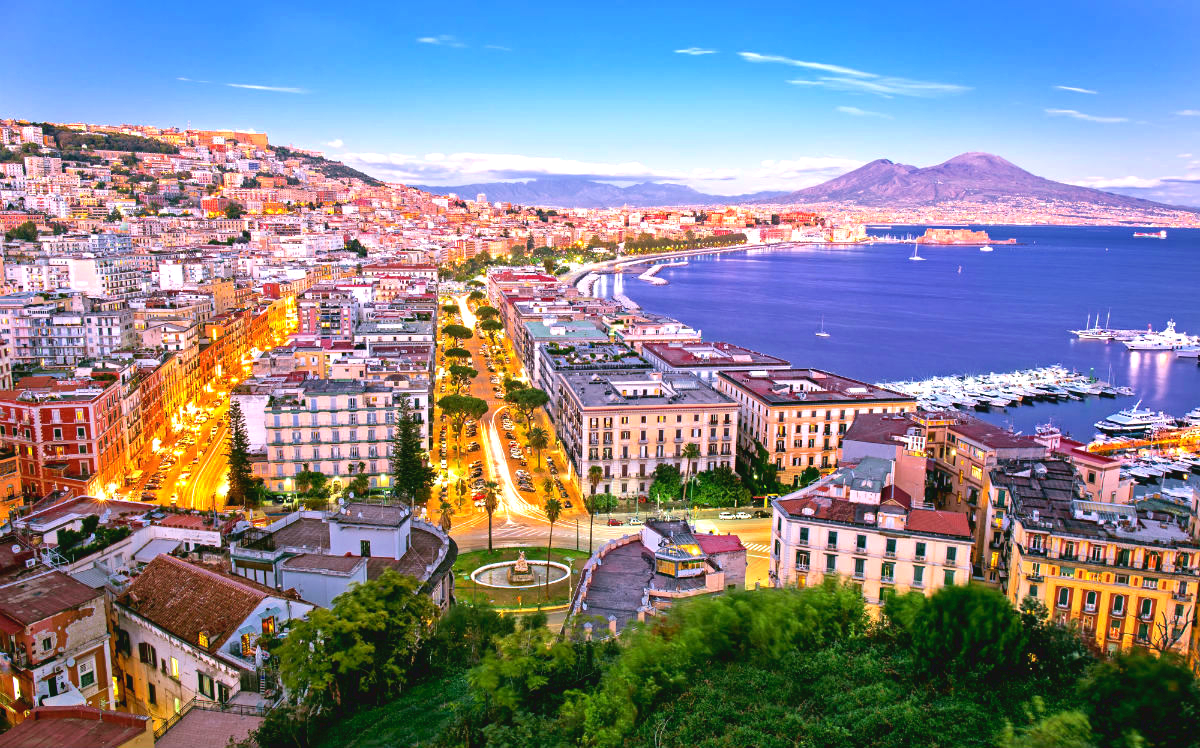
Neapel (Italienisch Napoli, Neapolitanisch Napule, altgriechisch: Νεάπολις („neue Stadt“)) ist mit knapp einer Million Einwohnern die drittgrößte Stadt Italiens. Die Hauptstadt der Region Kampanien sowie der Metropolitanstadt Neapel ist ein wirtschaftliches und kulturelles Zentrum Süditaliens. Die Metropolregion hat bis zu 4,4 Millionen Einwohner. Viele Neapolitaner sprechen das stark vom Standarditalienischen abweichende Neapolitanisch.
Die ursprüngliche griechische Siedlung trug den Namen Neapolis („Neustadt“). Später geriet sie unter römische Herrschaft. Vom Spätmittelalter bis zum 18. Jahrhundert gehörte Neapel zu den größten Städten Europas. Seine politische Geschichte ist über weite Strecken von Fremdherrschaft geprägt, zudem war es die Hauptstadt süditalienischer Reiche.
In den inneren Stadtteilen findet man zahlreiche historische Bauten und Kulturdenkmäler; 1995 wurde die gesamte Altstadt zum UNESCO-Weltkulturerbe erklärt.
那不勒斯(意大利语:Napoli;那不勒斯语:Nàpule)是意大利南部的第一大城市,坎帕尼亚大区以及那不勒斯省的首府。城市面积117平方公里,人口略低于100万。那不勒斯都会区有大约380万人口,是仅次于米兰和罗马的意大利第三大都会区[3]和欧洲第15大都会区[3]。那不勒斯地区也是意大利人口最稠密的地方之一。
那不勒斯位于那不勒斯湾的北岸,其东西两侧分别是两个火山区域:维苏威火山和坎皮佛莱格瑞火山区。因此,该市自古至今不断受到火山活动和地震的威胁。
那不勒斯始于前600年[4],以其丰富的历史、文化、艺术和美食而著称,那不勒斯历史中心被联合国教科文组织列为世界文化遗产。比萨饼起源于那不勒斯。音乐是那不勒斯文化中产生了广泛影响的的一个重要组成部分,包括发明了浪漫吉他和曼陀林,以及对歌剧和拿波里民谣的重大贡献。
在其存在的2500余年历史中,大部分时间都扮演着重要角色。该市为古希腊人所创建,在“大希腊”中扮演重要角色;后来,罗马人、诺曼人和西班牙人都在该市留下了自己的印记,也曾经是波旁王朝统治的两西西里王国的首都,直到意大利统一。今天,那不勒斯仍是繁荣的地中海港口和商业城市,高速铁路和地铁网伴随着都会区的扩张。
ナポリ(伊: Napoli (![]() 音声ファイル) ; ナポリ語: Napule)は、イタリア南部にある都市で、その周辺地域を含む人口約98万人の基礎自治体(コムーネ)。カンパニア州の州都であり、ナポリ県の県都でもある。ローマ、ミラノに次ぐイタリア第三の都市で、南イタリア最大の都市である。都市圏人口は約300万人。
音声ファイル) ; ナポリ語: Napule)は、イタリア南部にある都市で、その周辺地域を含む人口約98万人の基礎自治体(コムーネ)。カンパニア州の州都であり、ナポリ県の県都でもある。ローマ、ミラノに次ぐイタリア第三の都市で、南イタリア最大の都市である。都市圏人口は約300万人。
ナポリ湾に面した港湾都市・工業都市である[4]。古代ギリシア人によって建設された植民市に起源を持ち、13世紀以降はナポリ王国の首都として南イタリアの政治・経済の中心地となった[4]。ヴェスヴィオ火山を背景とする風光明媚な景観[4]で知られる観光都市であり、「ナポリを見てから死ね (vedi Napoli e poi muori)」[注釈 1]と謳われる[4]。旧市街地は「ナポリ歴史地区」として世界遺産に登録されている。ナポリ周辺にも、ヴェスヴィオ火山やポンペイの遺跡、カプリ島などの観光地を有する。
Naples (/ˈneɪpəlz/; Italian: Napoli [ˈnaːpoli ] ( listen), Neapolitan: Napule [ˈnɑːpələ] or [ˈnɑːpulə]; Latin: Neapolis; Ancient Greek: Νεάπολις, lit. 'new city') is the regional capital of Campania and the third-largest municipality in Italy after Rome and Milan. In 2017, around 967,069 people lived within the city's administrative limits while its province-level municipality has a population of 3,115,320 residents. Its continuously built-up metropolitan area (that stretches beyond the boundaries of the Metropolitan City of Naples) is the second or third largest metropolitan area in Italy.
listen), Neapolitan: Napule [ˈnɑːpələ] or [ˈnɑːpulə]; Latin: Neapolis; Ancient Greek: Νεάπολις, lit. 'new city') is the regional capital of Campania and the third-largest municipality in Italy after Rome and Milan. In 2017, around 967,069 people lived within the city's administrative limits while its province-level municipality has a population of 3,115,320 residents. Its continuously built-up metropolitan area (that stretches beyond the boundaries of the Metropolitan City of Naples) is the second or third largest metropolitan area in Italy.
First settled by Greeks in the second millennium BC, Naples is one of the oldest continuously inhabited urban areas in the world.[3] In the ninth century BC, a colony known as Parthenope or Παρθενόπη was established on the Island of Megaride,[4] later refounded as Neápolis in the sixth century BC.[5] The city was an important part of Magna Graecia, played a major role in the merging of Greek and Roman society and a significant cultural centre under the Romans.[6] It was capital of the Duchy of Naples (661-1139), then the Kingdom of Naples (1282 and 1816) and finally the Two Sicilies until the unification of Italy in 1861.
Between 1925 and 1936, Naples was expanded and upgraded by Benito Mussolini's government but severely damaged by Allied bombing during World War II, leading to extensive post-1945 reconstruction work.[7] Naples has experienced significant economic growth in recent decades, helped by the construction of the Centro Direzionale business district and an advanced transportation network, which includes the Alta Velocità high-speed rail link to Rome and Salerno and an expanded subway network. Naples is the third-largest urban economy in Italy, after Milan and Rome[8]. The Port of Naples is one of the most important in Europe and home of the Allied Joint Force Command Naples, the NATO body that oversees North Africa, the Sahel and Middle East.[9]
Naples' historic city centre is the largest in Europe and a UNESCO World Heritage Site, with a wide range of culturally and historically significant sites nearby, including the Palace of Caserta and the Roman ruins of Pompeii and Herculaneum. Naples is also known for its natural beauties such as Posillipo, Phlegraean Fields, Nisida, and Vesuvius.[10]
Neapolitan cuisine is synonymous with pizza, which originated in the city but it includes many other less well-known dishes and is the Italian city with the highest number of accredited stars from the Michelin Guide.[11]
The best known sports team in Naples is the Serie A club S.S.C. Napoli, two-time Italian champions who play at the San Paolo Stadium in the southwest of the city.
Naples (en italien Napoli /ˈnapoli/, en napolitain Napule) est une ville d'Italie, capitale de la région de Campanie. Elle est la troisième ville d'Italie par sa population et la dix-huitième de l'Union européenne ainsi que respectivement la deuxième (devant Rome) et la neuvième en incluant sa banlieue2. C'est aussi la deuxième plus grande cité méditerranéenne en Europe, après Barcelone.
L'histoire de Naples s'étend sur plus de vingt-huit siècles. Sous le nom de Parthénope, elle fut fondée durant l'Antiquité par la cité voisine de Cumes. Elle s'étend ensuite rapidement jusqu'à devenir un des principaux centres commerciaux, culturels, philosophiques et politiques de la Grande-Grèce puis de l'Empire romain. Après avoir été brièvement dépendante de l'Empire byzantin, elle devient autonome au sein du duché de Naples. Dès le XIIIe siècle et pour ensuite plus de 600 ans, elle devient la capitale du Royaume de Naples puis successivement du Royaume des Deux-Siciles. Elle reste alors un des principaux centres de développement économiques et technologiques d'Europe jusqu'à son annexion au Royaume d’Italie en 1860, date à laquelle elle entame un relatif déclin socio-économique.
Au cours des siècles, Naples a aussi été un des grands centres universitaires internationaux. L'Université de Naples «Frédéric-II» est la plus ancienne université laïque du monde et la 6e plus ancienne en général. Elle compte également l'Université de Naples «L'Orientale», un des plus anciens instituts de langues orientales, ainsi que l'École militaire Nunziatella, une des plus renommées d'Italie. Elle est aussi un des hauts-lieux de la musique (avec l'école napolitaine de musique, à l'origine de l'Opéra bouffe, ou la chanson napolitaine), de l'art et de l'architecture (le Baroque napolitain, l'École du Pausilippe, le Liberty napolitain, le Théâtre napolitain et la Manufacture de Capodimonte) ou encore la cuisine napolitaine (avec les pâtes et surtout la pizza napolitaine comme icône, Naples étant la ville italienne la plus étoilée au Guide Michelin3).
La ville est aussi célèbre pour son patrimoine et ses monuments. Le centre historique de Naples (avec ses fontaines, vestiges antiques, palais et plus de 1 000 églises) est ainsi le plus grand centre-ville inscrit au patrimoine mondial de l'UNESCO tandis que le parc national du Vésuve et le Miglio d'oro ont été reconnus réserve de biosphère. De plus, Naples est connue pour ses nombreuses beautés naturelles (Posillipo, Champs Phlégréens, Nisida, Vésuve, etc.), comparables à ceux de Rio de Janeiro4.
Enfin, elle abrite également la Villa Rosebery (l'une des trois résidences officielles du président de la République italienne), le siège d'un commandement interalliés et interarmées de l'OTAN, la Apple Developer Academy ainsi qu'un vaste patrimoine archéologique avec notamment la Naples souterraine ou, à proximité, la ville d'Herculanum, une ancienne banlieue5.
Napoli (AFI: /ˈnapoli/[4] ascolta[?·info]; Nàpule in napoletano, pronuncia [ˈnɑːpulə] o [ˈnɑːpələ]) è un comune italiano di 964 004 abitanti[2], capoluogo dell'omonima città metropolitana e della regione Campania.
Terzo comune in Italia per popolazione, Napoli è tra le più popolose e densamente popolate aree metropolitane dell'Unione europea.[N 1]
Fondata dai Cumani nell'VIII secolo a.C., fu tra le città più importanti della Magna Græcia[5][6], grazie al rapporto privilegiato con Atene[7], ed esercitò una notevole influenza commerciale, culturale e religiosa sulle popolazioni italiche circostanti[8] tanto da diventare sede della scuola epicurea di Filodemo di Gadara e Sirone. Dopo il crollo dell'Impero romano, nell'VIII secolo la città formò un ducato autonomo indipendente dall'Impero bizantino; in seguito, dal XIII secolo e per circa seicento anni, fu capitale del Regno di Napoli; con la Restaurazione divenne capitale del Regno delle Due Sicilie sotto i Borbone fino all'Unità d'Italia. Per motivi culturali, politici, storici e sociali è stata, dall'evo antico sino ai giorni nostri, una delle città cardine dell'Occidente.[9]
Sede della Federico II, la più antica università statale d'Europa,[10] ospita altresì l'Orientale, la più antica università di studi sinologici ed orientalistici del continente[11] e la Nunziatella, una delle più antiche accademie militari al mondo, eletta patrimonio storico e culturale dei Paesi del Mediterraneo da parte dell'Assemblea parlamentare del Mediterraneo.[12] Luogo d'origine della lingua napoletana, ha esercitato ed esercita un forte ruolo in numerosi campi del sapere, della cultura e dell'immaginario collettivo a livello nazionale ed internazionale.
Centro della filosofia naturalistica del rinascimento[13] e centro illuminista di livello europeo[14], è stata a lungo un punto di riferimento globale per la musica classica e l'opera attraverso la scuola musicale napoletana[15], dando tra l'altro origine all'opera buffa.[16]
Città dall'imponente tradizione nel campo delle arti figurative, che affonda le proprie radici nell'età classica, ha dato luogo a movimenti architettonici e pittorici originali, quali il rinascimento napoletano[17] e il barocco napoletano,[18] il caravaggismo,[19] la scuola di Posillipo[20] ed il Liberty napoletano,[21] nonché ad arti minori ma di rilevanza internazionale, quali la porcellana di Capodimonte[22] ed il presepe napoletano.[23]
È all'origine di una forma distintiva di teatro,[24] di una canzone di fama mondiale[25] e di una peculiare tradizione culinaria[26] che comprende alimenti che assumono il ruolo di icone globali, come la pizza napoletana,[27] e l'arte dei suoi pizzaioli che è stata dichiarata dall'UNESCO patrimonio immateriale dell'umanità.[28]
Nel 1995 il centro storico di Napoli è stato riconosciuto dall'UNESCO come patrimonio mondiale dell'umanità, per i suoi eccezionali monumenti, che testimoniano la successione di culture del Mediterraneo e dell'Europa[29]. Nel 1997 l'apparato vulcanico Somma-Vesuvio è stato eletto dalla stessa agenzia internazionale (con il vicino Miglio d'Oro, in cui ricadono anche i quartieri orientali della città) tra le riserve mondiali della biosfera.[30]
Nápoles (en italiano Napoli, en napolitano Napule) es la ciudad más poblada del sur de Italia, capital de la región de Campania y de la Ciudad metropolitana de Nápoles de más de 6 millones de habitantes. La ciudad de Nápoles administrativa tiene algo menos de un millón de habitantes,2 que, unidos a los de su área metropolitana, se elevan a 3,7 millones. Sus habitantes reciben el gentilicio de napolitanos. Está situada a medio camino entre el monte Vesubio y otra área volcánica, los Campos Flégreos. Da nombre al Golfo de Nápoles.
Tiene una gran riqueza histórica, artística, cultural y gastronómica, lo que llevó a la Unesco a declarar su centro histórico Patrimonio de la Humanidad.3 Griegos, romanos, bizantinos, normandos, franceses y españoles han dejado su huella en Nápoles. Estuvo brevemente bajo dominación austríaca en las primeras décadas del siglo XVIII, tras la cual se convirtió en el centro político del reino independiente de Nápoles y, posteriormente, de las Dos Sicilias, gobernado por los Borbones. En el año 1861 pasó a formar parte del Reino de Italia. En el siglo XX, durante el fascismo y en la reconstrucción subsiguiente a la Segunda Guerra Mundial se edificó gran parte de la periferia. En las últimas décadas, Nápoles se ha dotado de un distrito financiero con rascacielos (CDN) e infraestructuras como el TAV, hacia Roma y Salerno, o una red de metro en proceso de expansión. Por otra parte, también le acucian grandes problemas como el crimen organizado, muy presente en la vida de una parte de sus habitantes y que constituye un freno al desarrollo económico y social; o de otra naturaleza, las fuerzas telúricas: la ciudad ha sufrido grandes terremotos y la actividad volcánica es vigilada constantemente.
Неа́поль (др.-греч. Νεάπολις, от др.-греч. νέα πόλις букв. — новый город; лат. Neapolis, итал. Napoli, неап. Napule) — город в Италии. Административный центр области Кампания и провинции Неаполь. Расположен в бухте Неаполитанского залива.
Неаполь — третий по величине город Италии (после Рима и Милана) и самый большой город Южной Италии с населением около миллиона человек (с пригородами — около трёх миллионов). Крупный транспортный узел (международный аэропорт, морской порт). Наряду с официальным итальянским языком в просторечии местных жителей распространён неаполитанский диалект. Святой покровитель города — св. Януарий, день памяти которого 19 сентября отмечается как праздник города.
Находится в сейсмоопасной зоне (историческая часть — на западном склоне Везувия). Последнее извержение Везувия произошло в 1944 году. Последнее катастрофическое землетрясение случилось в Неаполе в 1980 году.
 阿尔巴尼亚
阿尔巴尼亚
 安道尔
安道尔
 亚美尼亚
亚美尼亚
 阿塞拜疆
阿塞拜疆
 澳大利亚
澳大利亚

 巴伐利亚州
巴伐利亚州
 白俄罗斯
白俄罗斯
 比利时
比利时
 波斯尼亚和黑塞哥维那
波斯尼亚和黑塞哥维那
 保加利亚
保加利亚

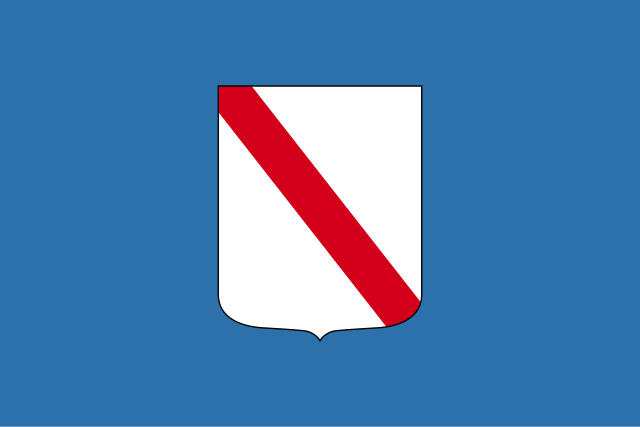 坎帕尼亚大区
坎帕尼亚大区
 丹麦
丹麦

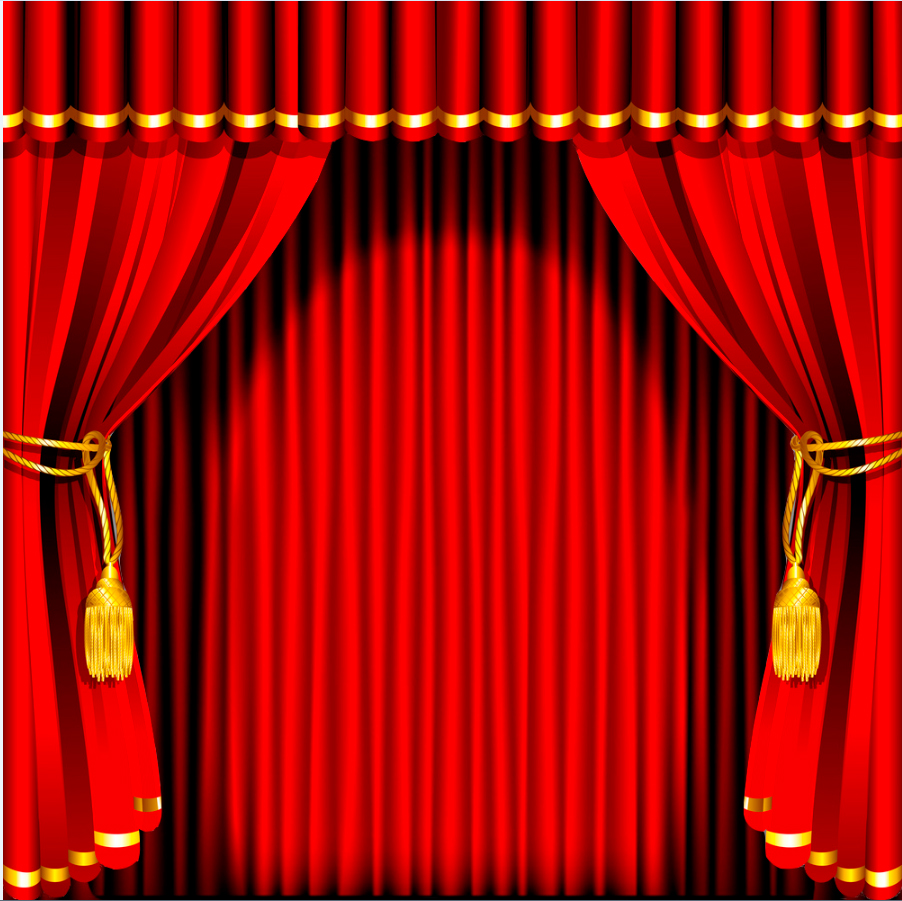 表演艺术
表演艺术
 联邦德国
联邦德国
 英格兰
英格兰
 爱沙尼亚
爱沙尼亚
 欧洲流行歌曲大赛
欧洲流行歌曲大赛
 芬兰
芬兰
 法国
法国
 格鲁吉亚
格鲁吉亚
 希腊
希腊

 黑森州
黑森州

 法兰西岛
法兰西岛
 爱尔兰
爱尔兰
 冰岛
冰岛
 以色列
以色列
 意大利
意大利
 克罗地亚
克罗地亚
 拉脱维亚
拉脱维亚
 立陶宛
立陶宛
 卢森堡
卢森堡

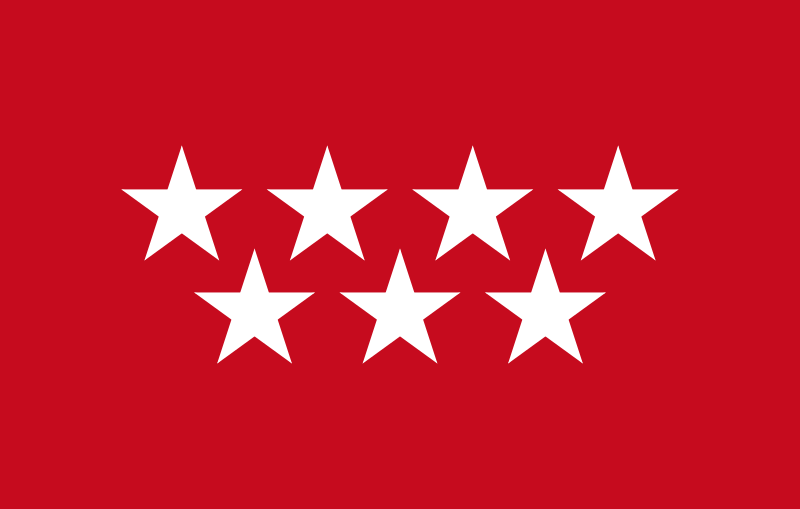 马德里自治区
马德里自治区
 马耳他
马耳他
 摩洛哥
摩洛哥
 摩尔多瓦
摩尔多瓦
 摩纳哥
摩纳哥
 黑山
黑山
 荷兰
荷兰
 北爱尔兰
北爱尔兰
 北马其顿
北马其顿

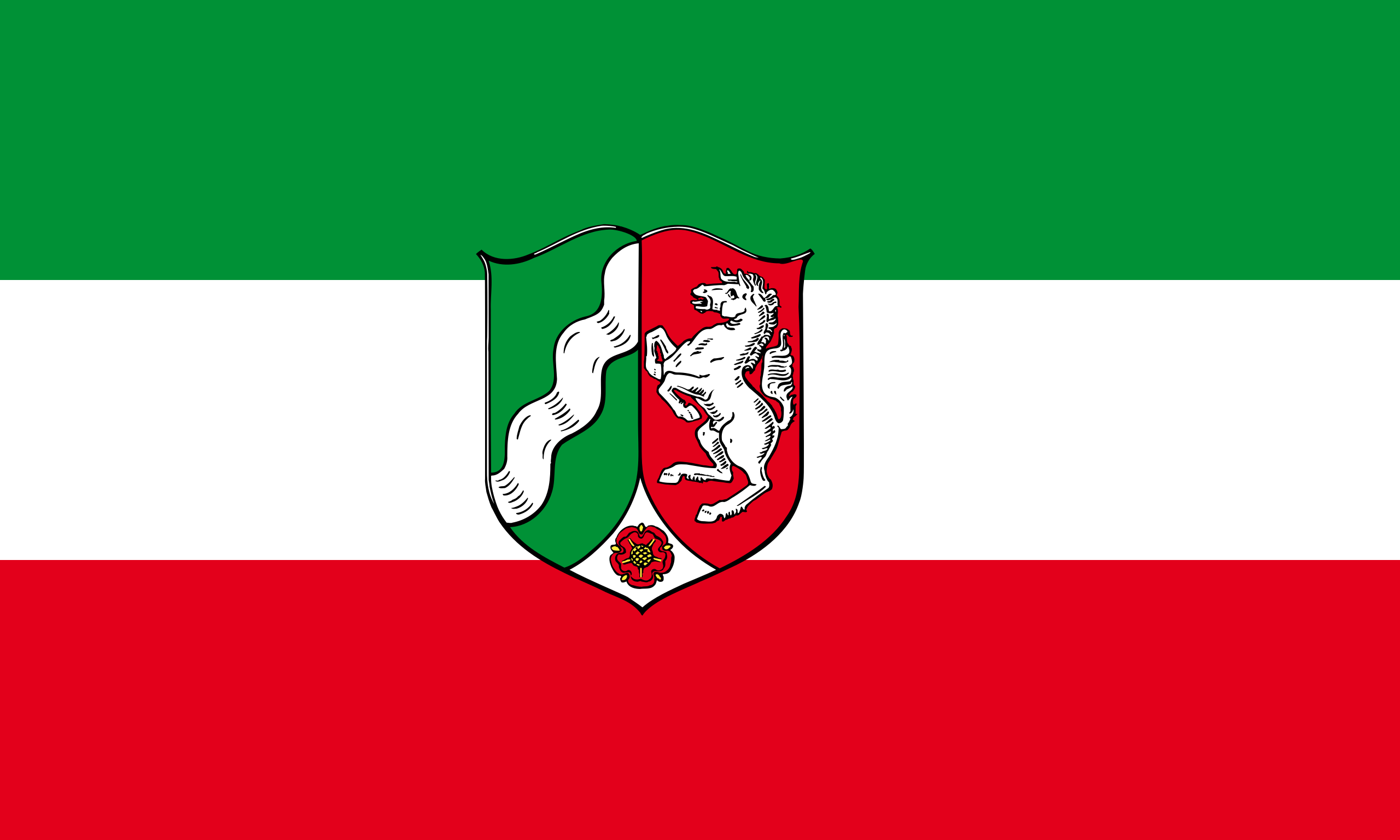 北莱茵-威斯特法伦州
北莱茵-威斯特法伦州
 挪威
挪威
 奥地利
奥地利
 波兰
波兰
 葡萄牙
葡萄牙

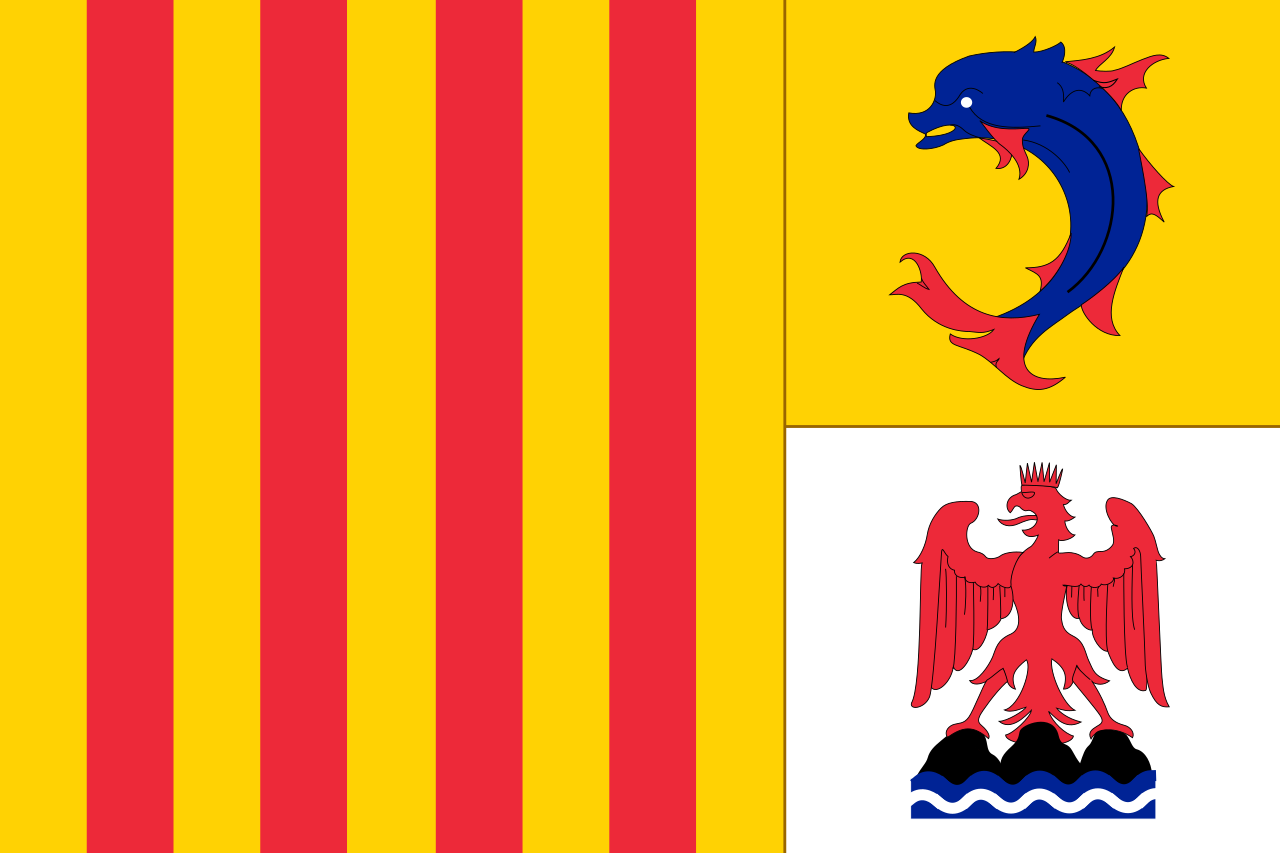 普罗旺斯-阿尔卑斯-蓝色海岸
普罗旺斯-阿尔卑斯-蓝色海岸
 罗马尼亚
罗马尼亚
 俄罗斯
俄罗斯
 圣马力诺
圣马力诺
 苏格兰
苏格兰
 瑞典
瑞典
 瑞士
瑞士
 塞尔维亚
塞尔维亚
 斯洛伐克
斯洛伐克
 斯洛文尼亚
斯洛文尼亚
 西班牙
西班牙
 捷克
捷克
 土耳其
土耳其
 乌克兰
乌克兰
 匈牙利
匈牙利
 英国
英国

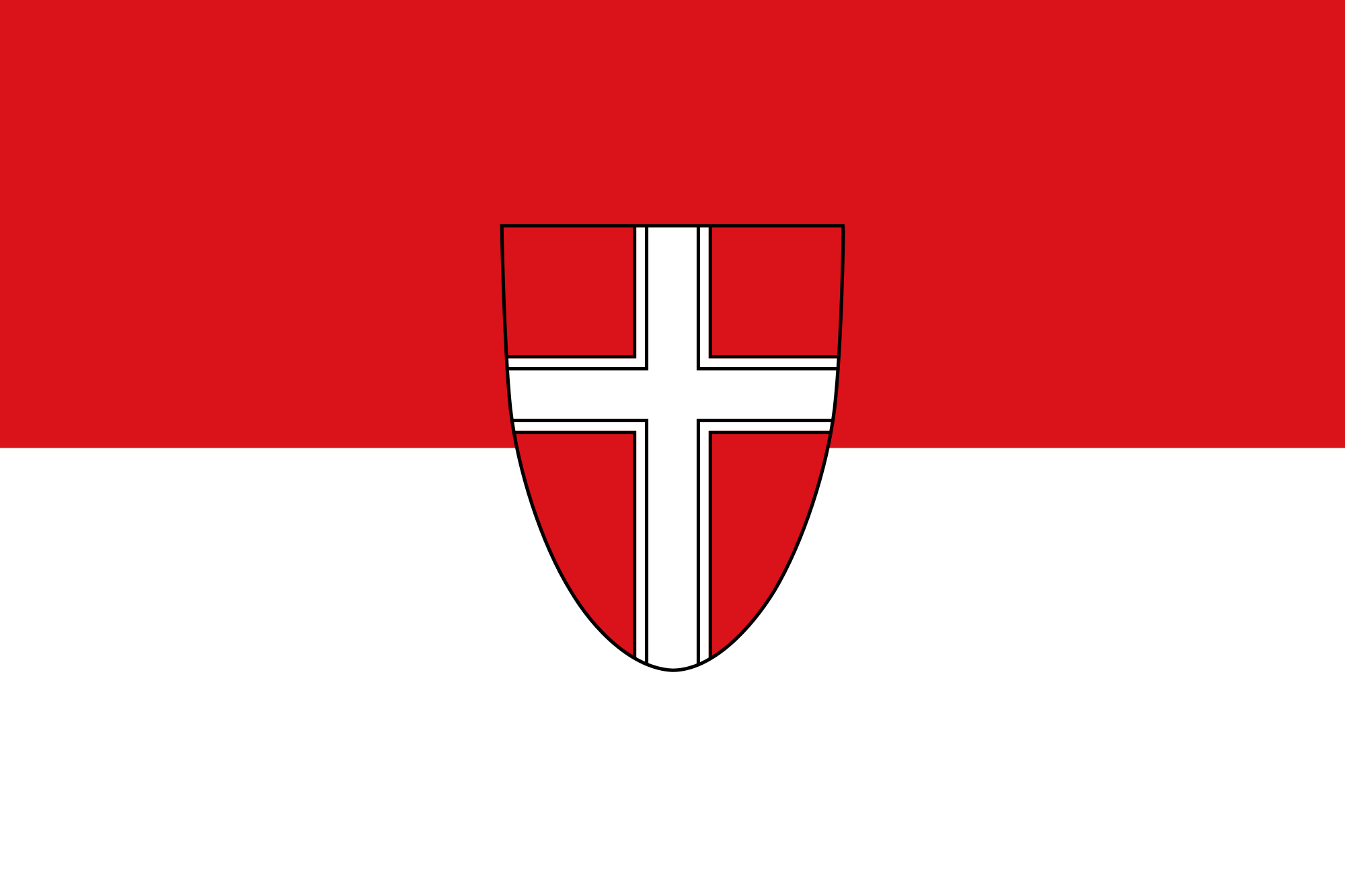 维也纳
维也纳
 塞浦路斯
塞浦路斯
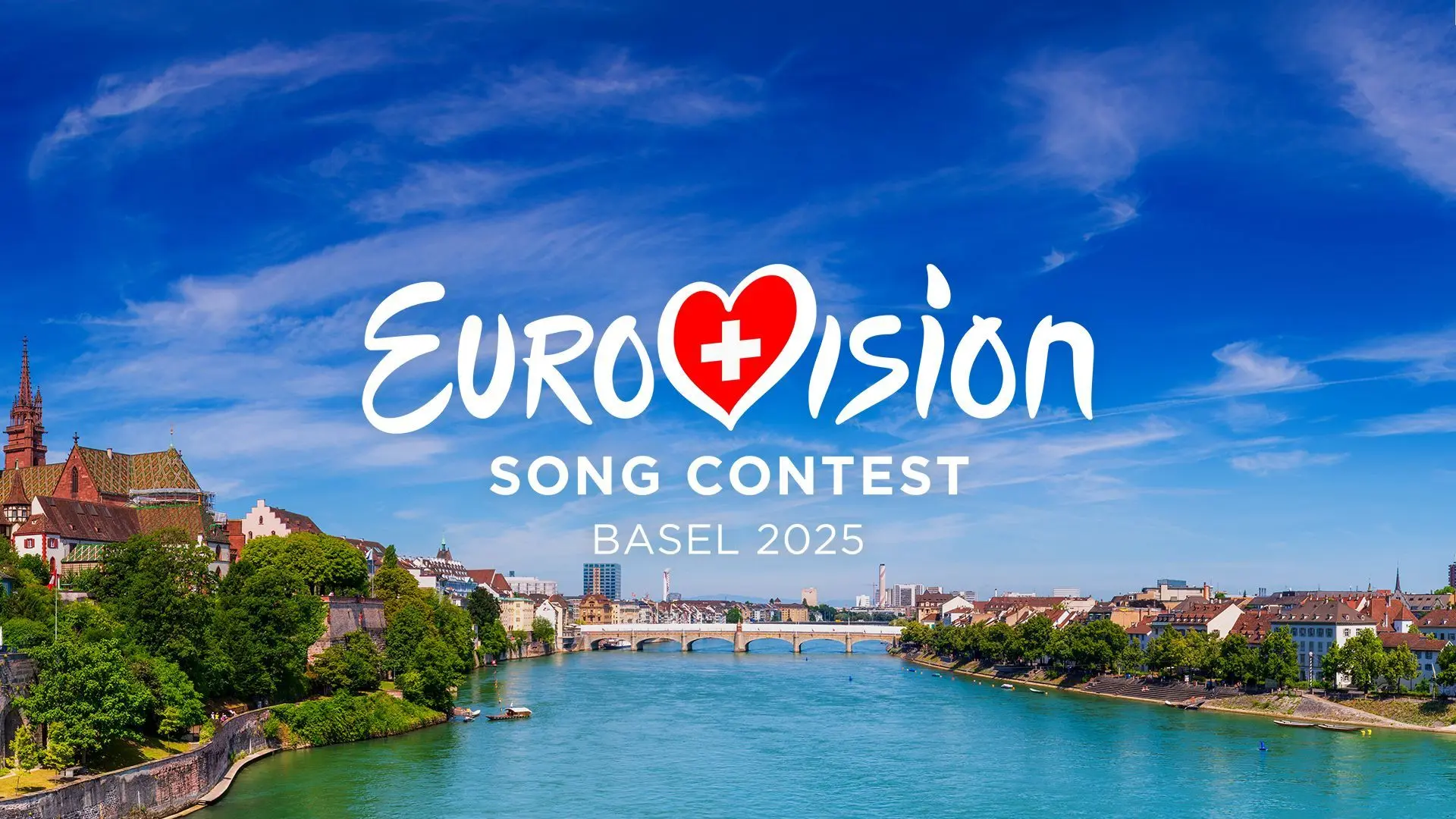



Der Eurovision Song Contest (ESC; übersetzt „Liederwettbewerb der Eurovision“; bis 2001 in Deutschland unter dem französischen Namen Grand Prix Eurovision de la Chanson[1]) ist ein internationaler Musikwettbewerb von Komponisten und Textdichtern, vorgetragen von Gesangsinterpreten, der seit 1956 jährlich von der Europäischen Rundfunkunion (EBU) im Rahmen der Eurovision veranstaltet wird. Die Anregung dazu war vom Sanremo-Festival beeinflusst, das bereits 1951 ins Leben gerufen wurde. Beim ESC sind die Rundfunkanstalten aller Staaten der EBU teilnahmeberechtigt. Dieser Rundfunkunion gehören mehrheitlich europäische und einige Radio- und Fernsehstationen benachbarter westasiatischer und nordafrikanischer Staaten an.
Da die Shows auch außerhalb des Sendegebiets der EBU übertragen werden, konnte der Eurovision Song Contest über die Jahre hinweg auch eine große Fangemeinde in Australien, Neuseeland, Teilen Asiens (Japan, China, Südkorea, Hongkong, Indien), Mexiko und Teilen Südamerikas, Kanada und den USA gewinnen.[2] Insgesamt werden die Übertragungen des ESC von mehr als 200 Millionen Zuschauern gesehen. Im Jahr 2016 erhielt der ESC die Karlsmedaille für europäische Medien.
欧 洲广 播联盟主办的一项歌唱比赛,自从1956年在瑞士Lugano(卢加诺)举办第一届以后,每年会举行一次,由在上一届获得冠军的国家承办(挺有意思的)。 比赛的结果不是评委说了算,而是由全欧洲的电视观众决定。歌曲演唱完毕,会给出十分钟时间,由电视观众打投票电话进行评选,投票范围为除自己国家外的其他 所有歌手。这个大赛还有个特色就是不规定歌手必须是这个国家的“自己人”,各个国家可以根据自己的情况请“外援”,比较出名的有Celine Dion在1988年代表瑞士参赛并拿了冠军。欧洲电视歌曲大赛采用了全欧洲各国竞赛的方式,来自各国的选手带上自己最精彩的节目,让我们有了更丰富的音 乐享受,整个晚会的气氛活跃,的确有不少好歌。欧洲歌唱大赛是欧洲最高水平的比赛,每个国家都会派出代表自己国家的歌手参赛欧视歌曲大赛已成为具有优秀传 统的欧陆年度音乐大赛,虽然只是欧洲范围内的音乐赛事,但是已经成为众多本地音乐艺人走向国际舞台的最佳跳板,是同类型比赛中规模最大者之一。在2008 年,一共有43个欧洲及邻近国家派出代表参加比赛,并有1.5亿观众透过电视观看了决赛。欧洲电视歌唱大赛经过50多年的发展,已经成为欧洲规模最大、影 响力最广、商业运作最成功的文艺活动。
和国内的歌唱比赛有所不同,欧洲电视歌唱大赛突出的是跨地域性和全民参与性。本届大赛共有38个国 家参加,观看决赛的电视观众有1.5亿之众,而参加采访的各国记者人数就超过2200人。比赛规定,大赛的优胜者由参赛国观众投票决定,但投票者不得将票 投给自己国家的选手。每名参赛者表演结束后,都会留下10分钟时间给观众投票。随着通讯手段的进步,手机短信、电话和电脑网络都被列为有效的投票方式,这 些选票最终由设在德国的一个数据中心进行处理,比赛全部结束后半小时内观众即可获悉大赛最终结果。
虽然每年代表各国参赛的歌手或乐队不一 定代表该国最高水平,但一定是该国当前最流行或者最具发展潜力的音乐组合。两位在现场的芬兰小伙子告诉记者,芬兰人对洛迪乐队疯狂的演唱风格不一定都喜 欢,但芬兰人能夺取冠军相当不容易。毕竟芬兰已经参加了近40届大赛,夺冠还是头一次。
通过该项大赛走红的明星并不少见,瑞典乐队的“芭 芭”就因1974年夺冠而一举成名,席琳·迪翁也在1988年爱尔兰举办的欧洲电视歌唱比赛中获得过冠军,二人组合“神秘园”1995年曾代表挪威夺得过 大奖,甚至爱尔兰著名的《大河之舞》,也是通过在该项比赛评分间隙进行的表演而走向世界比赛中每个国家派出一个歌手或一个乐团演唱一首自选的歌曲,之后观 众透过电话、短信或网络投选最喜欢的歌手,再统计各国的票数间接选出优胜者。而胜出者所代表的国家自动成为下年决赛的东道主。
在过去52届比赛,爱尔兰代表胜出了7次,是各国之冠,联合王国、法国和卢森堡代表各胜出了5次并列第二。历届优胜者中,ABBA(1974年)和席琳·狄翁(1988年)成了国际知名的巨星。
欧洲电视歌唱大赛由欧洲广播电视联盟主办,该联盟的成员国每年通过自己的选拔方式确定本国的参赛选手和曲目。每年5月份,半决赛和决赛通过现场直播方式在承办国进行。
ユーロビジョン・ソング・コンテスト(英語:Eurovision Song Contest、フランス語:Concours Eurovision de la Chanson)[1]は、欧州放送連合(EBU)加盟放送局によって開催される、毎年恒例の音楽コンテストである。
大会では、各国代表のアーティストはそれぞれ生放送で自らの楽曲を披露し、引き続いてそれぞれの参加国が他国に投票して大会の優勝者を決定する。各国代表の参加者は、欧州放送連合に加盟する全国網の放送局を通じて大会に参加しており、放送局は自国代表のアーティストと楽曲を決定し、また自国の視聴者に大会を生中継する。大会は1956年の第1回大会以降、毎年開催されており、世界的に見ても長寿のテレビ番組のひとつであり[2]、その視聴者の数も1億人から6億人程度と見積もられている[3][4]。ユーロビジョン・ソング・コンテストは、オーストラリア、カナダ、中華人民共和国、エジプト、インド、日本、ヨルダン、メキシコ、ニュージーランド、フィリピン、大韓民国、台湾、タイ王国、ベトナム、ウルグアイなど、大会に参加していないヨーロッパ域外の国々でも放送された[5][6][7]。2000年以降は、コンテストは公式サイトよりインターネットでも中継されており[8]、2006年には140カ国近くから7万4千人以上が視聴している[9]。
The Eurovision Song Contest (French: Concours Eurovision de la chanson),[1] often simply called Eurovision, is an international song competition held primarily among the member countries of the European Broadcasting Union. Each participating country submits an original song to be performed on live television and radio, then casts votes for the other countries' songs to determine the winner. At least 50 countries are eligible to compete as of 2018,[2] and since 2015, Australia has been allowed as a guest entrant.[3][4][5][6]
Winning the Eurovision Song Contest often provides a short-term career boost for artists, but rarely results in long-term success.[7] Some exceptions are ABBA (winner in 1974 for Sweden), Bucks Fizz (winner in 1981 for the United Kingdom), and Celine Dion (winner in 1988 for Switzerland), all of whom launched successful careers.
Based on the Sanremo Music Festival held in Italy since 1951, Eurovision has been broadcast every year since its inauguration in 1956, making it the longest-running annual international television contest and one of the world's longest-running television programmes. It is also one of the most watched non-sporting events,[8] with audience figures of between 100 million and 600 million internationally.[9][10] It has been broadcast in several countries that do not compete, such as the United States, Canada, New Zealand, and China. Since 2000, it has been broadcast online via the Eurovision website.[11] The contest has been described as having kitsch appeal.[12][13]
Ireland holds the record for most victories, with seven wins, including four times in five years in 1992, 1993, 1994, and 1996. Under the current voting system, in place since 2016, the highest-scoring winner is Salvador Sobral of Portugal who won the 2017 contest in Kiev, Ukraine, with 758 points; under the previous system, the highest-scoring winner was Alexander Rybak of Norway with 387 points in 2009.
Le Concours Eurovision de la chanson (en anglais : Eurovision Song Contest) est un événement annuel organisé par l'Union européenne de radio-télévision, l'UER. Il réunit les membres de l'Union dans le cadre d'une compétition musicale, diffusée en direct et en simultané par tous les diffuseurs participants. Il est retransmis à la télévision (par câble et satellite), la radio et sur Internet. Appelé plus communément Eurovision, d'après le réseau télévisé du même nom, il a été inventé par le directeur général de la télévision publique suisse, Marcel Bezençon, sur le modèle du Festival de Sanremo, créé peu de temps auparavant. Sa toute première édition a eu lieu le 24 mai 1956, à Lugano, en Suisse. Sept pays fondateurs ont concouru alors pour la victoire. Depuis, le Concours s'est tenu chaque année, sans aucune interruption. Le nombre de pays participants n'a cessé d'augmenter, passant de sept à une quarantaine au XXIe siècle. À travers les décennies, le Concours a évolué, s'est adapté et réinventé, accompagnant les développements technologiques et musicaux, mais aussi historiques et politiques.
L'Eurovision possède certains attributs symboliques qui ont pérennisé son ancrage dans les mémoires, comme son thème d'ouverture, le prélude orchestral du Te Deum de Marc-Antoine Charpentier. De même, sa procédure de vote, souvent perçue comme sa séquence la plus importante, se déroule selon un schéma récurrent et des règles bien précises. Elle est devenue un véritable rituel annuel.
L'Eurovision est ouvert aux seuls membres actifs de l'UER. Ces membres sont des diffuseurs soit de pays situés dans la Zone européenne de radiodiffusion soit des diffuseurs de pays situés en dehors de cette zone mais membres du Conseil de l'Europe. Tous doivent être membres de l'Union internationale des télécommunications. Cela inclut donc des pays situés en Europe, en Asie et en Afrique. Le Concours est aussi retransmis en direct sur les autres continents, notamment en Afrique du Sud, en Australie, au Canada, en Corée du Sud, aux États-Unis, en Nouvelle-Zélande et en Chine.
L'Eurovision demeure l'un des plus anciens programmes télévisés au monde, et le plus important concours musical jamais organisé. Son succès a dépassé les frontières du continent européen et il a inspiré de nombreuses autres compétitions musicales.
L'Eurovision Song Contest (o Concours Eurovision de la Chanson, anche solo Eurovision o ESC, e noto in Italia anche come Eurofestival) è un festival musicale internazionale nato nel 1956, a Lugano in Svizzera, e organizzato annualmente dai membri dell'Unione europea di radiodiffusione (UER).
Dalla prima edizione del 1956 il concorso è stato trasmesso ogni anno senza interruzioni in tutto il mondo ed è uno dei programmi televisivi più longevi. È anche l'evento non sportivo più seguito al mondo[1]: i dati di ascolto degli ultimi anni a livello internazionale sono stati stimati tra i 100 e i 600 milioni.[2][3][4][5][6]
Dal 2000 il concorso viene trasmesso anche via internet e dal 2016 viene trasmesso anche in diretta sul canale ufficiale YouTube dell'evento, che nel 2018 conta circa 2,5 milioni di iscritti.[7][8]
El Festival de la Canción de Eurovisión (en francés Concours Eurovision de la Chanson; en inglés Eurovision Song Contest) es un concurso televisivo de carácter anual, en el que participan intérpretes representantes de las televisiones (en su mayoría públicas) cuyos países son miembros de la Unión Europea de Radiodifusión. El festival ha sido transmitido cada año desde 1956, siendo el programa de televisión más antiguo que aún se transmite en el mundo,1 recibiendo en 2015 el récord Guinness como la competición musical televisiva más longeva del mundo.2 Además, es el festival de la canción más grande en términos de audiencia, la que se ha estimado entre 100 y 600 millones internacionalmente. El evento es transmitido en todo el mundo, incluso en países que no participan en el mismo. El festival es históricamente conocido por ser promotor de música pop. Sin embargo, en años recientes se han presentado en el festival varios temas pertenecientes a otros géneros, como árabe, dance, tango, reguetón, heavy metal, pop-rap, punk, rock, electrónica, entre otros.
El nombre del concurso viene de la Red de Distribución de Televisión de Eurovisión (Eurovision Network), que está controlada por la Unión Europea de Radiodifusión (UER) y puede alcanzar audiencias potenciales de más de mil millones de personas. Cualquier miembro activo de la UER puede participar en el Festival, por lo que la aptitud para formar parte de este magno evento no está determinada por la inclusión geográfica dentro del continente europeo (a pesar del prefijo «Euro» en «Eurovisión»), que no tiene que ver con la Unión Europea. Al paso de los años, el festival ha crecido de un simple experimento televisivo a una institución internacional de grandes proporciones y el término «Eurovisión» es reconocido a lo largo del mundo.
Para la edición 2015, se invitó a Australia a participar en el certamen, lo que supuso que se convierta en el primer miembro asociado de la UER (y no activo) que participa en Eurovisión, así como en el primer país oceánico.3 La edición más reciente, el Festival de la Canción de Eurovisión 2018, fue realizada entre el 8 de mayo y el 12 de mayo de 2018 en Lisboa, Portugal. Israel se proclamó ganadora con el tema «Toy», interpretado por la cantante Netta Barzilai.
Ко́нкурс пе́сни «Еврови́дение» (англ. Eurovision Song Contest; фр. Concours Eurovision de la chanson) — международный конкурс эстрадной песни среди стран-членов Европейского вещательного союза (ЕВС — англ. European Broadcasting Union)[1]. Владельцем всей интеллектуальной собственности, производящейся в рамках конкурса, также является Европейский вещательный союз[2].
В конкурсе участвует по одному представителю от каждой из стран-членов ЕВС, которые подали заявки на участие. Фестиваль проходит в прямом эфире. От каждой страны может участвовать один представитель (солист или музыкальный коллектив), исполняющий песню длительностью не более трёх минут. Во время выступления на сцене должно выступать не более шести артистов одновременно. После выступления всех участников наиболее популярная песня определяется путём голосования телезрителей и жюри, в котором участвуют все страны, выступавшие в финале и полуфинале[3].
Конкурс проходит ежегодно, начиная с 1956 года, и является одним из самых популярных неспортивных мероприятий в мире[4], с аудиторией до 600 млн зрителей[5][6]. «Евровидение» также транслируется в Киргизии, Казахстане, Канаде, Египте, Индии, Ливане, Южной Африке, Южной Корее, США и некоторых других странах, несмотря на то, что они не участвуют в конкурсе и находятся за пределами Европы[7][8]. Начиная с 2000 года, конкурс постоянно транслируется в сети Интернет[9], интернет-аудитория постоянно растёт: в 2006 году онлайн-трансляцию посмотрело 74 тысячи человек[10], в 2017 — свыше 600 тысяч.
«Евровидение» в значительной мере повлияло на известность участвовавших на нём артистов. Например, легендарные группы «АББА» (ABBA, Швеция — 1974)[11], «Чингисхан» (Dschinghis Khan, Германия — 1979)[12] и певица Селин Дион (Швейцария — 1988)[13] стали всемирно известными после триумфальных выступлений на песенном фестивале[14][15].


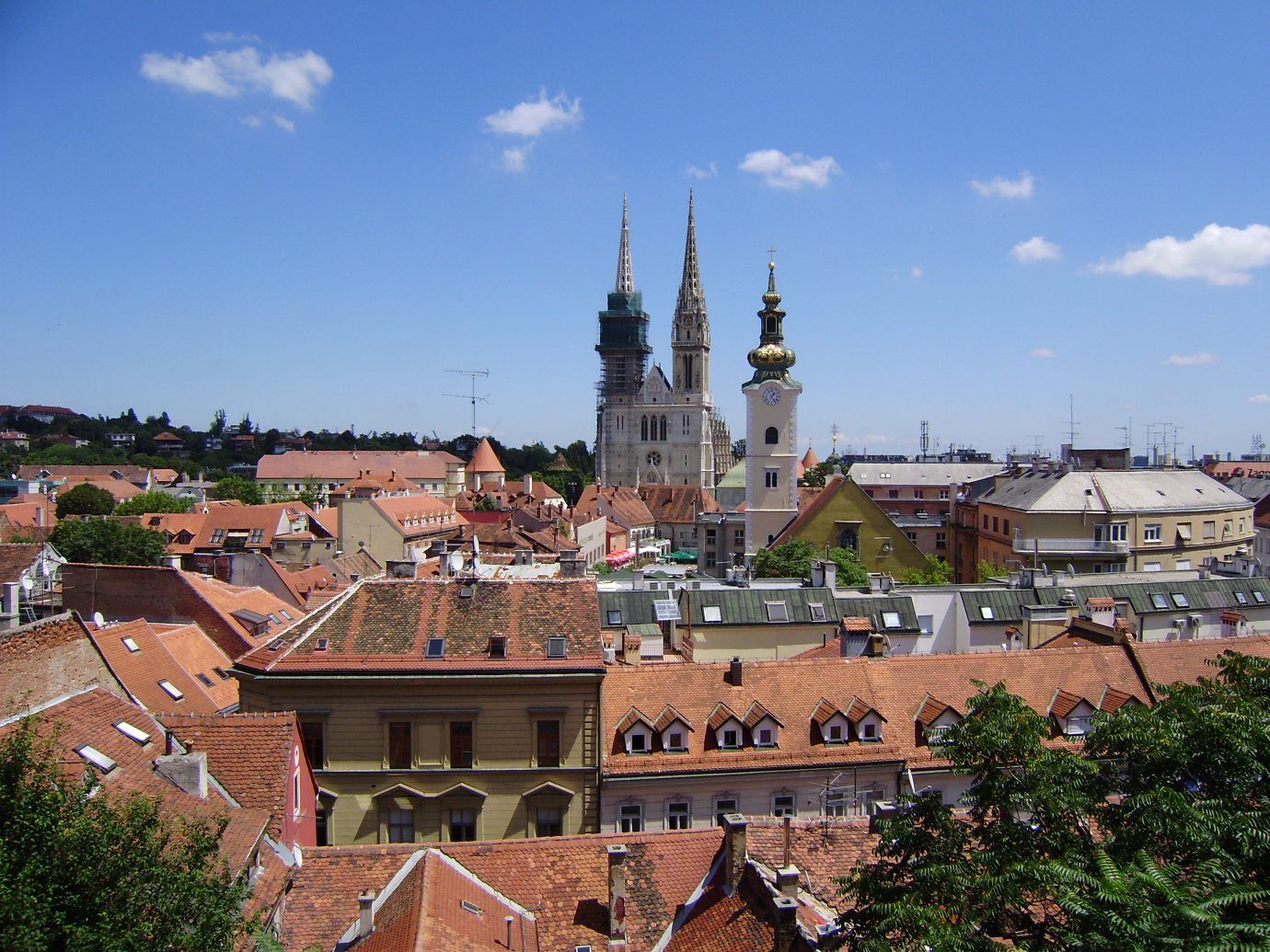
Zagreb [ˈzaːgrɛb] (deutsch Agram, heute selten genutzt; ungarisch Zágráb) ist die Hauptstadt und zugleich größte Stadt Kroatiens. Die Stadt Zagreb selbst hat auch die Funktionen einer Gespanschaft. Die nähere Umgebung der Stadt bildet getrennt von dieser die Gespanschaft Zagreb, deren Verwaltungssitz auch die Stadt Zagreb ist. In Zagreb residieren ein katholischer Erzbischof, die Kroatische Akademie der Wissenschaften und Künste sowie wichtige Verwaltungs- und Militärbehörden. Als Handels- und Finanzzentrum hat die Stadt nationale und regionale Bedeutung.
Die Zagreber Kathedrale ist Sitz der katholischen Erzdiözese Zagreb.
萨格勒布(克罗地亚语:Zagreb;德语旧称:Agram,阿格拉姆;匈牙利语:Zágráb),是克罗地亚的首都和札格雷布县的首府同时也是全国最大城市、一个直辖市。萨格勒布克罗地亚国内足球强队萨格勒布迪纳摩主场位于这里。萨格勒布位于海平面122m(400英尺),它位于克罗地亚的西北部的梅德韦德尼察山南坡,境内有萨瓦河流过。在2011年的正式人口普查中,萨格勒布市人口是792,875人[1]。连同萨格勒布县总人口达到了1,110,517。是克罗地亚唯一一个超过百万人口的大都市区。[2]
萨格勒布是一个有着悠久历史的城市(从古罗马时代到现在)。1094年在东部的卡普托尔主教教区内“萨格勒布”这个名称始见于史籍。在1845年扬科·卡毛夫成为萨格勒布的第一位市长。在1945年,随着人口快速的膨胀和城市的扩张,萨格勒布成为了克罗地亚的首都,从此萨格勒布开始闻名于世界。
萨格勒布在克罗地亚行政区划中有着十分特殊的地位(直辖市)。被管理细分为17个区域,它们大多是都位处低于海平面的萨瓦河山谷。
萨格勒布是克罗地亚全国、西欧和地中海和东南部欧洲的的最重要的交通枢纽。萨格勒布还有通往其他国家的国际列车。市内还有有轨电车。
ザグレブ(クロアチア語: Zagreb)は、クロアチアの首都。同国最大の都市である。クロアチアの北西部サヴァ川河畔に位置しメドヴェドニツァ山の南斜面にあり海抜は122mである。2011年の国勢調査による人口はザグレブ市街が686,568人、ザグレブ市域では792,875人であった。ザグレブ市と周辺の行政的に分かれているザグレブ郡の人口317,642人を合わせたザグレブ都市圏の人口は1,110,517人である。ザグレブはクロアチアでは唯一、100万人を超える都市圏を形成している。[5]
アルプスやディナルアルプス、アドリア海方向へ広がるパンノニア平原南西部の有利な地理的な条件により、中央ヨーロッパとアドリア海を結ぶ良く整備された交通回廊によって周辺地域と結ばれている。ザグレブは交通の要衝である他、産業の集積や科学研究機関、伝統的な産業などでクロアチアで先導する地位にある。また、首都としてクロアチアの中央政府や行政機関、省庁のほとんどがザグレブに拠点を置いている。
Zagreb (/ˈzɑːɡrɛb/ ZAH-greb, Croatian pronunciation: [zǎːɡreb] (![]() listen))[8] is the capital and the largest city of Croatia.[9] It is located in the northwest of the country, along the Sava river, at the southern slopes of the Medvednica mountain. Zagreb lies at an elevation of approximately 122 m (400 ft) above sea level.[10][11] The estimated population of the city in 2018 is 810,003. The population of the Zagreb urban agglomeration is about 1.1 million, approximately a quarter of the total population of Croatia.
listen))[8] is the capital and the largest city of Croatia.[9] It is located in the northwest of the country, along the Sava river, at the southern slopes of the Medvednica mountain. Zagreb lies at an elevation of approximately 122 m (400 ft) above sea level.[10][11] The estimated population of the city in 2018 is 810,003. The population of the Zagreb urban agglomeration is about 1.1 million, approximately a quarter of the total population of Croatia.
Zagreb is a city with a rich history dating from the Roman times to the present day. The oldest settlement located in the vicinity of the city was the Roman Andautonia, in today's Ščitarjevo.[12][13][14][15] The name "Zagreb" is recorded in 1134, in reference to the foundation of the settlement at Kaptol in 1094. Zagreb became a free royal town in 1242.[16][17][18][19][20] In 1851 Zagreb had its first mayor,[21][22][23][24] Janko Kamauf.
Zagreb has a special status in the Croatia's administrative division and is a consolidated city-county (but separated from Zagreb County),[25][26][27][28] and is administratively subdivided into 17 city districts.[29][30][31] Most of them are at a low elevation along the river Sava valley, whereas northern and northeastern city districts, such as Podsljeme[32][33][34] and Sesvete[35][36][37] districts are situated in the foothills of the Medvednica mountain,[38] making the city's geographical image rather diverse. The city extends over 30 kilometres (19 miles) east-west and around 20 kilometres (12 miles) north-south.[39][40]
The transport connections, concentration of industry, scientific, and research institutions and industrial tradition underlie its leading economic position in Croatia.[41][42][43] Zagreb is the seat of the central government, administrative bodies, and almost all government ministries.[44][45][46] Almost all of the largest Croatian companies, media, and scientific institutions have their headquarters in the city. Zagreb is the most important transport hub in Croatia where Central Europe, the Mediterranean and Southeast Europe meet, making the Zagreb area the centre of the road, rail and air networks of Croatia. It is a city known for its diverse economy, high quality of living, museums, sporting, and entertainment events. Its main branches of economy are high-tech industries and the service sector.
Zagreb (prononcé en croate : /ˈzɑːgrɛb/ ; hongrois : Zágráb ; italien : Zagabria ; anciennement nommée en allemand : Agram) est une ville et un comitat (« ville de Zagreb »), capitale de la Croatie. Au recensement de 2011, la ville comptait 688 163 habitants, le comitat 790 017 habitants, dont 93,14 % de Croates5 et la région de Zagreb (le comitat « ville de Zagreb » plus le comitat de Zagreb) comptait 1 107 623 habitants.
Zagreb est située au nord du pays sur les flancs de la Medvednica à côté de la Save à une altitude d'environ 122 m au-dessus du niveau de la mer. Sa situation géographique favorable dans le Sud-Ouest de la plaine de Pannonie qui s'étend des Alpes aux Alpes dinariques et à la mer Adriatique la place sur les axes de communication entre l'Europe centrale et la mer Adriatique.
Les interconnexions de transports, la concentration des industries, de la recherche scientifique et industrielle font de Zagreb le centre économique de la Croatie. Zagreb est également le siège du gouvernement, des corps administratifs et de presque tous les ministères.
Zagabria (in croato Zagreb, pronuncia [ˈzɑːgrɛb]; in tedesco, ai tempi dell'Impero austro-ungarico, Agram; in ungherese Zágráb) è la capitale e la maggiore città della Croazia, con i suoi 809 832 abitanti. Il centro cittadino costituisce una delle regioni della Croazia, mentre l'area geografica intorno alla città fa parte di un'altra unità amministrativa, la Regione di Zagabria.
Zagabria è sede degli organi centrali dello Stato (il Parlamento, il Presidente della Repubblica, il Governo ed il Primo ministro, la Corte Costituzionale, la Corte Suprema) e praticamente di tutti i ministeri. È anche sede universitaria (Università di Zagabria, Università Cattolica Croata, Università Internazionale Libertas, alte scuole, politecnici) e arcivescovile metropolitana (l'arcidiocesi di Zagabria con diocesi suffraganee a Varasdino, Sisak, Bjelovar-Križevci e l'eparchia greco-cattolica a Križevci di rito bizantino).
Zagreb (![]() [ˈzǎːɡreb] (?·i)) es la capital y ciudad más poblada de Croacia. Está localizada al noroeste del país, entre el río Sava y la ladera sur del monte Medvednica, a unos 122 metros sobre el nivel del mar. Dentro de su término municipal residen más de 890 000 habitantes en 2018, lo que la convierte en la cuarta ciudad más grande de Europa Sudoriental y en la segunda por extensión. Si se tienen en cuenta las poblaciones limítrofes, la cifra del área metropolitana asciende a 1 100 000 personas empadronadas.
[ˈzǎːɡreb] (?·i)) es la capital y ciudad más poblada de Croacia. Está localizada al noroeste del país, entre el río Sava y la ladera sur del monte Medvednica, a unos 122 metros sobre el nivel del mar. Dentro de su término municipal residen más de 890 000 habitantes en 2018, lo que la convierte en la cuarta ciudad más grande de Europa Sudoriental y en la segunda por extensión. Si se tienen en cuenta las poblaciones limítrofes, la cifra del área metropolitana asciende a 1 100 000 personas empadronadas.
La zona sobre la que se asienta Zagreb está habitada desde el Imperio romano. El yacimiento más antiguo que se ha localizado es la ciudad romana de Andautonia, situada a 10 km de la actual capital. El término «Zagreb» fue registrado por primera vez en 1134 para referirse a la archidiócesis de Zagreb, fundada en 1094,5 si bien durante siglos hubo dos pueblos distintos: Gradec —con bula de oro desde 1242— y Kaptol, donde se hallaba la catedral. Ambas localidades se fusionaron en 1851 por orden del ban Josip Jelačić para formar la ciudad actual.5
A diferencia de otras localidades del país, Zagreb tiene un estatus especial como «ciudad-condado», independiente del condado de Zagreb. A nivel administrativo está dividida en 17 distritos; la mayoría se encuentran en las zonas bajas cercanas al río Sava, mientras que los barrios del noroeste se sitúan a los pies del monte Medvednica. Su extensión total es de 30 km de este a oeste, y de 20 km de norte a sur.
En calidad de capital de Croacia, Zagreb alberga la sede del gobierno central, de las administraciones públicas y de casi todos los ministerios. La actividad económica concentra la mayoría de la industria, las sedes empresariales y los centros de investigación, con un sistema especializado en tecnologías de la información y en el sector servicios. Es asimismo el principal centro de comunicaciones de Croacia por tierra y aire, siendo un punto clave en la encrucijada entre Europa Central, el Adriático y el resto de la península balcánica. Dispone de una amplia oferta de eventos culturales y deportivos.
За́греб (хорв. Zagreb [ˈzâːɡrɛb]), Аграм (нем. Agram) — столица и крупнейший город Хорватии. Население — 790 017 человек (2011), площадь — 641,29 км². Город расположен на реке Саве, притоке Дуная, на 45,815° северной широты и 15,98306° восточной долготы, на высоте 104 метров над уровнем моря (низшая точка) рядом с горным массивом Медведница. Загреб основан более 900 лет назад.
Город Загреб с пригородами имеет статус отдельной жупании в составе Хорватии, руководство городом осуществляет мэр, избираемый городской ассамблеей. 31 мая 2009 года мэром города на четвёртый срок (третий подряд) был избран Милан Бандич[1].
Загреб находится в зоне континентального климата. Средняя летняя температура составляет +21 градус по Цельсию, средняя зимняя температура +2 градуса по Цельсию. Время — среднеевропейское, GMT+1.
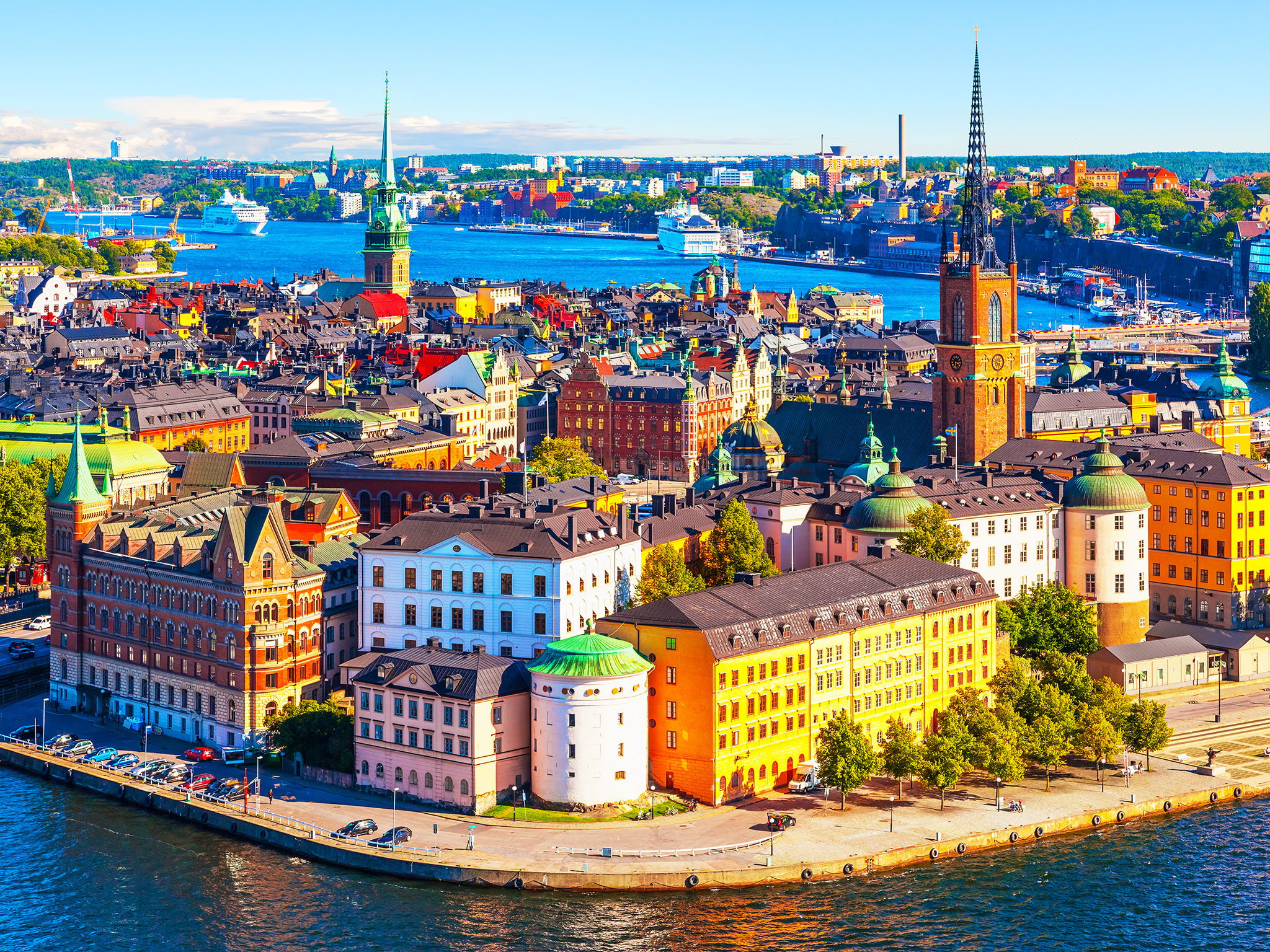
Stockholm  [stɔkːɔlm]?/i (vom altschwedischen stokker, entsprechend schwedisch stock „Baumstamm, Warenbestand“ und holmber, schwedisch holme „kleine Insel“) ist die Hauptstadt Schwedens und mit 935.619 (Gemeinde Stockholm), 1,4 Millionen (tätort[2] Stockholm) beziehungsweise 2,1 Millionen Einwohnern (Groß-Stockholm) die größte Stadt in Skandinavien.[1][3] Sie hat eine mehr als sieben Jahrhunderte zurückreichende Besiedlungsgeschichte und ist seit 1643 die Residenz des Königs.
[stɔkːɔlm]?/i (vom altschwedischen stokker, entsprechend schwedisch stock „Baumstamm, Warenbestand“ und holmber, schwedisch holme „kleine Insel“) ist die Hauptstadt Schwedens und mit 935.619 (Gemeinde Stockholm), 1,4 Millionen (tätort[2] Stockholm) beziehungsweise 2,1 Millionen Einwohnern (Groß-Stockholm) die größte Stadt in Skandinavien.[1][3] Sie hat eine mehr als sieben Jahrhunderte zurückreichende Besiedlungsgeschichte und ist seit 1643 die Residenz des Königs.
Die Stadt ist sowohl Sitz des schwedischen Parlamentes als auch der schwedischen Regierung. Sie ist ebenso das kulturelle Zentrum des Landes und Bischofssitz.
Stockholm ist eine der nördlichsten Hauptstädte der Welt und auch eine der Spannendsten. Traditionell und auch offen für alles Neue, so präsentiert sich die Stadt mit ihrem historischen Bauten und der modernen Architektur. Die Stockholmer selbst sind tief verwurzelt mit ihrem Land, gleichzeitig unendlich gastfreundlich und charmant. Nicht umsonst ist Stockholm die Heimatstadt des Nobelpreises. Wissenschaft, Kunst und Kultur werden in der Stadt an den Schären groß geschrieben. 100 Kunstgalerien und 70 Museen-davon können sich die Stockholm-Besucher überzeugen. Das musikalische Angebot ist vor allem im Sommer in den vielen Parkanlagen gigantisch. Rasante Feste werden über das ganze Jahr veranstaltet. Aber die
Dienerrennen, die Walpurgisnacht, der Stockholm-Marathon oder das Mit-Sommerfest: In Schwedens Hauptstadt gibt es immer einen Grund zum Feiern. Die Monarchie ist in Stockholm allgegenwärtig.(Quelle: http://www.mytraveltips.de/schweden/stockholm/)
斯德哥尔摩(瑞典语:Stockholm, 发音 帮助·信息,当地华人有时称其为斯京),瑞典首都及最大城市,亦是斯德哥尔摩省首府。瑞典王国政府、国会以及瑞典王室的官方宫殿都设在斯德哥尔摩。它位于瑞典的东海岸,濒波罗的海,梅拉伦湖入海处,风景秀丽,是著名的旅游胜地。市区分布在14座岛屿和一个半岛上,70余座桥梁将这些岛屿联为一体,因此享有“北方威尼斯”的美誉。斯德哥尔摩市区为大斯德哥尔摩的一部分。
发音 帮助·信息,当地华人有时称其为斯京),瑞典首都及最大城市,亦是斯德哥尔摩省首府。瑞典王国政府、国会以及瑞典王室的官方宫殿都设在斯德哥尔摩。它位于瑞典的东海岸,濒波罗的海,梅拉伦湖入海处,风景秀丽,是著名的旅游胜地。市区分布在14座岛屿和一个半岛上,70余座桥梁将这些岛屿联为一体,因此享有“北方威尼斯”的美誉。斯德哥尔摩市区为大斯德哥尔摩的一部分。
从13世纪起,斯德哥尔摩就已经成为瑞典的政治、文化、经济和交通中心。斯德哥尔摩由于免受战争的破坏而保存良好,现在共有100多座博物馆和名胜,包括历史、民族、自然、美术等各个方面。斯德哥尔摩也是一个高科技的城市,拥有众多大学,工业发达。
斯德哥尔摩是阿尔弗雷德·诺贝尔的故乡。从1901年开始,每年12月10日诺贝尔逝世纪念日,斯德哥尔摩音乐厅举行隆重仪式,瑞典国王亲自给获诺贝尔奖者授奖,并在市政厅举行晚宴。
斯德哥尔摩(Stockholm),是瑞典的首都和第一大城市,瑞典政治、经济、文化、交通中心和主要港口,也是瑞典国家政府、国会以及皇室的官方宫殿都所在地,世界著名的国际大都市。
斯德哥尔摩位于瑞典的东海岸,濒波罗的海,梅拉伦湖入海处,风景秀丽,是著名的旅游胜地。市区分布在14座岛屿和一个半岛上,70余座桥梁将这些岛屿联为一体,因此享有“北方威尼斯”的美誉。斯德哥尔摩市区为大斯德哥尔摩的一部分。
斯德哥尔摩城市名称直译过来为木头岛,建于13世纪,1436年起斯德哥尔摩就已经成为瑞典的政治、文化、经济和交通中心。
斯德哥尔摩由于免受战争的破坏而保存良好,现在共有100多座博物馆和名胜,包括历史、民族、自然、美术等各个方面。斯德哥尔摩也是一个高科技的城市,拥有众多大学,工业发达。斯德哥尔摩也是瑞典的金融中心,瑞典主要的银行的总部都在这里。
斯德哥尔摩是阿尔弗雷德·诺贝尔的故乡。从1901年开始,每年12月10日诺贝尔逝世纪念日,斯德哥尔摩音乐厅举行隆重仪式,瑞典国王亲自给获诺贝尔奖者授奖,并在市政厅举行晚宴。
Stockholm[a] is the capital of Sweden and the most populous city in the Nordic countries;[9][b] 952,058 people live in the municipality,[10] approximately 1.5 million in the urban area,[5] and 2.3 million in the metropolitan area.[11] The city stretches across fourteen islands where Lake Mälaren flows into the Baltic Sea. Just outside the city and along the coast is the island chain of the Stockholm archipelago. The area has been settled since the Stone Age, in the 6th millennium BC, and was founded as a city in 1252 by Swedish statesman Birger Jarl. It is also the capital of Stockholm County. Stockholm is the only capital in the world with a national urban park.[12]
Stockholm is the cultural, media, political, and economic centre of Sweden. The Stockholm region alone accounts for over a third of the country's GDP,[13] and is among the top 10 regions in Europe by GDP per capita.[14] It is an important global city,[15][16] and the main centre for corporate headquarters in the Nordic region.[17] The city is home to some of Europe's top ranking universities, such as the Stockholm School of Economics, Karolinska Institute and Royal Institute of Technology (KTH).[18][19] It hosts the annual Nobel Prize ceremonies and banquet at the Stockholm Concert Hall and Stockholm City Hall. One of the city's most prized museums, the Vasa Museum, is the most visited non-art museum in Scandinavia.[20][21] The Stockholm metro, opened in 1950, is well known for the decor of its stations; it has been called the longest art gallery in the world.[22][23][24] Sweden's national football arena is located north of the city centre, in Solna. Ericsson Globe, the national indoor arena, is in the southern part of the city. The city was the host of the 1912 Summer Olympics, and hosted the equestrian portion of the 1956 Summer Olympics otherwise held in Melbourne, Victoria, Australia.
Stockholm is the seat of the Swedish government and most of its agencies,[25] including the highest courts in the judiciary,[26][27] and the official residencies of the Swedish monarch and the Prime Minister. The government has its seat in the Rosenbad building, the Riksdag (Swedish parliament) is seated in the Parliament House, and the Prime Minister's residence is adjacent at the Sager House.[28][29][30] The Stockholm Palace is the official residence and principal workplace of the Swedish monarch, while the Drottningholm Palace, a World Heritage Site on the outskirts of Stockholm, serves as the Royal Family's private residence.[31][32]
Stockholm (prononcé en suédois [²stɔkː(h)ɔlm] Écouter) est la capitale et la plus grande ville de Suède. Elle est le siège du gouvernement et du parlement suédois ainsi que le lieu de résidence officielle du roi Carl XVI Gustav.
La ville de Stockholm (Stockholms stad) ou, plus officiellement, la commune de Stockholm (Stockholms kommun) est, avec ses 1 538 517 habitants1, la plus grande des 290 municipalités suédoises. Le Grand Stockholm, qui couvre la majeure partie du Comté de Stockholm, a, lui, une population de 2 063 945 habitants1 sur une superficie de près de 6 600 km2.
Située au bord de la mer Baltique, la ville est construite en partie sur plusieurs îles, à l'embouchure du lac Mälar, ce qui lui a valu, à l'instar d'autres cités européennes, son surnom de Venise du Nord (par ailleurs aussi donné à Bruges (Belgique), à Saint-Pétersbourg (Russie), et à Amsterdam (Pays-Bas).
Stoccolma (AFI: /stokˈkolma/[2]; in svedese Stockholm, pronunciato ascolta[?·info] [ˈstɔkːˈhɔlm, ˈstɔkːˈɔlm, ˈstɔkːɔlm];[3] 952.058 ab.)[4] è la capitale della Svezia, capoluogo della contea di Stoccolma. Posta nella parte orientale del paese, sul mar Baltico, è sede di governo e parlamento, oltre che luogo di residenza del capo dello stato, il re Carlo Gustavo XVI. Maggiore città della Svezia e della Scandinavia, è il centro di riferimento economico e culturale della Svezia.
Anche l'area metropolitana (Storstockholm) è la più grande della nazione, contando 2.213.528 abitanti.[4][5] Amministrativamente la città è divisa in 26 comuni. Il centro e la gran parte dei sobborghi ad esso più vicini sono compresi nel comune di Stoccolma.
Estocolmo ( [stɔkːɔlm] (?·i) en sueco, Stockholm) es la capital y ciudad más grande de Suecia.
[stɔkːɔlm] (?·i) en sueco, Stockholm) es la capital y ciudad más grande de Suecia.
La ciudad de Estocolmo es administrativamente un municipio de la provincia homónima, incluye el área metropolitana. Estocolmo ha sido nombrada por la GaWC como una ciudad global de «clase alfa»1 en el índice global de las ciudades 2008, ocupa el puesto 24 en el mundo, el número 8 en Europa y el número 1 de toda Escandinavia.
Estocolmo es a menudo conocida por su belleza, sus edificios y arquitectura, su agua limpia y abierta y sus numerosos parques, jardines y canales. Forma parte del grupo de ciudades conocidas vulgarmente como las «Venecias del Norte». Como capital del Estado, Estocolmo es la sede del Gobierno, el Parlamento (Riksdag), el Tribunal Supremo de Justicia (Hōgsta Domstolen). Alberga también el Palacio de Drottningholm, residencia oficial y despacho del jefe de Estado, el rey Carlos XVI Gustavo de Suecia. La ciudad fue premiada con el título Capital Verde Europea 2010.
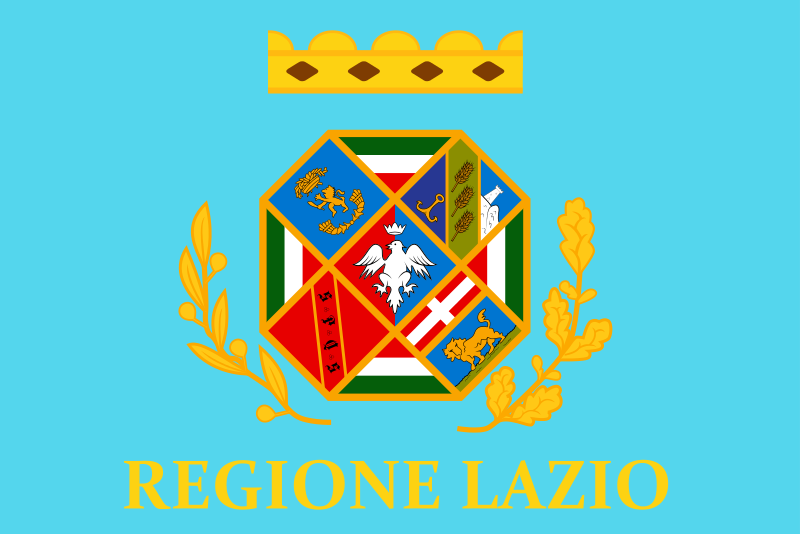 拉齐奥大区
拉齐奥大区

 音乐
音乐